Porsche 911 (996) and Boxster (986)
Production years 1997 - 2004
1997 to 2004 model Porsche 911 and Boxsters have two original audio systems.
The earlier cars had a system similar to an Audi, the speakers are amplified and the head unit suppliers the audio to the amplifier via a low level signal from the Mini ISO connector. These cars require high to low level adapters to fit new head units or handsfree kits.
Later models use a fibre optic network to send the audio signal from the head unit to the amplifier. For these cars we have the 23-245 fibre optic interface available.
Generally the CD22/CDR22 original units have the Audi style system, CDR23 units can be either low level like the Audis or fibre optic. It is best to either find the amplifier under the front bonnet and look for fibre optic cables, or remove the head unit and look at the connection on the back.
Here is a picture of a car using a low level signal in the Mini ISO yellow connector to connect to the amplifier, note that all six positions are populated. These wires are the positive audio signals for front left, front right, rear left and rear right speakers, a common speaker negative and the amplifier turn on signal. Models with this set up will need to use the 20-281 amplifier interface.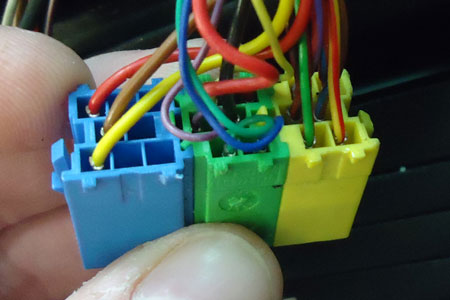 .
.
Here is a picture of a head unit using the fibre optic connection. Note that there are only four wires in the yellow Mini ISO, unlike six in the older version. These four wires are data wires, they do not carry any audio signal. Models with this fibre optic system require our 23-245 fibre optic amplifier interface to work. This not only connects to the amplifier but provides a switched live direct from the fuse box.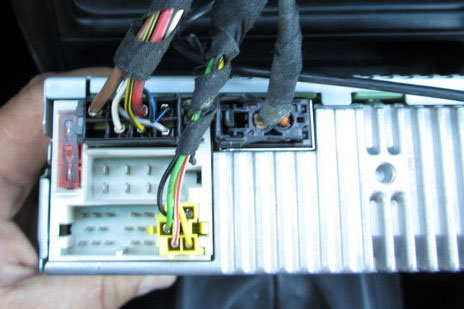
There are some cars with the very basic audio option, these have a traditional speaker ISO connector with the head unit driving the speakers directly. No audio adapters are needed for these cars.
The Porsche 911 cars have a variety of amplified audio options, depending on what is in the car affects what fitting parts are required when installing a new stereo.
The information below describes the different original audio equipment that is in these cars, this information is needed to make sure the correct parts are used when fitting a new stereo.
2004 - 2009 models
Unlike the Boxster and Cayman, the 911 cars were all fitted with the high end PCM2 and 2.1 head units. These units have ISO connectors at the rear.
There are two types of audio systems in 911s, ASK amplifier, known as the Sound Package Plus system (SPP) and Bose premium amplifier. The ASK amplifier has audio supplied to it from the head unit from the normal speaker ISO connector, a +12v feed turns on the amplifier. The Bose amplifier has a fibre optic connection from the head unit.
The image below shows the connection at the radio for cars with the ASK and Bose amplifiers.
The left image is a car with an ASK amplifier, all 4 channels are populated in the speaker ISO and there is an amplifier turn on wire (thin black with red stripe) in the power ISO connector. The image to the right has a Bose amplifier, there are no speaker wires present, the audio is sent to the amplifier via the orange fibre optic cables. Note: the car with the ASK amplifier also has fibre optic cables, these connect the head unit to the CD changer, they do not carry audio to the ASK amplifier.
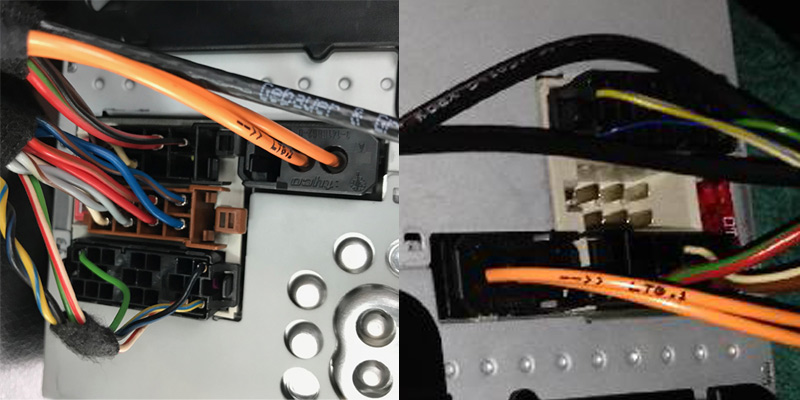
The type of amplifier can be identified by looking at the wiring behind the radio, as per above images, or by looking at the door speakers. Cars with Bose amplifiers will have Bose branding on the speaker grills. See the image below.
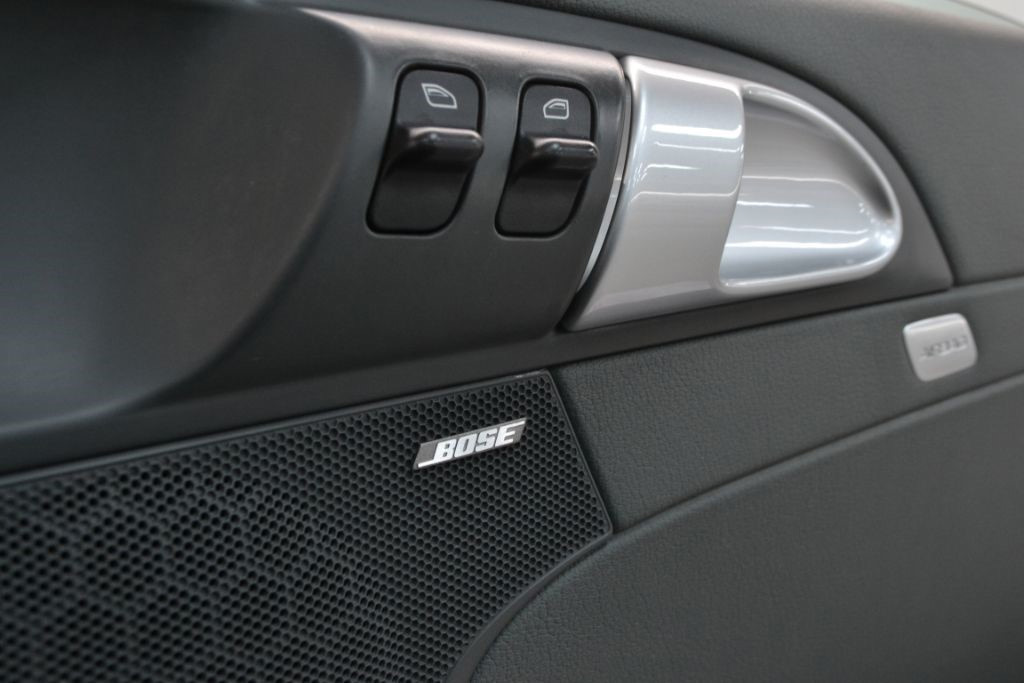
2009 - 2012 models
Like the earlier version 911, the 2009 to 2012 models are only fitted with the high end PCM 3 head units, the CDR30 unit is not an option like the Boxster and Cayman. The PCM3 units have a quadlock connector at the rear instead of ISO connectors like the earlier model. They have the same options of ASK and Bose amplified audio systems.
The type of amp can be identified in the same way as the earlier model, either by the Bose branding on the speakers grills or by looking at the connectors at the back of the radio.
Below shows a car with ASK amplifier (image 1) and a car with Bose amplifier (image 2). Note how the car with an ASK amplifier has speaker wires present in the quadlock connector and the car with Bose does not.

Porsche 911 997
Production years 2004 - 2012
2004 - 2009 models
Unlike the Boxster and Cayman, the 911 cars were all fitted with the high end PCM2 and 2.1 head units. These units have ISO connectors at the rear.
There are two types of audio systems in 911s, ASK amplifier known as the Sound Package Plus (SPP) and Bose amplifier. The ASK amplifier has audio supplied to it from the head unit from the normal speaker ISO connector, a +12v feed turns on the amplifier. The Bose amplifier has a fibre optic connection from the head unit.
The image below shows the connection at the radio for cars with the ASK and Bose amplifiers.
The left image is a car with an ASK amplifier, all 4 channels are populated in the speaker ISO and there is an amplifier turn on wire (thin black with red stripe) in the power ISO connector. The image to the right has a Bose amplifier, there are no speaker wires present, the audio is sent to the amplifier via the orange fibre optic cables. Note: the car with the ASK amplifier also has fibre optic cables, these connect the head unit to the CD changer, they do not carry audio to the ASK amplifier.

The type of amplifier can be identified by looking at the wiring behind the radio, as per above images, or by looking at the door speakers. Cars with Bose amplifiers will have Bose branding on the speaker grills. See the image below.

2009 - 2012 models
Like the earlier version 911, the 2009 to 2012 models are only fitted with the high end PCM 3 head units, the CDR30 unit is not an option like the Boxster and Cayman. The PCM3 units have a quadlock connector at the rear instead of ISO connectors like the earlier model. They have the same options of ASK and Bose amplified audio systems.
The type of amp can be identified in the same way as the earlier model, either by the Bose branding on the speakers grills or by looking at the connectors at the back of the radio.
Below shows a car with ASK amplifier (image 1) and a car with Bose amplifier (image 2). Note how the car with an ASK amplifier has speaker wires present in the quadlock connector and the car with Bose does not.

BMW 1 Series
E81 3 door hatchback, E82 2 door coupe, E87 5 door hatchback, E88 2 door convertible.
Production years 2004-2011
The BMW 1 series had a facelift to the dashboard in 2007, this facelift allowed for the possibility of fitting double DIN aftermarket head units.
Below shows the difference between the pre and post facelift dashboards.
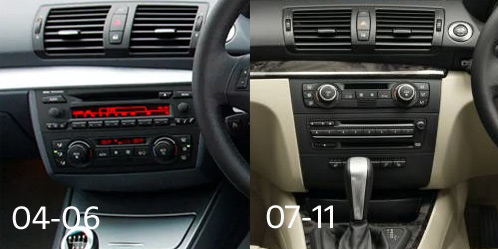
The Peugeot 108 is a city car launched by French manufacturer Peugeot in March 2014 and went on sale in the United Kingdom in July 2014. It is related to the Citroën C1 and Toyota Aygo, sharing the chassis, engines, transmission, and electrics.
It was reported in November 2018 that the Peugeot 108, along with the Citroën C1, will be phased out in 2021, with Toyota taking full ownership of the plant in the Czech Republic, and the model will not be renewed.
Maximum mounting Depth of 150mm
Due to the shallowness of the original radio the maximum mounting depth of an aftermarket 2-DIN radio needs to be 70mm/80mm including plug at the bottom.
On L-Shaped devices with 1-DIN body at the top the maximum installation depth is 100mm/150mm including plug.
The Alfa Romeo 147 (Type 937) is a small family car produced by Alfa Romeo from 2000 to 2010.
The 147 was facelifted at the end of 2004 with the addition of new front grills, headlights and an interior change on all models besides the GTA version.
The 147 was replaced by the Giulietta in May 2010.
No Double DIN solution is available.
No Double DIN solution is available.
No Double DIN solution is available.
No Double DIN solution is available.
No Double DIN solution is available.
No Double DIN solution is available.
No Double DIN solution is available.
BMW 3 Series E46
Production years 1999 - 2006
The E46 is the forth generation of the popular 3 series BMW car.
There are several options of original audio systems in these cars.
Basic Audio. The basic audio systems have a standard tape or CD player head unit in the dashboard. Some older models also have a basic small text screen based navigation display.
These basic setups will have a 17 way round pin connector at the back of the head unit.
Some cars with the basic head units will also have a Harman/Kardon amplifier.
Basic with Harman/Kardon. The Harman/Kardon amplifiers are turned on by a 12v switch signal. The head unit sends the audio to the amplifier via a low level (pre amplified) signal.
Fitting new head units or handsfree kits will require high to low level audio adapters.
Navigation screen head unit. Cars with original navigation screens have the radio tuner module in the rear of the car, it is behind the left hand panel in the boot. There are two types of tuners, one has the 17 way round pin connector and the other has the 40 way quadlock connector.
It is a 10-15 minute job to remove the panel in the boot and locate and identify which type of tuner is in the car. Pictures of the units are below.
Navigation and round pin tuner. The cars with round pin tuners work on the same basis as the cars with the basic head unit and basic head unit with Harman/Kardon. The main difference is that the tuner unit and round pin connection is in the boot so extensions from rear to front are required.
Image of the round pin tuner module. BM23.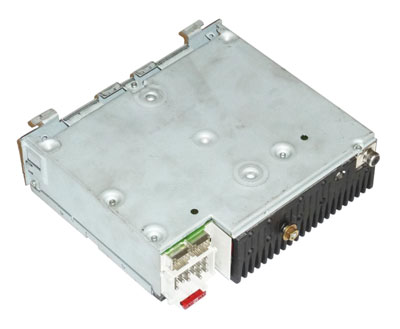
Navigation and quadlock tuners. Like cars with the round pin tuners, cars with the quadlock tuners will require extensions from rear to front with the appropriate connectors.
Cars that have the quadlock tuners and Harman/Kardon amplifiers are more complicated. The amplifiers are digital (DSP) and therefore need to be bypassed in order to install a new after market head unit. The same wiring and extension leads are required but no audio will be supplied to the speakers using these parts.
Image of the quadlock tuner module. BM54.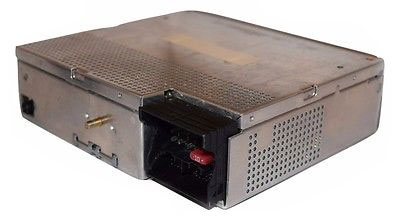
F30 Entertainment and Communication
The speaker systems in thee F30 are available in 3 different specification levels:
Base (Stereo) – the lowest-level BMW sound system, unavailable in the US and Canada. It consists of 6 speakers (4x Midrange, 2x Underseat Subwoofer) which are powered by the iDrive head unit with no additional BMW amplifier.
Hi-Fi – an option one level above the Base system. Hi-Fi has 9 speakers (5x Midrange, 3x Tweeter, 2x Hi-Fi Underseat Woofer) and an 8-channel amplifier with digital equalising. Only 7 of the 8 channels are used
Harman Kardon (S688A) – the top-tier BMW audio system available in the 3-Series. It contains 16 Harman Kardon BMW speakers (7x Midrange, 7x Tweeter, 2x Harman Kardon Underseat Woofer) and a 10-channel amplifier connected to the head unit with fiber optic cable. (NOTE: The Top HiFi system has a digital 10-channel amplifier. However, only 9 of the 10 channels are used.)
Base/ Basic Audio
This is the lowest-level BMW sound system, unavailable in the US and Canada. It consists of 6 speakers (4x Midrange, 2x Underseat Subwoofers) which are powered by the iDrive head unit with no additional BMW amplifier.
HiFi Sound Systems
This is an option one level above the Base system. This consists of 9 speakers and a seven-channel amplifier integrated into the loudspeaker system. The amplifier has no MOST bus connection and instead receives the switch-on signal via a separate line. Seperate speakers are installed in the HiFi system for the treble and mid-tone ranges.
The HiFi system also has a mid-range speaker positioned as a centre speaker.
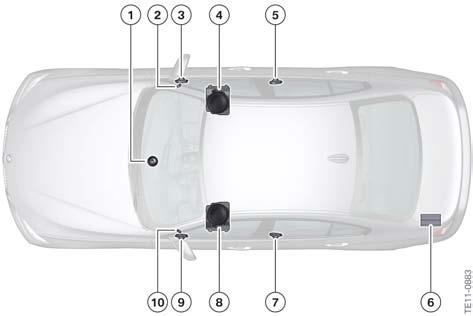
Top HiFi (Harman Kardon) and 'MOST' Sound Systems
This is the top tier BMW sound system. It consists of 16 speakers in total, with a 9-channel amplifier incorporated into the Sound system. The AMP is a bus connection in Media Orientated System Transport (MOST)
The speaker panels are usually labelled with the 'Harman Kardon' lettering. For e.g. in the mirror triangles where the tweeters are stored (See Below)
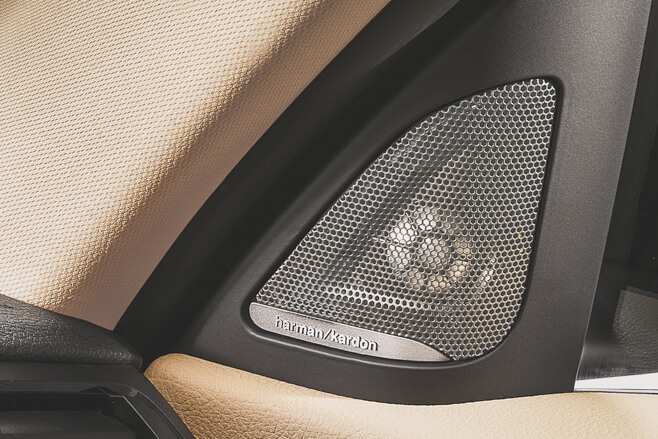
Speaker panels labelled with the 'Harman Kardon' lettering, a tale-tale sign of a Top HiFi (MOST) system
The Top HiFi sound system is equipped with a load logic separator in the F30, meaning the amplifier electronics are supplied with a separate voltage line.
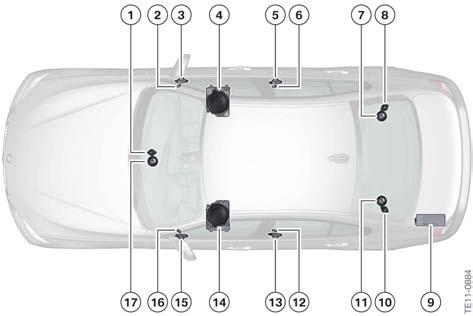
The seventh generation of the BMW 3 Series range consists of the BMW G20 (sedan version) and BMW G21 (wagon version, marketed as 'Touring') compact executive cars. The G20/G21 has been in production since mid-October of 2018 and is often collectively referred to as the G20.
ABOUT BMW ID7/ MGU (MEDIA GRAPHIC UNIT)
BMW ID7 or MGU (Media Graphic Unit) is the 7th Generation of the BMW iDrive Systems. Introduced in 2018 with the X5 (G05) and 8-Series (G15) , The display and menus were adapted to the new system implementing a new iDrive interface (ID7). It consists of 5 widgets arranged on the left side of the screen. The interface is designed mostly for touch and gesture operation.
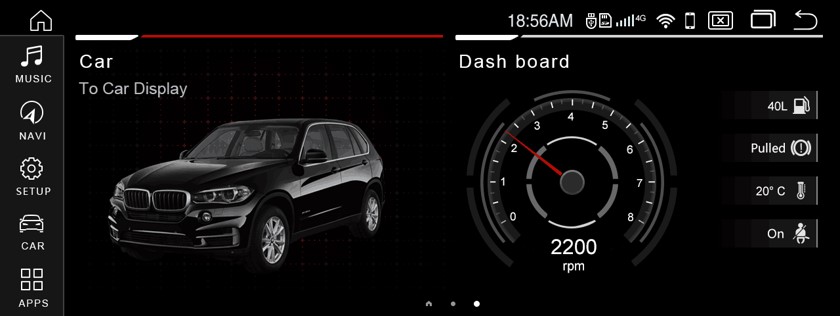
The ID7 Interface Setup consists of 5 widgets arranged on the left side of the screen (Pictured Above)
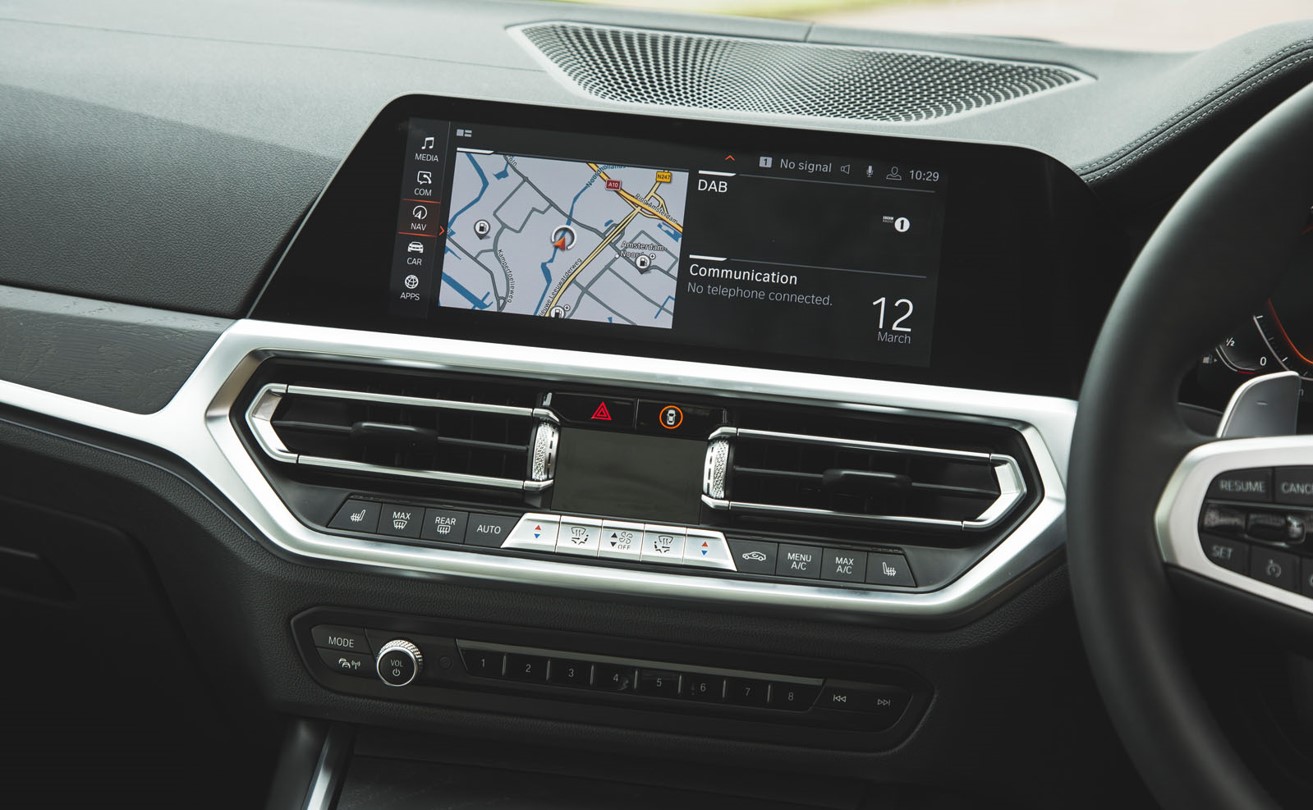
The ID7 features a screen of 10.25" or 12.3" diagonal, depending on the vehicle, and a redesigned iDrive Touch Controller.
Compatibility
The BMW ID7 or MGU (Media Graphic Unit) were introduced into the following BMW models
| 3-Series (G20) | 09/2018 - Present | ||
| 7-Series (G11/G12 Facelift) | 2020 - Present | ||
| 8-Series (G14/G15) | 09/2018 - Present | ||
| X3 (G01) | 2020 - Present | ||
| X5 (G05) | 09/2018 - Present | ||
| X7 (G07) | 2018 - Present | ||
| Z4 (G29) | 09/2018 - Present |
Nissan 350Z
Production years 2003 - 2010
The Nissan 350Z have a facelift in 2006 which affects the radio fascia. It is a very minor difference in the fascias needed from the pre facelift to post facelift models.
The easiest way to tell if the car is the older or newer model is to look at the styling around the gear stick and the location of the hazard switch.
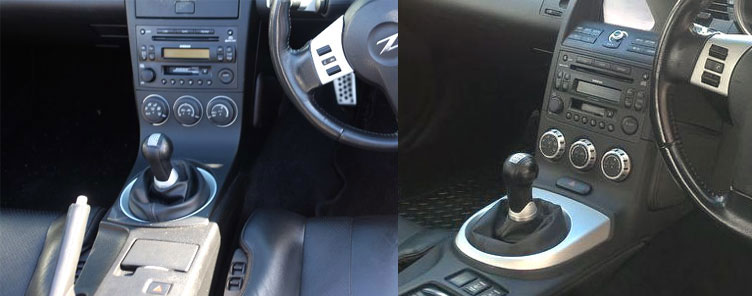
In the picture above you can see the different styling around the gear stick and the position change of the hazard switch.
The left image is of the 2003 - 2006 model, the hazard switch is positioned further back near the handbrake, the 2006 - 2010 model on the right has the hazard switch further forward on the dashboard located between the gear stick and below the climate controls.
Bose integration.
Most 350Z cars have factory fitted Bose audio systems. New equipment like head units and handsfree kits can be easily added to this system using high to low level adapters. The original head unit supplies the audio to the amplifier via a low level signal.
When fitting a new head unit, sometimes the audio sounds quieter than expected, this is normally caused by the new head unit having 2V preouts. Head units with 4V preouts will provide better audio. Another way to get better audio is to use an adapter lead for a non amplified car, use the ISO speaker outputs from the head unit and run the audio through a high to low level interface, this will give the best audio quality.
The Bose amplifier is turned on by a 12V switch signal.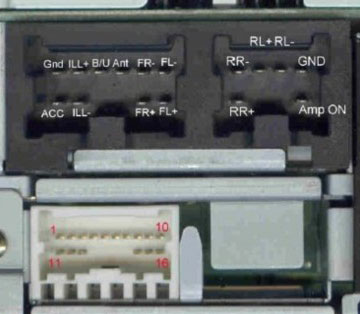
This diagram shows the position of the amplifier turn on (AMP ON) pin. Use the 12V switch output from the new head unit (blue/white wire) to turn the amp on.
4 Series F32 Entertainment and Communication
The speaker systems in the F32 are available in 3 different specification levels:
Base (Stereo) – the lowest-level BMW sound system, unavailable in the US and Canada. It consists of 6 speakers (4x Midrange, 2x Underseat Subwoofer) which are powered by the iDrive head unit with no additional BMW amplifier.
Hi-Fi – an option one level above the Base system. Hi-Fi has 9 speakers (5x Midrange, 3x Tweeter, 2x Hi-Fi Underseat Woofer) and an 8-channel amplifier with digital equalising. Only 7 of the 8 channels are used
Harman Kardon – the top-tier BMW audio system available in the 3-Series. It contains 16 Harman Kardon BMW speakers (7x Midrange, 7x Tweeter, 2x Harman Kardon Underseat Woofer) and a 10-channel amplifier connected to the head unit with fiber optic cable. (NOTE: The Top HiFi system has a digital 10-channel amplifier. However, only 9 of the 10 channels are used.)
Base/ Basic Audio
This is the lowest-level BMW sound system, unavailable in the US and Canada. It consists of 6 speakers (4x Midrange, 2x Underseat Subwoofers) which are powered by the iDrive head unit with no additional BMW amplifier.
HiFi Sound Systems
This is an option one level above the Base system. This consists of 9 speakers and a seven-channel amplifier integrated into the loudspeaker system. The amplifier has no MOST bus connection and instead receives the switch-on signal via a separate line. Seperate speakers are installed in the HiFi system for the treble and mid-tone ranges.
The HiFi system also has a mid-range speaker positioned as a centre speaker.

Top HiFi (Harman Kardon) and 'MOST' Sound Systems
This is the top tier BMW sound system. It consists of 16 speakers in total, with a 9-channel amplifier incorporated into the Sound system. The AMP is a bus connection in Media Orientated System Transport (MOST)
The speaker panels are usually labelled with the 'Harman Kardon' lettering. For e.g. in the mirror triangles where the tweeters are stored (See Below)

Speaker panels labelled with the 'Harman Kardon' lettering, a tale-tale sign of a Top HiFi (MOST) system
The Top HiFi sound system is equipped with a load logic separator in the F32, meaning the amplifier electronics are supplied with a separate voltage line.

Released in 2013, the Alfa Romeo 4C came with a standard Parrot radio in a single DIN slot with standardised ISO connections and a DIN antenna connection. Later in the production run in 2016, the radio was changed to an Alpine unit in the same single DIN slot and utilising the same connections, No ISO adapter or antenna is needed when fitting a radio with ISO connections, no matter what original radio is fitted.
it is not possible to fit an aftermarket head-unit to this car as the original screen contains vehicle information. No facia is available to change the radio.
You can add an aftermarket camera to the original screen , upgrade the speakers or add an amplifier and subwoofer.
The facelifted 7-Series BMW models were unveiled on 16 January 2019 as 2020 model year cars.
Updates to the interior include a new 12.3-inch instrument cluster and a 10.25-inch infotainment screen. A new voice assistant is also added to the infotainment system along with the BMW iDrive system 7.0 with updated graphics and menus.
BMW ID7 or MGU (Media Graphic Unit) is the 7th Generation of the BMW iDrive Systems. Introduced in 2018 with the X5 (G05) and 8-Series (G15) , The display and menus were adapted to the new system implementing a new iDrive interface (ID7). It consists of 5 widgets arranged on the left side of the screen. The interface is designed mostly for touch and gesture operation.

The ID7 Interface Setup consists of 5 widgets arranged on the left side of the screen (Pictured Above)

The ID7 features a screen of 10.25" or 12.3" diagonal, depending on the vehicle, and a redesigned iDrive Touch Controller.
Compatibility
The BMW ID7 or MGU (Media Graphic Unit) were introduced into the following BMW models
| 3-Series (G20) | 09/2018 - Present | ||
| 7-Series (G11/G12 Facelift) | 2020 - Present | ||
| 8-Series (G14/G15) | 09/2018 - Present | ||
| X3 (G01) | 2020 - Present | ||
| X5 (G05) | 09/2018 - Present | ||
| X7 (G07) | 2018 - Present | ||
| Z4 (G29) | 09/2018 - Present |
The second-generation of the BMW 8 Series consists of the BMW G14 (convertible version), BMW G15 (two-door coupe version) grand tourers and BMW G16 (four-door "Gran Coupe" fastback sedan version) executive car. The G14/G15/G16 generation has been in production since 2018, and is often collectively referred to as the G15.
The 8-Series iDrive system consists of the MGU hardware (Media Graphics Unit) running the 7th generation of iDrive called BMW Operating System 7.0.
BMW ID7 or MGU (Media Graphic Unit) is the 7th Generation of the BMW iDrive Systems. Introduced in 2018 with the X5 (G05) and 8-Series (G15) , The display and menus were adapted to the new system implementing a new iDrive interface (ID7). It consists of 5 widgets arranged on the left side of the screen. The interface is designed mostly for touch and gesture operation.

The ID7 Interface Setup consists of 5 widgets arranged on the left side of the screen (Pictured Above)

The ID7 features a screen of 10.25" or 12.3" diagonal, depending on the vehicle, and a redesigned iDrive Touch Controller.
Compatibility
The BMW ID7 or MGU (Media Graphic Unit) were introduced into the following BMW models
| 3-Series (G20) | 09/2018 - Present | ||
| 7-Series (G11/G12 Facelift) | 2020 - Present | ||
| 8-Series (G14/G15) | 09/2018 - Present | ||
| X3 (G01) | 2020 - Present | ||
| X5 (G05) | 09/2018 - Present | ||
| X7 (G07) | 2018 - Present | ||
| Z4 (G29) | 09/2018 - Present |
No Double DIN solution is available.
Identifying your Saab
The Saab 9-3 and Saab 9-5 were both sold through two generations. In the Saab community they are known as OG (original generation) and NG (new generation) and there are also differences between facelifts in these generations.
The easiest way to tell which version you have is to check the year and the front of the car as they are all distinctively different.
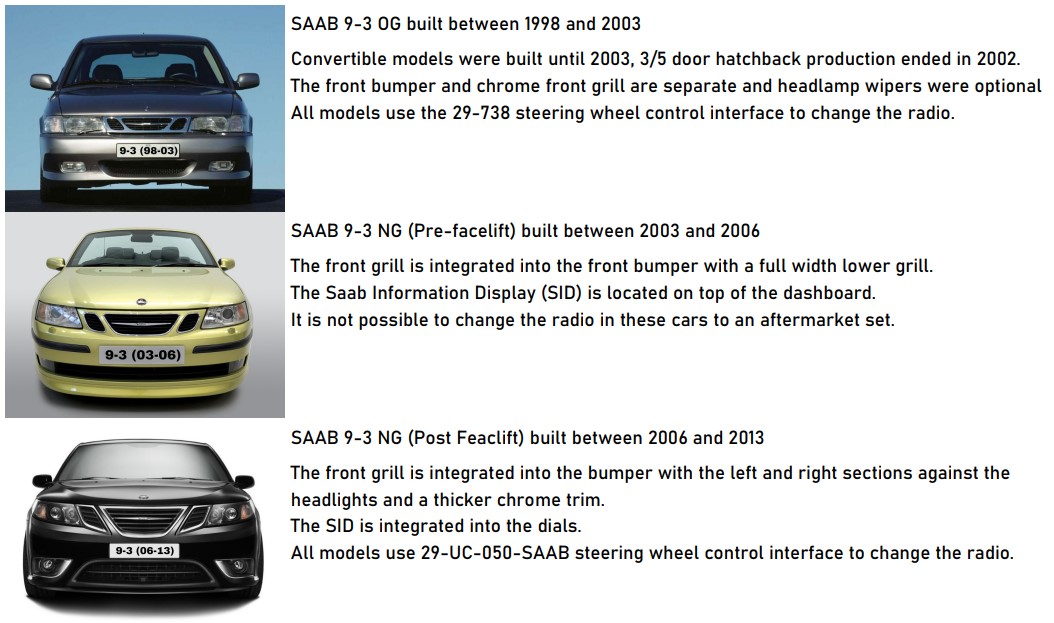
It is not reasonably practical to fit an after market radio to a pre-facelift Saab 9-3 due to the way that the original system works.
The radio seen at the top of the dashboard is just a user interface that is connected with a fibre optic loop to the EHU, amplifier and CD changer. Breaking the fibre optic loop by removing any one original component will disable the indicator and other warning chimes, making the car not road legal in the UK.
There is no fascia available and no fitting kit available to replace the radio in the Saab 9-3 built between 2003 - 2006. We do offer speaker upgrades for this car.
Below is an example of the radio that cannot be changed. This is the top-spec navigation radio, but they also came equipped with a mono-chrome screen or a basic radio with no screen.
Identifying your Saab
The Saab 9-3 and Saab 9-5 were both sold through two generations. In the Saab community they are known as OG (original generation) and NG (new generation) and there are also differences between facelifts in these generations.
The easiest way to tell which version you have is to check the year and the front of the car as they are all distinctively different.

Identifying your Saab
The Saab 9-3 and Saab 9-5 were both sold through two generations. In the Saab community they are known as OG (original generation) and NG (new generation) and there are also differences between facelifts in these generations.
The easiest way to tell which version you have is to check the year and the front of the car as they are all distinctively different.

The Saab 9-4X was the final new car put into production by Saab. Developed under general motors on the same platform as the Cadillac SRX. The first 9-4X rolled off the production line in February 2011, the same month the General Motors sold Saab to Spyker. Spyker continued to pay General Motors to continue building the Saab 9-4X on the Cadillac SRX production line in Mexico throughout 2011, but then with Saab being sold again to NEVS, General Motors halted production in December 2011 to avoid a modern platform being available to a Chinese competitor. The last cars were registered in 2012 with a grand total of 811 cars produced.
With such a short production run, there is no aftermarket solutions to change the radio on this car.
MAKE SURE YOU HAVE THE CORRECT INTERFACE
The Saab 9-5 OG (1997-2006) had a number of different configurations that affects how the steering wheel controls work. We have five different interfaces available to cover all versions. Please check the above compatibility table carefully to make sure you have the correct interface for your car. If you are unsure on your car then check overleaf.
Pay particular attention if you have a 9-5 built between 2006-2010 with an automatic gearbox as you may also have the optional paddle shift, most often found on Vector and Aero models. These require different interfaces to cars with manual or automatic gearboxes without paddle shift. The paddles are labelled - and +.
Earlier models are not affected by paddle shift, all cars built between May 2003 and October 2006 use the 29-643 interface.
2006-2010 cars with paddle shift have the paddles above the radio steering wheel controls, at the top of the spokes.
All post facelift 9-5s with the basic Fujitsu 10 original radio (with the black and green display) use interface 29-UC-050-SAAB.
All Saab 9-3 OG (1998-2003) models use the 29-738 interface.
| Interface | Car Description |
| 29-738 (SAB01) | Saab 9-3 (98-03) and Saab 9-5 (97-02) |
| 29-643 (SAB02) | Saab 9-5 (02-06) Facelift 1 |
| 29-694.V2 (SAB03) | Saab 9-5 (06-10) with Denso navigation and without paddle shift |
| 29-742 (SAB02) | Saab 9-5 (06-10) with Denso navigation and paddle gear shift |
| 29-UC-050-SAAB | Saab 9-5 (06-10) with basic Fujitsu 10 original radio and Saab 9-3 (06-13) |
Identifying your Saab
The Saab 9-3 and Saab 9-5 were both sold through two generations. In the Saab community they are known as OG (original generation) and NG (new generation) and there are also differences between facelifts in these generations.
The easiest way to tell which version you have is to check the year and the front of the car as they are all distinctively different.

MAKE SURE YOU HAVE THE CORRECT INTERFACE
The Saab 9-5 OG (1997-2006) had a number of different configurations that affects how the steering wheel controls work. We have five different interfaces available to cover all versions. Please check the above compatibility table carefully to make sure you have the correct interface for your car. If you are unsure on your car then check overleaf.
Pay particular attention if you have a 9-5 built between 2006-2010 with an automatic gearbox as you may also have the optional paddle shift, most often found on Vector and Aero models. These require different interfaces to cars with manual or automatic gearboxes without paddle shift. The paddles are labelled - and +.
Earlier models are not affected by paddle shift, all cars built between May 2003 and October 2006 use the 29-643 interface.
2006-2010 cars with paddle shift have the paddles above the radio steering wheel controls, at the top of the spokes.
All post facelift 9-5s with the basic Fujitsu 10 original radio (with the black and green display) use interface 29-UC-050-SAAB.
All Saab 9-3 OG (1998-2003) models use the 29-738 interface.
| Interface | Car Description |
| 29-738 (SAB01) | Saab 9-3 (98-03) and Saab 9-5 (97-02) |
| 29-643 (SAB02) | Saab 9-5 (02-06) Facelift 1 |
| 29-694.V2 (SAB03) | Saab 9-5 (06-10) with Denso navigation and without paddle shift |
| 29-742 (SAB02) | Saab 9-5 (06-10) with Denso navigation and paddle gear shift |
| 29-UC-050-SAAB | Saab 9-5 (06-10) with basic Fujitsu 10 original radio and Saab 9-3 (06-13) |
Identifying your Saab
The Saab 9-3 and Saab 9-5 were both sold through two generations. In the Saab community they are known as OG (original generation) and NG (new generation) and there are also differences between facelifts in these generations.
The easiest way to tell which version you have is to check the year and the front of the car as they are all distinctively different.

Do I have a CDR31 or PCM3.1 System?
The difference of having PCM 3.1 or CDR 3.1 is the buttons in the units centre console.
If your system has CD/ AUX button and AM/FM buttons then you have a CDR 3.1/ CDR31
If your system has NAVI/ MAP buttons and a SD Slot then you have a PCM 3.1
MERCEDES A CLASS (W176)
COMAND NTG 4.5 (2013-2015)
Comand NTG 4.5 features in the A-Class (W176) from 2013 until 2015, when it was succeeded by the NTG 5.1 Comand System. It consists of a 7 inch screen and a keypad on the main head unit.
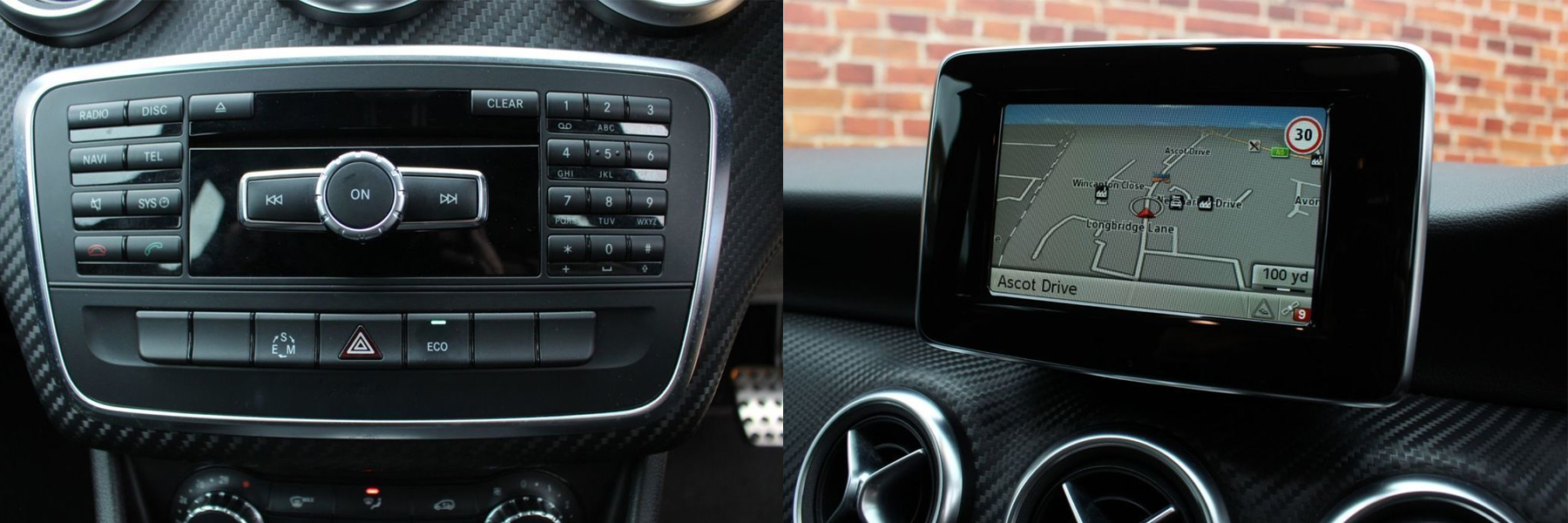
COMAND NTG 5.1 (2015 ONWARDS)
Comand NTG 5.1 is part of the Mercedes NTG 5 Comand series and features in the A-Class (W176) from 2015 onwards. It consists of a 8 inch screen and unlike newer NTG 5 versions still has a keypad on the main head unit.
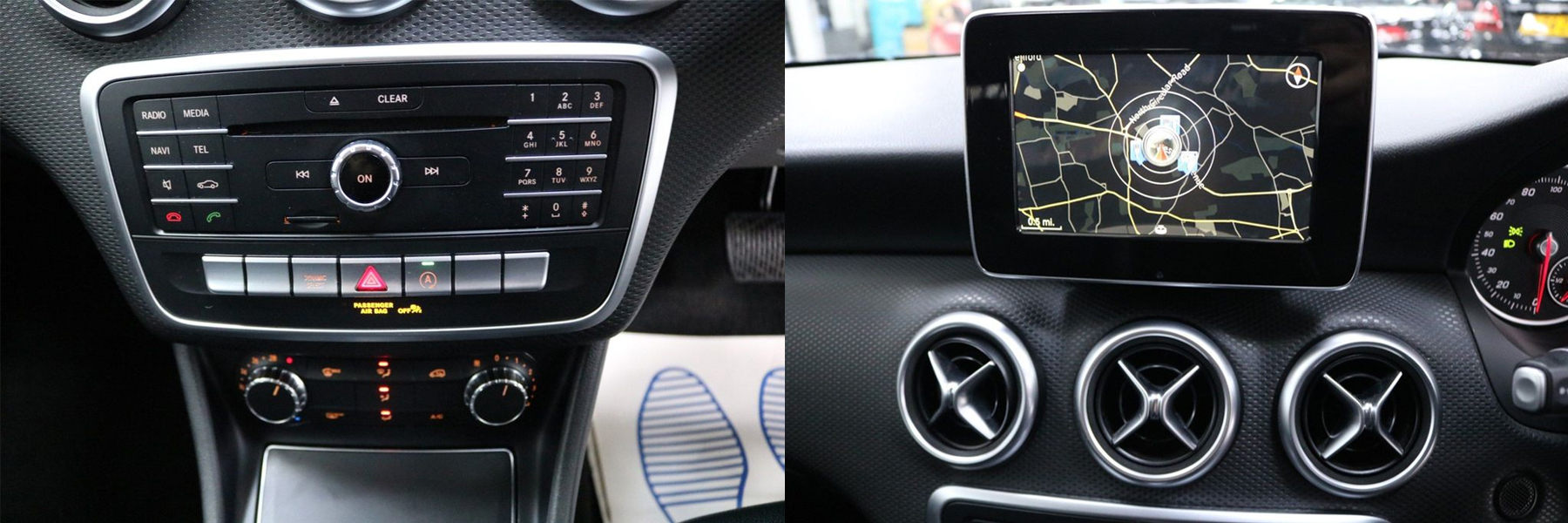
COMAND APS NTG 6 (MBUX)
The NTG 6 Comand head unit debuted in the A-Class (W177) 2018 onwards. This Comand unit features a new MBUX infotainment system which consists of a standard 7-inch touchscreen or a 10.25-inch as an optional extra. Other optional extras with the MBUX include voice control and a geocoded map system.
A-CLASS (7 INCH TOUCHSCREEN)
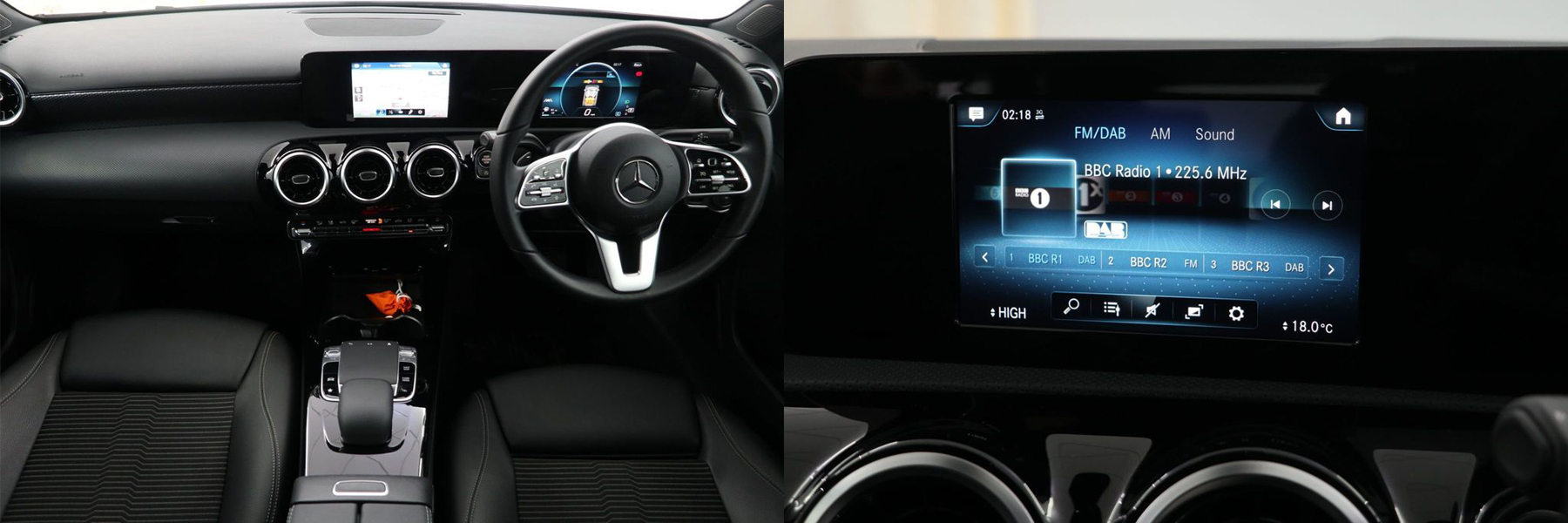
A-CLASS (10.25 INCH TOUCHSCREEN)
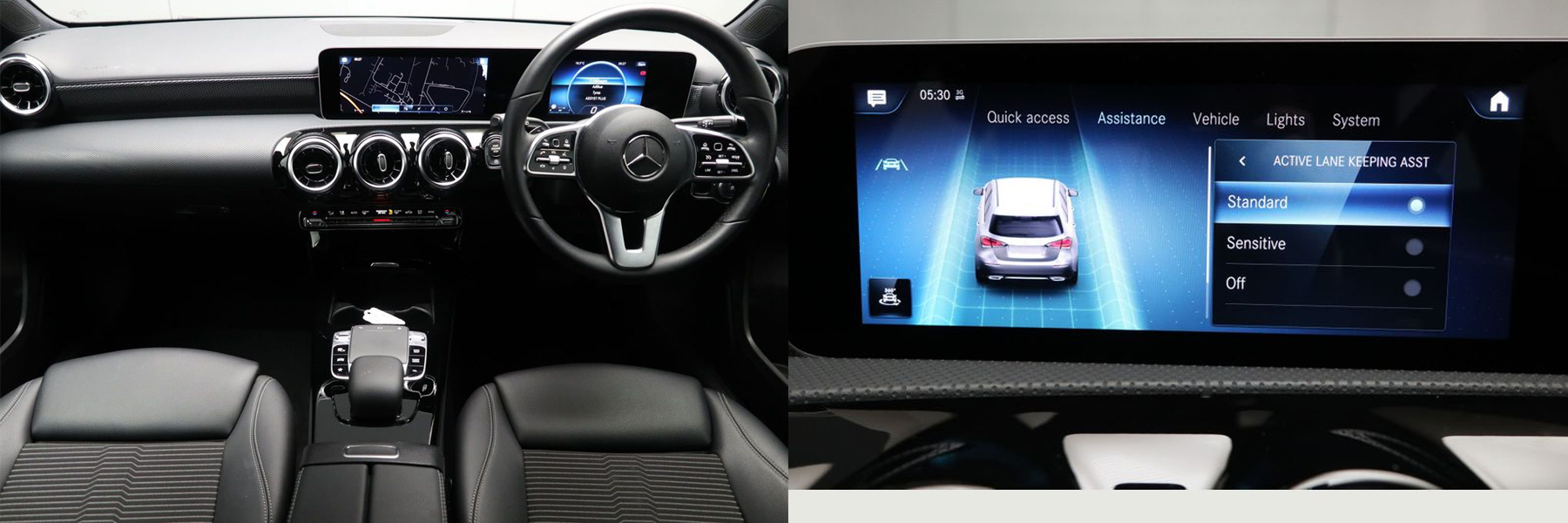
The second generation A1 was launched in mid-June 2018. It is built on the MQB platform which is shared with the Volkswagen Polo Mk6 and the SEAT Ibiza Mk5.
No Double DIN solution is available.
The original A3 (or Typ 8L) was introduced in the European market in 1996, marking Audi's return to the production of smaller cars following the demise of the Audi 50 in 1978. This was the first Volkswagen Groupmodel to use the "PQ34" or "A4" platform, bearing a close resemblance to the contemporary Volkswagen Golf Mk4, which arrived a year later. Within three years, this platform was used for total of seven cars.
The A3 was initially available only with a three-door hatchback body, to present a more sporty image than the Golf, in both front and four-wheel drive. The inline four-cylinder engines were transversely mounted. After the A4, the Audi A3 was the second model in the Audi lineup to use five valves per cylinder.
The United Kingdom market first received the Audi A3 in November 1996.
In 1999, Audi expanded the range with the introduction of more powerful versions: a 1.8 turbo rated 180 PS (132 kW; 178 hp), and a 1.9 TDI diesel engine with unit injector "Pumpe Düse" (PD) technology and variable geometry turbocharger. The four-wheel-drive A3 1.8T quattro used either the 150 PS (110 kW; 148 hp) or 180 PS (130 kW; 180 hp) engine, and the same Haldex Traction-based four-wheel-drive system as the Audi S3 and the Audi TT. Also in 1999, Audi also introduced a five-door body.
In late 2000, the A3 range was revised with new headlights and rear lamps, other minor cosmetic changes, an improved interior, and the introduction of a six-speed manual gearbox, on the 180 PS (132 kW; 178 hp) 1.8 Turbo and the new 130 PS (96 kW; 128 hp) 1.9 TDI.
Audi's electronic stability control, traction-control, and brake force distribution computer became standard equipment in some countries.
Although the first-generation Audi A3 was replaced in Europe in 2003, the first generation model continued to be sold in some markets. Production of the first generation model stopped in Brazil in 2006.
No Double DIN solution is available.
No Double DIN solution is available.
Audi A7 (4G8)
Production years 2010 - 2017
The Audi A7 was first released in 2010. There was an update to the car in 2012 and a further facelift in 2015 which included a new multimedia system.
Mid-2014 facelift (model year 2015)
Audi unveiled the 2015 A7 facelift in May 2014. Changes include:
Styling tweaks to the car's exterior, engine line-up, transmission
Latest Multi Media Interface modular infotainment platform (faster Nvidia Tegra 3 processor, improved graphics) including handwriting recognition.
Audi connect telematics with 4G mobile internet (and mobile updates for the navigation map)
Adaptive glare-free Matrix LED headlights.
Improved Night Vision Assistant can now recognize animals.
Both TFSI and all three TDI engines now meet the Euro 6 emission standard.
The second generation of the A7 was revealed in October 2017, officially launched in Germany in February 2018, and has been on sale in Europe since late 2017.
No Double DIN solution is available.
No Single or Double DIN solution is available.
The Suzuki Across is a rebadged Toyota RAV4, released in July 2020
The original radio of the Suzuki Acorss sits proud of the dashboard. Due to this design, only after market radios with either a lower single DIN chassis such as the Alpine ILX702D or a modular radio like the Pioneer SPH-EVO64DAB will fit in the dashboard. A full sized double DIN radio or upper single DIN chassis such as Sonys do not fit.
In September 2018, Mercedes Benz revealed the revised 2019 Actros at the IAA Commercial Vehicles Show in Hannover, Germany. The vehicle now has 2 colour displays (touchscreen and infotainment display behind the steering wheel) replacing the conventional instrument cluster on old Actros models and can be integrated with Android Auto or Apple CarPlay. Its outside mirrors were replaced with a camera and it can do semi-automated driving, using Active Drive Assist.
The Vauxhall Agila A is a rebadged version of the SUZUKI Wagon R
The Vauxhall Agila B is a rebadged Suzuki Splash
The first generation Toyota Alphard has two different styles of radio.
The smaller versions are the standard Toyota radio size and just needs a pair of side bars to fit a double DIN radio into the dashboard. These original radios have a variety of different looks but are all the same size, the lower edge of the radio roughly lines up with the lower edge of the air vents on either side
The larger version has original sat-nav and the lower edge sits below the air vents, roughly in line with the hazard switch. These require a much larger fascia to change.
The Vauxhall / Opel Astra K was launched in 2015 through to the 2021 model year and has been fitted with three different radios user interfaces. The actual radio is located in the right hand footwell and requires fakra extensions when fitting a new radio in the space where the original screen was. Due to the limited space in the dashboard a new radio can only have a maximum depth of 70mm and modification to the structure behind the dashboard will be required.
The first is the Opel CD30MP3 which is a rare base spec option. We have so far only found this radio on left hand drive models.
When replacing this radio, the hazard switch should be removed and fitted to the new radio fascia.
The most common options are the Intellilink systems.
Intellilink R4.0 has a 7" screen and when changed a new hazard switch will need to be purchased from your local Vauxhall / Opel dealer with part number 13476059, this will fit into the new fascia but a new harness to connect it to the original wiring for the hazard switch will need to be fabricated.
The final option is the Intellilink Navi 900 with an 8" screen.
We don't currently have a solution to change this radio.
Between 2016 and 2020 the Astra K was sold in Australia and New Zealand as the Holden Astra BK. The hatchback is the same as the Opel / Vauxhall Astra K whereas the Holden Astra sedan (BL) is based off the GM Korea Chevrolet Cruze and has a completely different radio called Mylink which needs different parts to change the radio compared to the BK hatchback.
Unlike its Hatchback sibling, the Holden Astra Sedan (code BL) was not based on the European Opel / Vauxhall Astra and was actually based on the GM Korea Chevrolet Cruze with new bumpers and lights to look more like the hatchback.
The radios on the two cars are different, and require different parts to fit. See below for a picture of the "Mylink" radio fitted to the Astra BL Sedan.
The Vauxhall / Opel Astra K was launched in 2015 through to the 2021 model year and has been fitted with three different radios user interfaces. The actual radio is located in the right hand footwell and requires fakra extensions when fitting a new radio in the space where the original screen was. Due to the limited space in the dashboard a new radio can only have a maximum depth of 70mm and modification to the structure behind the dashboard will be required.
The first is the Opel CD30MP3 which is a rare base spec option. We have so far only found this radio on left hand drive models.
When replacing this radio, the hazard switch should be removed and fitted to the new radio fascia.
The most common options are the Intellilink systems.
Intellilink R4.0 has a 7" screen and when changed a new hazard switch will need to be purchased from your local Vauxhall / Opel dealer with part number 13476059, this will fit into the new fascia but a new harness to connect it to the original wiring for the hazard switch will need to be fabricated.
The final option is the Intellilink Navi 900 with an 8" screen.
We don't currently have a solution to change this radio.
Between 2016 and 2020 the Astra K was sold in Australia and New Zealand as the Holden Astra BK. The hatchback is the same as the Opel / Vauxhall Astra K whereas the Holden Astra sedan (BL) is based off the GM Korea Chevrolet Cruze and has a completely different radio called Mylink which needs different parts to change the radio compared to the BK hatchback.
Maximum mounting Depth of 150mm
Due to the shallowness of the original radio the maximum mounting depth of an aftermarket 2-DIN radio needs to be 70mm/80mm including plug at the bottom.
On L-Shaped devices with 1-DIN body at the top the maximum installation depth is 100mm/150mm including plug.
MERCEDES B CLASS (W176)
COMAND NTG 4.5 (2012-2015)
Comand NTG 4.5 features in the B-Class (W246) from 2012 until 2015, when it was succeeded by the NTG 5.1 Comand System. It consists of a 7 inch screen and a keypad on the main head unit.
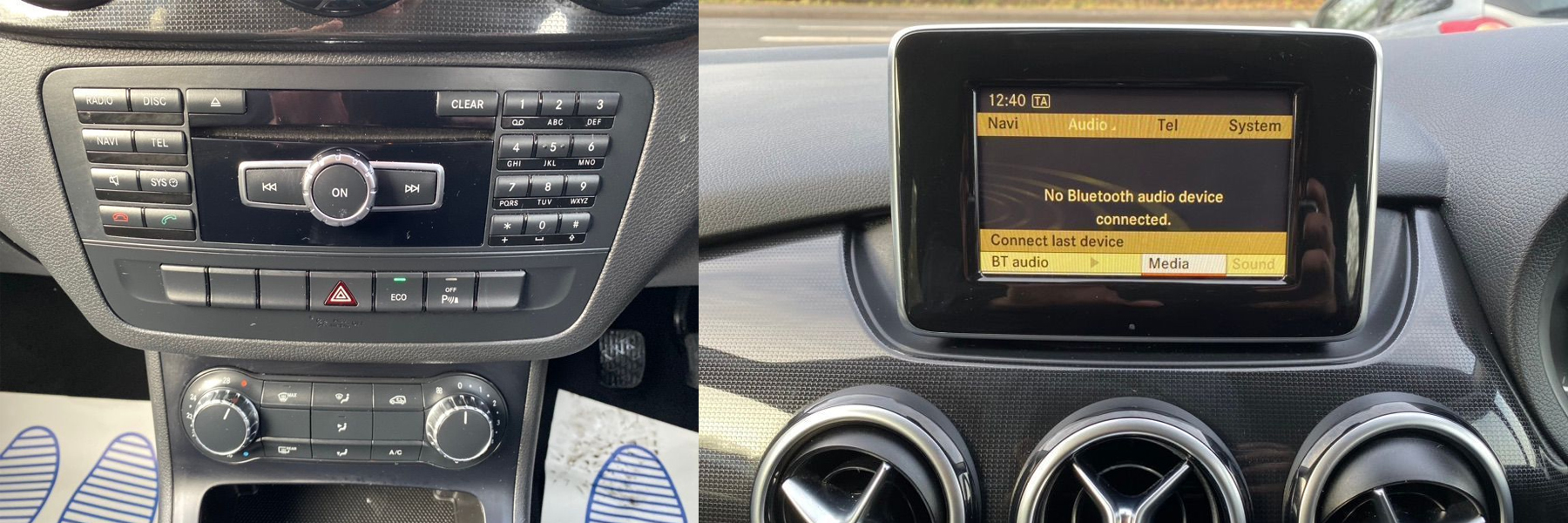
COMAND NTG 5.1 (2015 ONWARDS)
Comand NTG 5.1 is part of the Mercedes NTG 5 Comand series and features in the B-Class (W246) from 2015 onwards. It consists of a 8 inch screen and unlike newer NTG 5 versions still has a keypad on the main head unit.
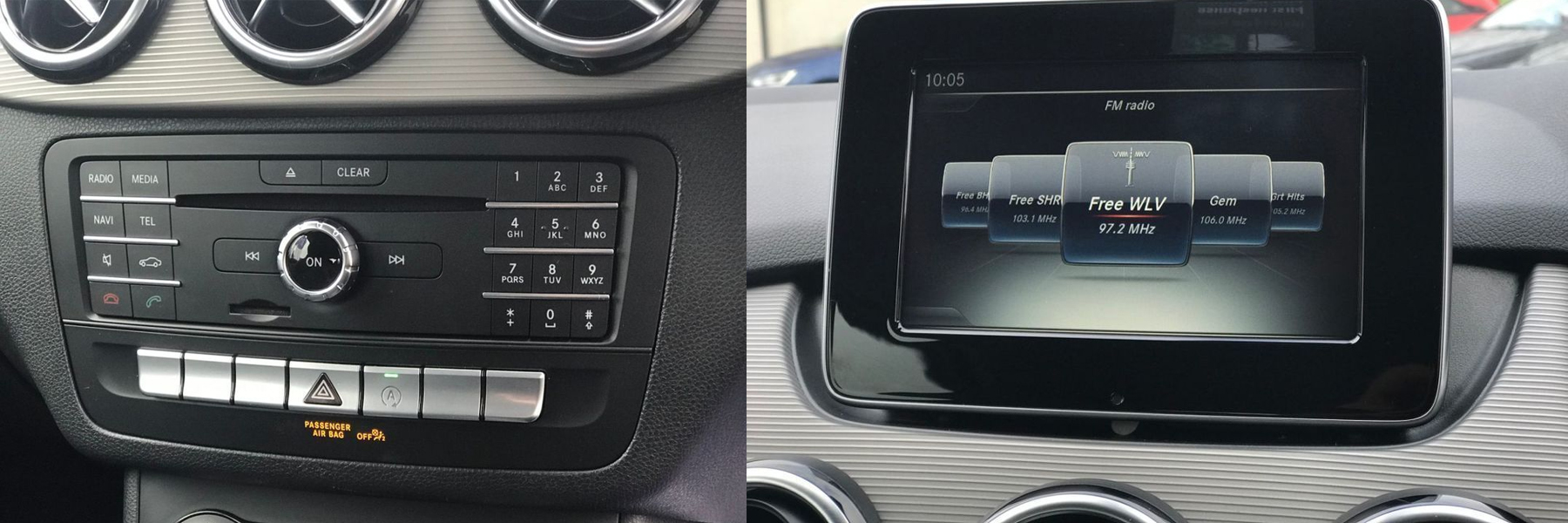
The third generation B-Class was launched on 2 October 2018.
Three infotainment system options is available, with entry-level models getting dual seven-inch displays. A seven-inch display with the larger 10.25-inch display is available, with top-tier models getting a pair of the large displays. It is powered by a full MBUX infotainment system, giving B-Class buyers access to its functions through a standard touchscreen.
The Citroen Berlingo is identical to the Peugeot Partner. It had an interior facelift in 2004
Porsche 911 (996) and Boxster (986)
Production years 1997 - 2004
1997 to 2004 model Porsche 911 and Boxsters have two original audio systems.
The earlier cars had a system similar to an Audi, the speakers are amplified and the head unit suppliers the audio to the amplifier via a low level signal from the Mini ISO connector. These cars require high to low level adapters to fit new head units or handsfree kits.
Later models use a fibre optic network to send the audio signal from the head unit to the amplifier. For these cars we have the 23-245 fibre optic interface available.
Generally the CD22/CDR22 original units have the Audi style system, CDR23 units can be either low level like the Audis or fibre optic. It is best to either find the amplifier under the front bonnet and look for fibre optic cables, or remove the head unit and look at the connection on the back.
Here is a picture of a car using a low level signal in the Mini ISO yellow connector to connect to the amplifier, note that all six positions are populated. These wires are the positive audio signals for front left, front right, rear left and rear right speakers, a common speaker negative and the amplifier turn on signal. Models with this set up will need to use the 20-281 amplifier interface. .
.
Here is a picture of a head unit using the fibre optic connection. Note that there are only four wires in the yellow Mini ISO, unlike six in the older version. These four wires are data wires, they do not carry any audio signal. Models with this fibre optic system require our 23-245 fibre optic amplifier interface to work. This not only connects to the amplifier but provides a switched live direct from the fuse box.
There are some cars with the very basic audio option, these have a traditional speaker ISO connector with the head unit driving the speakers directly. No audio adapters are needed for these cars.
The Porsche Boxster and Cayman 987 cars have a variety of original radio and amplifier options, depending on what is in the car affects what fitting parts are required when installing a new stereo.
The information below describes the different original audio equipment that is in these cars, this information is needed to make sure the correct parts are used when fitting a new stereo.
2004 - 2009 models
The Porsche Boxster (convertible) and Cayman (coupé) have several different setups for the original audio systems. Earlier models from 2005 to 2008 had the CDR24, PCM2 or PCM2.1 systems. The CDR24 was the basic head unit, the difference between the PCM units is the PCM2 has a CD player and the PCM2.1 has a DVD player. All these head units have ISO connectors at the rear.
Below are examples of the CDR24 and PCM2/2.1 original units.

There are also several amplifier options with these cars, non-amplified, ASK amplifiers known as the Sounds Package Plus (SPP) or premium BOSE amplifier.
Cars that are non-amplified will have two pairs of speaker wires in the ISO connector at the rear of the head unit, see image 2 below. ASK amplified cars have either 4 pairs of speaker wires in the ISO connector, see image 1 below, the amplifier requires a 12V switched turn on signal. The 12v turn on wire is the thin black/red wire in the black power ISO connector.
Cars with Bose will have no speaker wires present at the head unit, see image 3 below. The audio signal from the head unit is sent to the amplifier via fibre optics, a special interface is required for these cars or the amplifier will need to be bypassed or replaced.
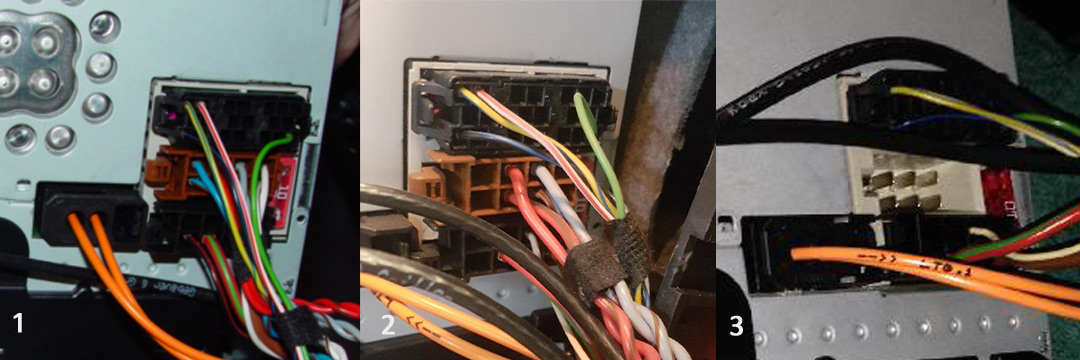
The amplifier is located under the front bonnet, see the image below, the image is of a non amplified car, you can see the blank metal plate where the amplifier is mounted. A small panel needs to be removed to access the amplifier location.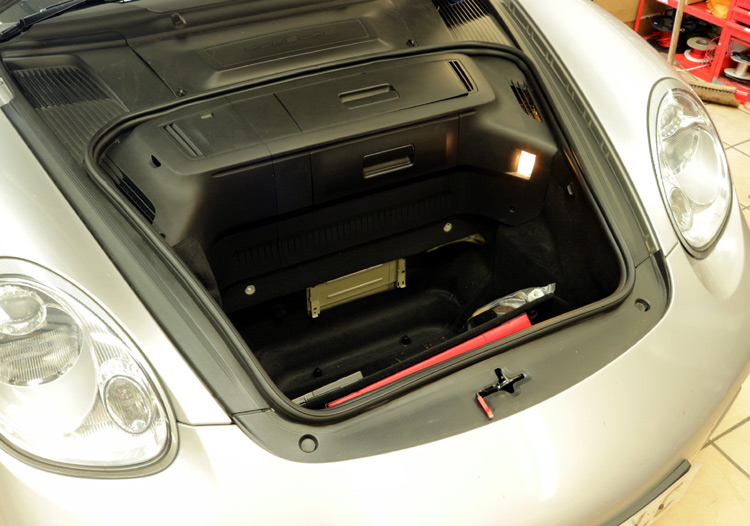
Below is an image of the ASK amplifier.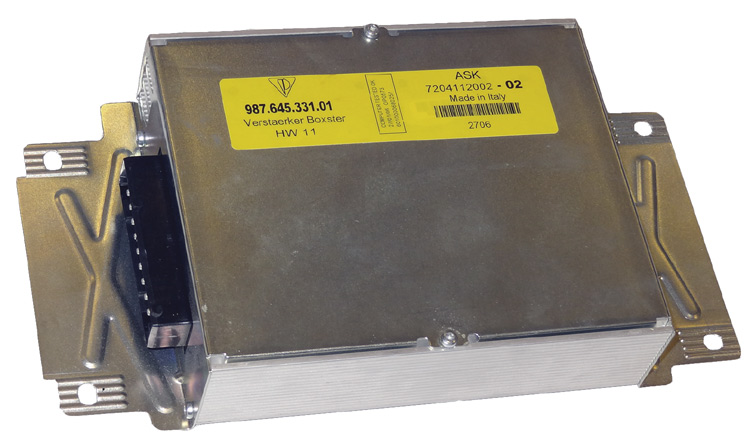
Below is an image of the Bose amplifier.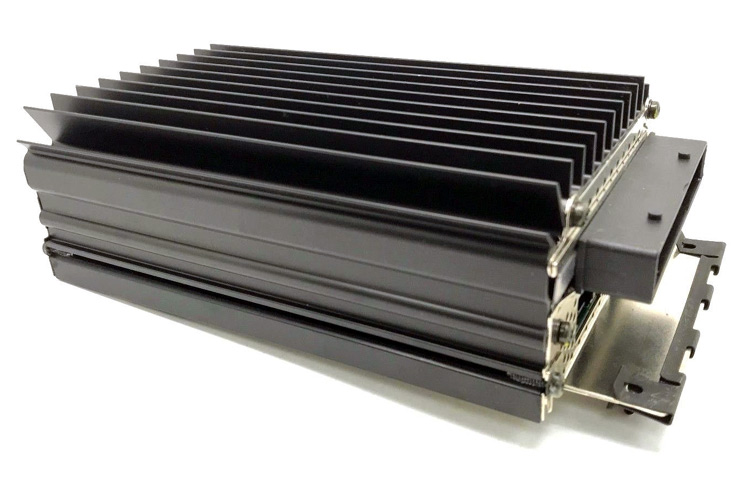
The type of audio system can also be identified by looking at the speakers in the door panel.
Non amplified cars have a single large speaker in the door and a tweeter on the dashboard, see image below. Note that the panel between the large speaker and the door handle is blank, cars with amplified systems have a mid range speaker here.
Cars with the Bose audio systems have woofer and mid range speaker grills in the door panel and a Bose badge in the top corner of the grill panel that covers the mid range speaker. See the images below.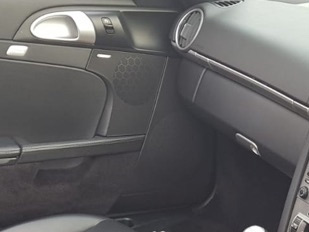

Cars with the ASK (Sound Package Plus) amplifier have the same speaker grill configuration as cars with Bose but without the Bose branding. However, there are some model cars that have the additional mid range speaker grill present in the car but do not have an amplifier or mid range speakers. The image below shows a door panel with the woofer and mid range speaker grills with no Bose branding.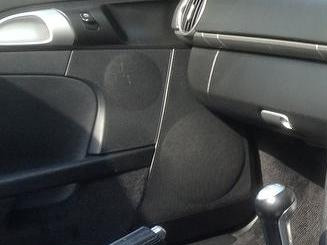
2009 - 2012 facelift models
From 2009 to 2012 the car was facelifted. The noticeable change is the colour of the dashboard, it has changed from silver to black and the original head unit options have been upgraded. Facelift models have either a CDR30 or PCM3 audio system.
Below are examples of the CDR30 and PCM3 original head units.
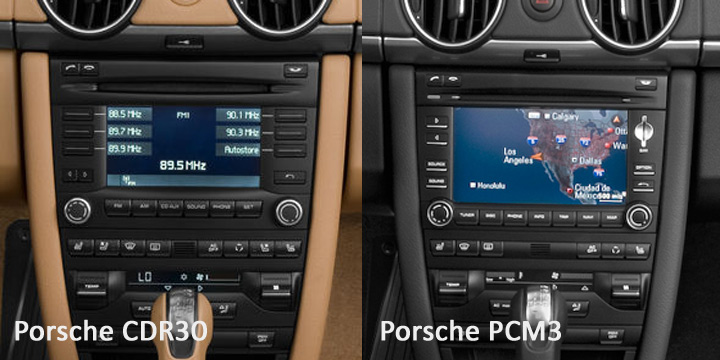
The CDR30 and PCM3 units also have quadlock connectors at the rear, replacing the ISO connectors on the older models. Similar to the older models with ISO, there are different amplifier options for these cars, some using speaker level outputs from the head unit and some using a fibre optic connection from the head unit to the amplifier.
Below are examples of the quadlock wiring.
1 is a car with 4 speaker channels in the quadlock and no fibre optic cables. 2 is a car with fibre optic connections for the audio and no speaker wires in the quadlock.

Porsche Boxster/Cayman 987
Production years 2005-2012
2004 - 2009 models
The Porsche Boxster (convertible) and Cayman (coupé) have several different setups for the original audio systems. Earlier models from 2005 to 2008 had the CDR24, PCM2 or PCM2.1 systems. The CDR24 was the basic head unit, the difference between the PCM units is the PCM2 has a CD player and the PCM2.1 has a DVD player. All these head units have ISO connectors at the rear.
Below are examples of the CDR24 and PCM2/2.1 original units.

There are also several amplifier options with these cars, non-amplified, ASK amplifiers known as the Sound Package Plus system (SPP) or premium BOSE amplifier.
Cars that are non-amplified will have two pairs of speaker wires in the ISO connector at the rear of the head unit, see image 2 below. ASK amplified cars have either 4 pairs of speaker wires in the ISO connector, see image 1 below, the amplifier requires a 12V switched turn on signal. The 12v turn on wire is the thin black/red wire in the black power ISO connector.
Cars with Bose will have no speaker wires present at the head unit, see image 3 below. The audio signal from the head unit is sent to the amplifier via fibre optics, a special interface is required for these cars or the amplifier will need to be bypassed or replaced.

The amplifier is located under the front bonnet, see the image below, the image is of a non amplified car, you can see the blank metal plate where the amplifier is mounted. A small panel needs to be removed to access the amplifier location.
Below is an image of the ASK amplifier.
Below is an image of the Bose amplifier.
The type of audio system can also be identified by looking at the speakers in the door panel.
Non amplified cars have a single large speaker in the door and a tweeter on the dashboard, see image below. Note that the panel between the large speaker and the door handle is blank, cars with amplified systems have a mid range speaker here.
Cars with the Bose audio systems have woofer and mid range speaker grills in the door panel and a Bose badge in the top corner of the grill panel that covers the mid range speaker. See the images below.

Cars with the ASK amplifier (Sound Package Plus SPP) have the same speaker grill configuration as cars with Bose but without the Bose branding. However, there are some model cars that have the additional mid range speaker grill present in the car but do not have an amplifier or mid range speakers. The image below shows a door panel with the woofer and mid range speaker grills with no Bose branding.
2009 - 2012 facelift models
From 2009 to 2012 the car was facelifted. The noticeable change is the colour of the dashboard, it has changed from silver to black and the original head unit options have been upgraded. Facelift models have either a CDR30 or PCM3 audio system.
Below are examples of the CDR30 and PCM3 original head units.

The CDR30 and PCM3 units also have quadlock connectors at the rear, replacing the ISO connectors on the older models. Similar to the older models with ISO, there are different amplifier options for these cars, some using speaker level outputs from the head unit and some using a fibre optic connection from the head unit to the amplifier.
Below are examples of the quadlock wiring.
1 is a car with 4 speaker channels in the quadlock and no fibre optic cables. 2 is a car with fibre optic connections for the audio and no speaker wires in the quadlock.

Do I have a CDR31 or PCM3.1 System?
The difference of having PCM 3.1 or CDR 3.1 is the buttons in the units centre console.
If your system has CD/ AUX button and AM/FM buttons then you have a CDR 3.1/ CDR31
.png)
If your system has NAVI/ MAP buttons and a SD Slot then you have a PCM 3.1.png)
Like the first generation the second generation was based on the same platform as the Ford Ranger. The exterior is quite different with only the glass and the roof shared between the two trucks, but the underpinnings and electrics are broadly similar. The radio requires a different fascia panel to the Ford Ranger but otherwise has the same workings behind the dashboard.
GT and XTR models built between 2015 and 2017 have a radio with a screen rather than the Ford 'SYNC1' style screen above the radio. A pocket is above the original radio on these models. Our fascia panel retains the original screen above the radio and leaves a gap where this pocket sits on these higher specification models, so a blanking plate must be made to fill the space.
Between 2017 and 2020 Mazda fitted a double DIN Alpine radio. A new fascia is not required for these cars.
This was replaced by the Citroen C4 Aircross.
MERCEDES C-CLASS (W205) 2014 ONWARDS
COMAND APS NTG 5
Comand NTG 5 exists in C-Class (W205) cars from 2014 onwards. It consists of a 8.4 inch LCD monitor on top of the centre dash and a more refined button selection on the centre head unit (in comparison to the NTG 4.5 or 5.1.)

At the 2014 Geneva Motor Show, Citroën revealed the new look 2nd Generation of the Citroen C1. It is related to the Citroën C1 and Toyota Aygo, sharing the chassis, engines, transmission, and electrics.
It was reported in November 2018 that the Citroen C1, along with the Peugeot 108, will be phased out in 2021, with Toyota taking full ownership of the plant in the Czech Republic, and the model will not be renewed.
Maximum mounting Depth of 150mm
Due to the shallowness of the original radio the maximum mounting depth of an aftermarket 2-DIN radio needs to be 70mm/80mm including plug at the bottom.
On L-Shaped devices with 1-DIN body at the top the maximum installation depth is 100mm/150mm including plug.
The Citroen C3 Aircross is the predecessor to the Citroen C3 Picasso.
As of 2017, the Citroen C3 Picasso has been succeeded by the Citroen C3 Aircross.
High Performance/ Premium Sound Systems Examples
All Volvo C30/C70/S40 and V50 car models from 2004-2012 had 3 different sound systems:
1. Performance Sound (NON-AMPLIFIED)
This was fitted as the standard sound system for most of these Volvo Models. Although it had a couple of variations in its model years, it typically consisted of a standard 6 or 8 speaker set up system
2. High Performance Sound (Amplified)
This was fitted both as standard on Higher Spec Volvo models and as an optional upgrade. An easy way to tell if your vehicle is fitted with this system is when the radio powers up it will show on the radio display as 'HIGH PERFORMANCE SOUND'
3. Premium Sound (Amplified) Either DYNAUDIO or DOLBY PRO LOGIC II
This was fitted as an optional upgrade. An easy way to tell if your vehicle is fitted with this system is when the radio powers up it will show on the radio display as PREMIUM SOUND' This sound system is easier to identify as their will usually be a DYNAUDIO badge on some of the sound equipment. For E.G. On top of the centre speaker above the radio (Centre Dashboard)
Below are some examples of the sound systems installed on C30 and C70 (2007-2013) car models
High Performance/ Premium Sound Systems Examples
All Volvo C30/C70/S40 and V50 car models from 2004-2012 had 3 different sound systems:
1. Performance Sound (NON-AMPLIFIED)
This was fitted as the standard sound system for most of these Volvo Models. Although it had a couple of variations in its model years, it typically consisted of a standard 6 or 8 speaker set up system
2. High Performance Sound (Amplified)
This was fitted both as standard on Higher Spec Volvo models and as an optional upgrade. An easy way to tell if your vehicle is fitted with this system is when the radio powers up it will show on the radio display as 'HIGH PERFORMANCE SOUND'
3. Premium Sound (Amplified) Either DYNAUDIO or DOLBY PRO LOGIC II
This was fitted as an optional upgrade. An easy way to tell if your vehicle is fitted with this system is when the radio powers up it will show on the radio display as PREMIUM SOUND' This sound system is easier to identify as their will usually be a DYNAUDIO badge on some of the sound equipment. For E.G. On top of the centre speaker above the radio (Centre Dashboard)
Below are some examples of the sound systems installed on C30 and C70 (2007-2013) car models
VW CADDY (2010-2016) RADIO OPTIONS


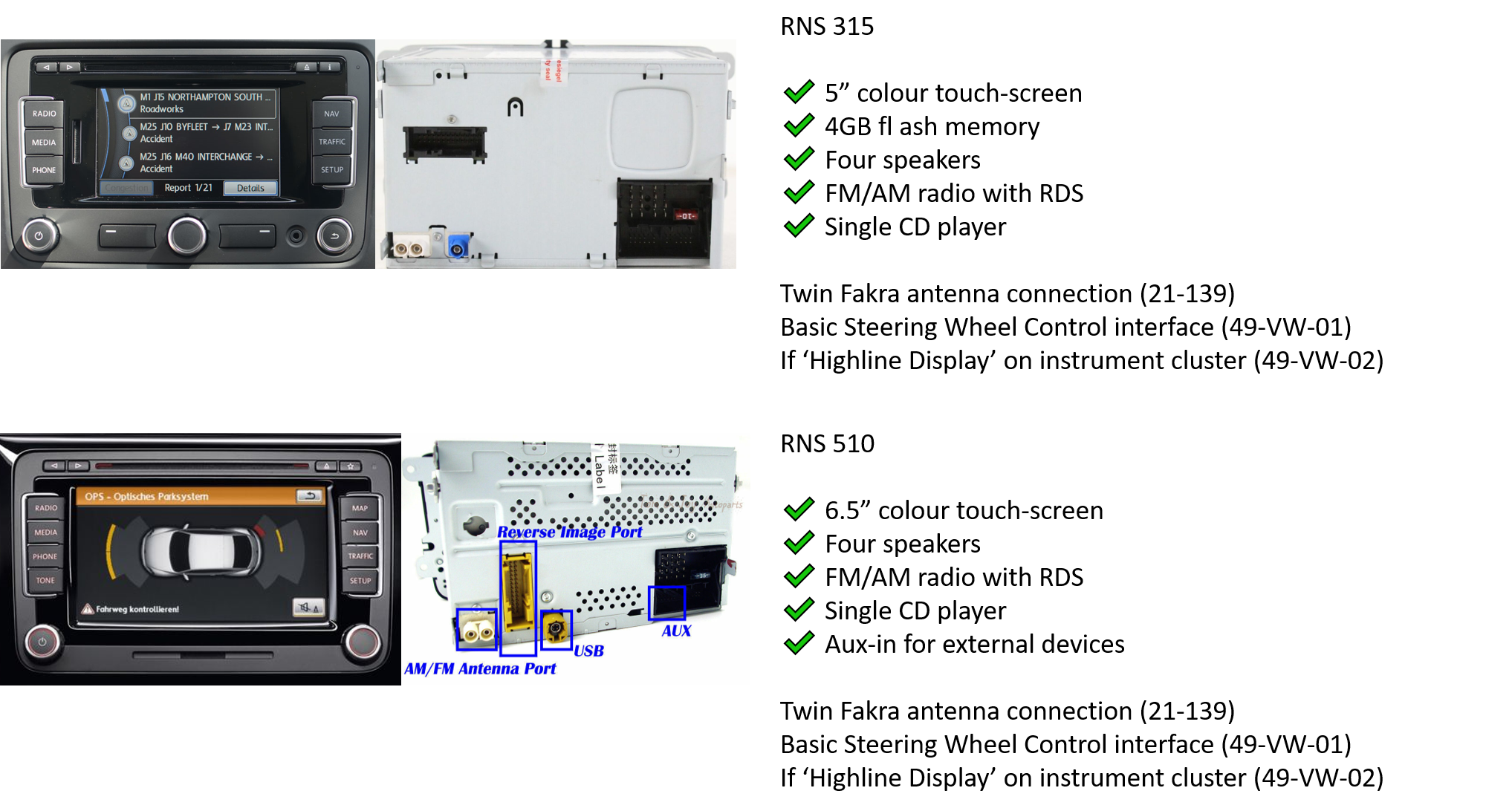
Do I have a CDR31 or PCM3.1 System?
The difference of having PCM 3.1 or CDR 3.1 is the buttons in the units centre console.
If your system has CD/ AUX button and AM/FM buttons then you have a CDR 3.1/ CDR31
.png)
If your system has NAVI/ MAP buttons and a SD Slot then you have a PCM 3.1.png)
The Porsche Boxster and Cayman 987 cars have a variety of original radio and amplifier options, depending on what is in the car affects what fitting parts are required when installing a new stereo.
The information below describes the different original audio equipment that is in these cars, this information is needed to make sure the correct parts are used when fitting a new stereo.
2004 - 2009 models
The Porsche Boxster (convertible) and Cayman (coupé) have several different setups for the original audio systems. Earlier models from 2005 to 2008 had the CDR24, PCM2 or PCM2.1 systems. The CDR24 was the basic head unit, the difference between the PCM units is the PCM2 has a CD player and the PCM2.1 has a DVD player. All these head units have ISO connectors at the rear.
Below are examples of the CDR24 and PCM2/2.1 original units.

There are also several amplifier options with these cars, non-amplified, ASK amplifiers known as the Sound Package Plus system (SPP) or premium BOSE amplifier.
Cars that are non-amplified will have two pairs of speaker wires in the ISO connector at the rear of the head unit, see image 2 below. ASK amplified cars have either 4 pairs of speaker wires in the ISO connector, see image 1 below, the amplifier requires a 12V switched turn on signal. The 12v turn on wire is the thin black/red wire in the black power ISO connector.
Cars with Bose will have no speaker wires present at the head unit, see image 3 below. The audio signal from the head unit is sent to the amplifier via fibre optics, a special interface is required for these cars or the amplifier will need to be bypassed or replaced.

The amplifier is located under the front bonnet, see the image below, the image is of a non amplified car, you can see the blank metal plate where the amplifier is mounted. A small panel needs to be removed to access the amplifier location.
Below is an image of the ASK amplifier.
Below is an image of the Bose amplifier.
The type of audio system can also be identified by looking at the speakers in the door panel.
Non amplified cars have a single large speaker in the door and a tweeter on the dashboard, see image below. Note that the panel between the large speaker and the door handle is blank, cars with amplified systems have a mid range speaker here.
Cars with the Bose audio systems have woofer and mid range speaker grills in the door panel and a Bose badge in the top corner of the grill panel that covers the mid range speaker. See the images below.

Cars with the ASK amplifier (Sound Package Plus SPP) have the same speaker grill configuration as cars with Bose but without the Bose branding. However, there are some model cars that have the additional mid range speaker grill present in the car but do not have an amplifier or mid range speakers. The image below shows a door panel with the woofer and mid range speaker grills with no Bose branding.
2009 - 2012 facelift models
From 2009 to 2012 the car was facelifted. The noticeable change is the colour of the dashboard, it has changed from silver to black and the original head unit options have been upgraded. Facelift models have either a CDR30 or PCM3 audio system.
Below are examples of the CDR30 and PCM3 original head units.

The CDR30 and PCM3 units also have quadlock connectors at the rear, replacing the ISO connectors on the older models. Similar to the older models with ISO, there are different amplifier options for these cars, some using speaker level outputs from the head unit and some using a fibre optic connection from the head unit to the amplifier.
Below are examples of the quadlock wiring.
1 is a car with 4 speaker channels in the quadlock and no fibre optic cables. 2 is a car with fibre optic connections for the audio and no speaker wires in the quadlock.

Porsche Boxster/Cayman 987
Production years 2005-2012
2004 - 2009 models
The Porsche Boxster (convertible) and Cayman (coupé) have several different setups for the original audio systems. Earlier models from 2005 to 2008 had the CDR24, PCM2 or PCM2.1 systems. The CDR24 was the basic head unit, the difference between the PCM units is the PCM2 has a CD player and the PCM2.1 has a DVD player. All these head units have ISO connectors at the rear.
Below are examples of the CDR24 and PCM2/2.1 original units.

There are also several amplifier options with these cars, non-amplified, ASK amplifiers known as the Sound Package Plus system (SPP) or BOSE amplifier.
Cars that are non-amplified will have two pairs of speaker wires in the ISO connector at the rear of the head unit, see image 2 below. ASK amplified cars have either 4 pairs of speaker wires in the ISO connector, see image 1 below, the amplifier requires a 12V switched turn on signal. The 12v turn on wire is the thin black/red wire in the black power ISO connector.
Cars with Bose will have no speaker wires present at the head unit, see image 3 below. The audio signal from the head unit is sent to the amplifier via fibre optics, a special interface is required for these cars or the amplifier will need to be bypassed or replaced.

The amplifier is located under the front bonnet, see the image below, the image is of a non amplified car, you can see the blank metal plate where the amplifier is mounted. A small panel needs to be removed to access the amplifier location.
Below is an image of the ASK amplifier.
Below is an image of the Bose amplifier.
The type of audio system can also be identified by looking at the speakers in the door panel.
Non amplified cars have a single large speaker in the door and a tweeter on the dashboard, see image below. Note that the panel between the large speaker and the door handle is blank, cars with amplified systems have a mid range speaker here.
Cars with the Bose audio systems have woofer and mid range speaker grills in the door panel and a Bose badge in the top corner of the grill panel that covers the mid range speaker. See the images below.

Cars with the ASK amplifier (Sound Package Plus SPP) have the same speaker grill configuration as cars with Bose but without the Bose branding. However, there are some model cars that have the additional mid range speaker grill present in the car but do not have an amplifier or mid range speakers. The image below shows a door panel with the woofer and mid range speaker grills with no Bose branding.
2009 - 2012 facelift models
From 2009 to 2012 the car was facelifted. The noticeable change is the colour of the dashboard, it has changed from silver to black and the original head unit options have been upgraded. Facelift models have either a CDR30 or PCM3 audio system.
Below are examples of the CDR30 and PCM3 original head units.

The CDR30 and PCM3 units also have quadlock connectors at the rear, replacing the ISO connectors on the older models. Similar to the older models with ISO, there are different amplifier options for these cars, some using speaker level outputs from the head unit and some using a fibre optic connection from the head unit to the amplifier.
Below are examples of the quadlock wiring.
1 is a car with 4 speaker channels in the quadlock and no fibre optic cables. 2 is a car with fibre optic connections for the audio and no speaker wires in the quadlock.

Identifying the right parts for my Kia Cee'd / Pro Cee'd
The biggest difference in 2012-2018 Kia Cee'd is the difference in the connectors at the back of the original radio. In 2012 - 2017 models this consisted of a 18 and 24 PIN connectors where as 2017 models began introducing a larger block connector. Please use the guides below to match up the correct connections with your current radio. If you are still unsure it is best to carefully remove the radio slightly to check what connections you have behind.
Basic Audio (2012-2017)
The Basic Audio range has Steering Wheel Controls and AUX/USB connections as standard. Please note: Some 2018 Kia Cee'd models still have a basic audio option.
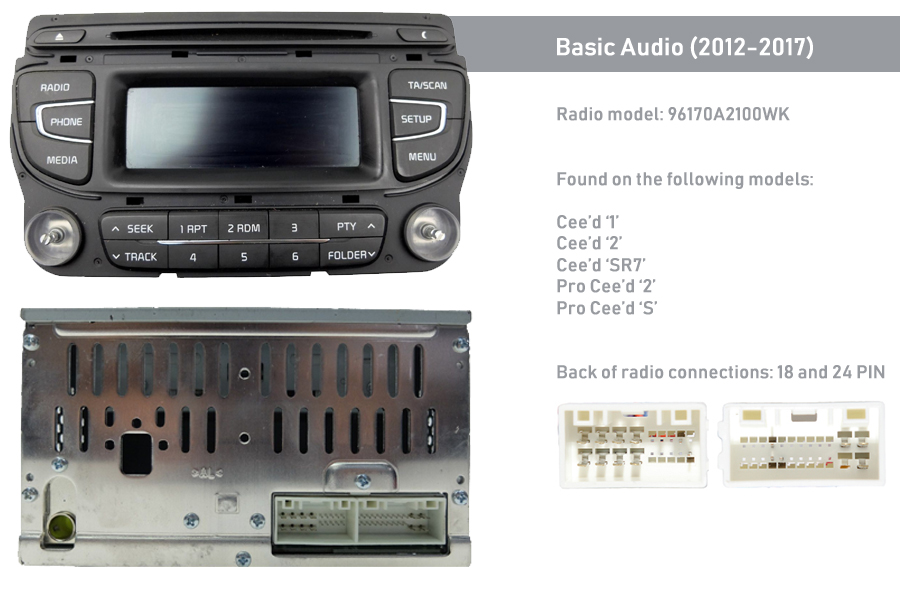
Navigation CD (2012-2017)
The first Navigation ranges have a CD slot above the radio. These ranges consist of Steering Wheel Controls and AUX/USB connections as standard, as well as a reversing camera built into the navigation screen. Some higher specs also have start/ stop function. We can provide all the necessary cables for this, please visit our car audio selections under the car model.

Navigation SD (2012-2017)
These Navigation ranges have a SD slot above the radio. These ranges consist of Steering Wheel Controls and AUX/USB connections as standard, as well as a reversing camera built into the navigation screen. Some higher specs also have start/ stop function. We can provide all the necessary cables for this, please visit our car audio selections under the car model.

Navigation SD (2016-2018)
In 2016 Kia began updating its navigation radios with a larger new style connector. These ranges consist of Steering Wheel Controls and AUX/USB connections as standard, as well as a reversing camera built into the navigation screen. Some higher specs also have start/ stop function. We can provide all the necessary cables for this, please visit our car audio selections under the car model.
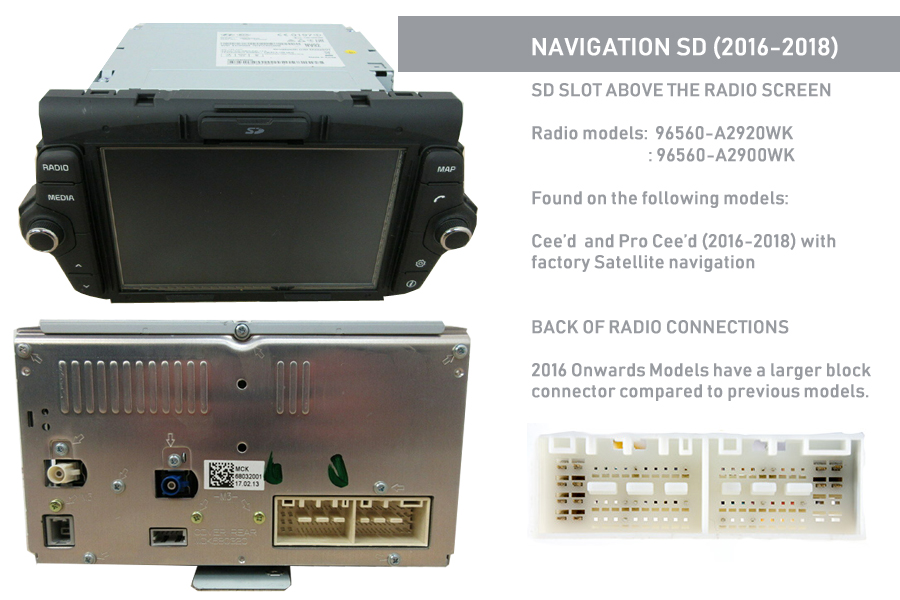
The Chevrolet City Express is a badge engineered version of the Nissan NV200 for the North American market. It shares no components with other Chevrolet or General Motors models and was discontinued after only four years on sale.
The 8th Generation Honda Civic built between 2006 and 2011 was split into two completely different model lines for Europe and the rest of the world.
The European Civic hatchback was built in Swindon, UK, with a number of different standard and navigation radio options.
The Honda Civic saloon/sedan and coupe was built in a number of different plants across the globe, including Japan, USA, Mexico and Turkey. It features a completely different dashboard design and radio to the UK built hatchbacks.
The saloon/sedan was only imported to the UK as a hybrid, although many markets, including Japan, Australia and New Zealand sold both models lines simultaneously, differentiating them by their body style.
Both types of 8th generation Civic require different radio fascias for right and left hand drive vehicles. The parts required to change the radio in the UK built hatchback are completely different from those required for the saloon or coupe, please check which body style your car has before ordering.
The 9th Generation Honda Civic built between 2012 and 2017 was split into two completely different model lines for Europe and the rest of the world.
The European Civic hatchback and tourer was built in Swindon, UK, with a number of different standard and navigation radio options. Late models changed to a Honda Connect radio powered by Google Android.
The Honda Civic saloon/sedan and coupe was built in a number of different plants across the globe, including Japan, USA, Mexico and Turkey. It features a completely different dashboard design and radio to the UK built cars
The saloon/sedan was not imported to the UK, but was sold in a number of other right hand drive markets including Japan and Australasia along side the UK built cars.
Both types of 9th generation Civic require different radio fascias for right and left hand drive vehicles. The parts required to change the radio in the UK built hatchback or tourer are completely different from those required for the saloon or coupe, please check which body style your car has before ordering.
There is currently no solution available to change or upgrade the later Honda Connect radio.
The 8th Generation Honda Civic built between 2006 and 2011 was split into two completely different model lines for Europe and the rest of the world.
The European Civic hatchback was built in Swindon, UK, with a number of different standard and navigation radio options.
The Honda Civic saloon/sedan and coupe was built in a number of different plants across the globe, including Japan, USA, Mexico and Turkey. It features a completely different dashboard design and radio to the UK built hatchbacks.
The saloon/sedan was only imported to the UK as a hybrid, although many markets, including Japan, Australia and New Zealand sold both models lines simultaneously, differentiating them by their body style.
Both types of 8th generation Civic require different radio fascias for right and left hand drive vehicles. The parts required to change the radio in the UK built hatchback are completely different from those required for the saloon or coupe, please check which body style your car has before ordering.
The second generation CLA-Class was unveiled in January 2019.
All models feature the Mercedes-Benz User Experience (MBUX) infotainment system, including the "Hey Mercedes" voice-controlled assistant and a new Interior Assist gesture control system. Standard models feature two 7-inch displays for the instrument cluster and MBUX screen, and can be upgraded to 10.25-inch screens.
The first generation CLK (W208) came with 3 different types of original head unit. Audio 10 in both Cassette and CD player form, Audio 30 and a Command navigation system.
The Audio 10 and Audio 30 sets are single DIN and have a pocket or CD storage trays underneath. The Command system is double DIN in size. No fascia is needed for either radio type.
The C257 Mercedes-Benz CLS is the third and current generation of the CLS range of four-door sedan, and was launched in 2018 as the successor to the Mercedes-Benz CLS (C218). It is only available as a sedan, with no plans to introduce a Shooting Brake variant in the near future.
Optional equipment includes air suspension and a widescreen cockpit consisting of two 12.3-inch displays on the dashboard.
The first generation of the Mini Clubman was built between 2007 and 2014, based on the same platform as the second generation (R56) hatchback.
In 2012 a light van version called the Clubvan was released and produced until 2014 when it was discontinued without replacement.
The Holden Colorado and Colorado 7 was developed by General Motors with Isuzu, who built the D-Max and MU-X on the same platform.
Between 2012 and 2014 Holden used the same Fujitsu 10 radios as Isuzu and then in 2014 moved to the General Motors Mylink system with a 7" screen.
These later models use the same fascia panel as earlier models but require different fitting parts. Please select the correct radio when choosing parts for your vehicle.
The fourth generation Combo was unveiled at the 2018 Geneva Motor Show. It is a sister model to the Citroën Berlingo and Peugeot Rifter and Partner, as Groupe PSA bought Opel in March 2017.
The Holden Commodore VE, and its badge engineered versions the Vauxhall VXR8 and the Pontiac G8, have the climate controls integrated into the original radio.
To replace the original radio we have kit FK-559 which includes new dual zone automatic climate controls built into the new radio fascia with a digital display. This is will only fit cars with original dual zone climate control - either manual or automatic - and won't fit cars with original single zone climate control. We do not have a solution for cars with original single zone climate control.
Please see below for examples of original single zone and dual zone climate controls:
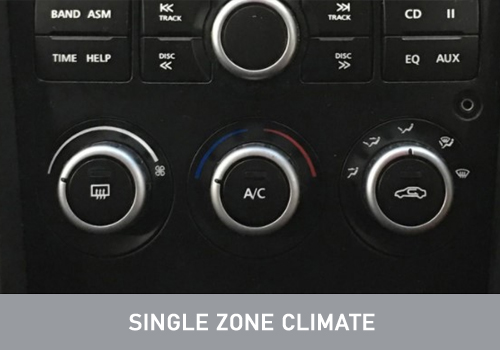
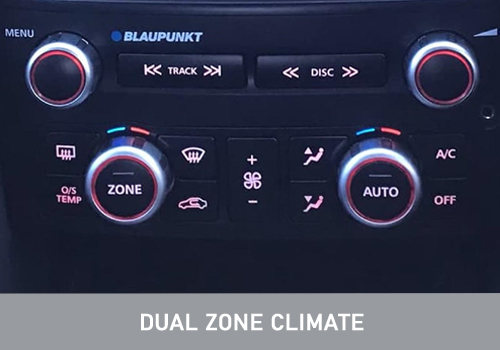
The second generation uses Fiat Chrysler U-Connect head units. The mounting depth for a new head unit is quite shallow. Radios with CD players will not fit
In 2017 Vauxhall and Opel were bought by Groupe PSA from General Motors. Due to this, the 2019 Vauxhall Corsa F moved entirely away from the older GM technology in the rest of the Vauxhall range and is based on the Peugeot 208, using the same SMEG entertainment system.
The electric version of the Corsa F is badged as the "Corsa e" this should not be confused with the previous generation Vauxhall Corsa E.
In 2010 Mini launched their 5 door crossover, the Countryman with model code R60. The first generation of Countryman was made until 2016 when it was replaced with the second generation F60.
The Paceman (R61) was a 3 door crossover coupe based on the R60 Clubman and was launched for the 2013 model year. It was discontinued with no replacement in 2016.
Volkswagen Crafter (2006-2016) Radio Options
1. Volkswagen RCD 2001 Crafter (2006-2014)
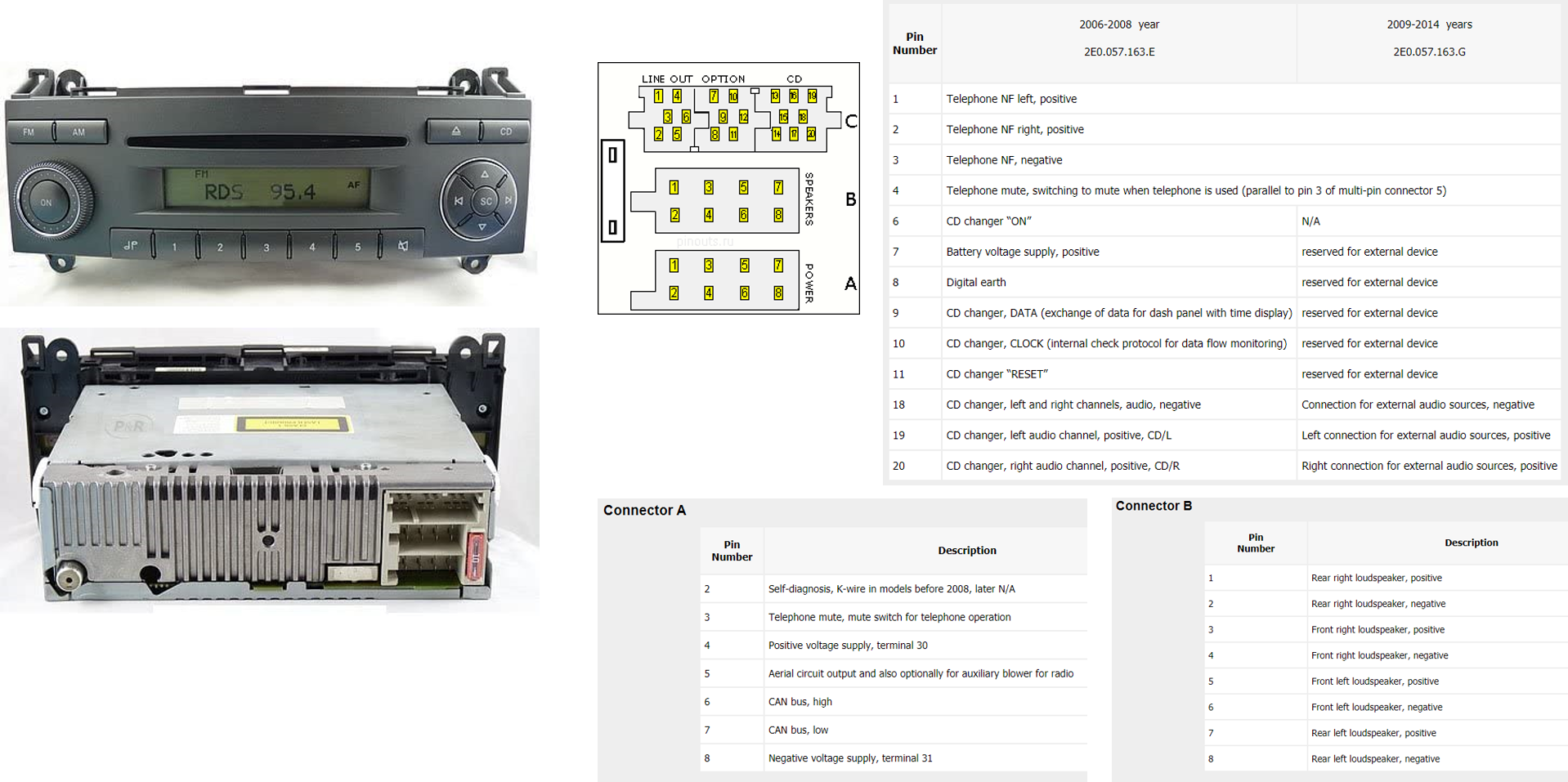
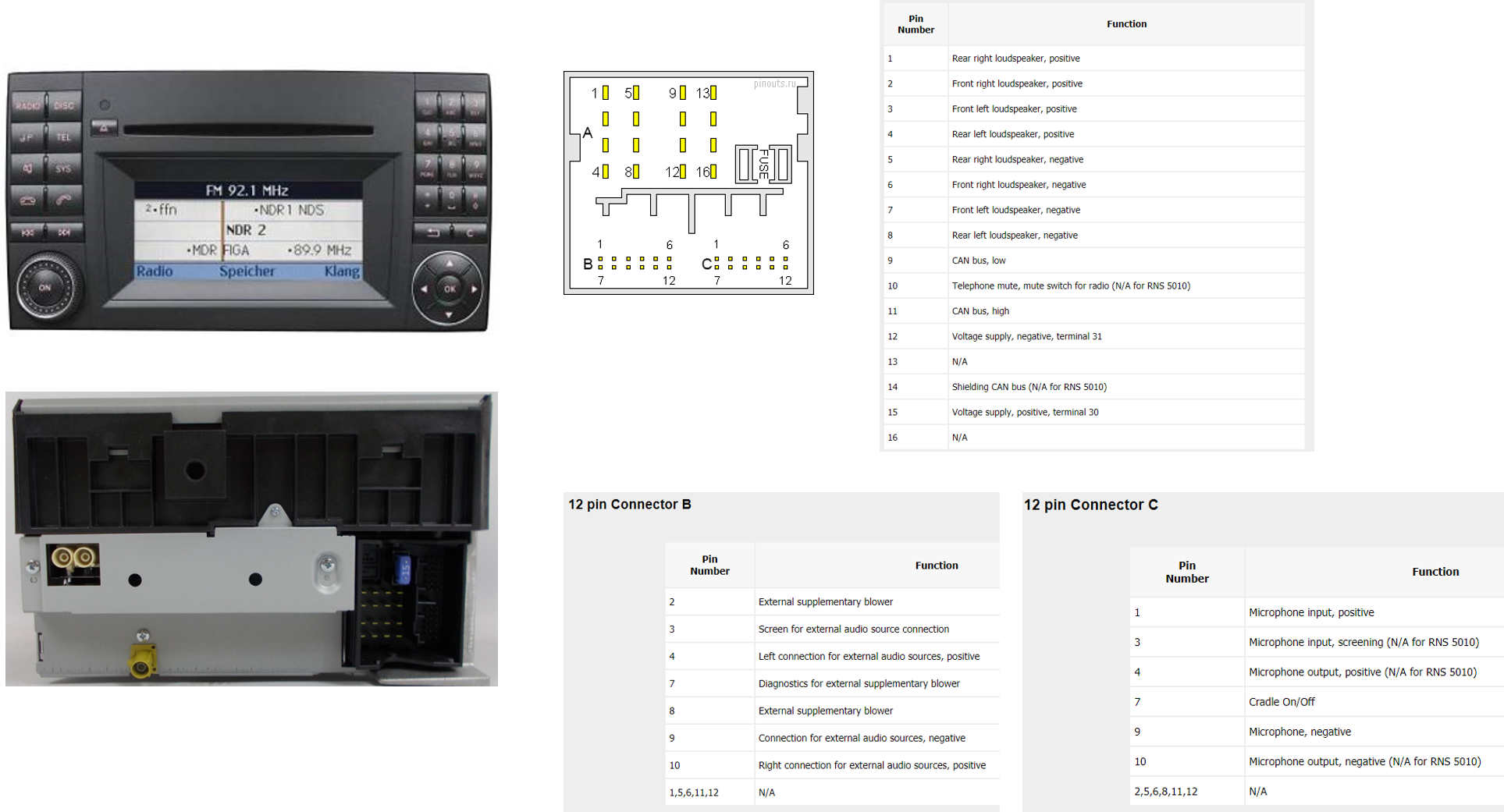
Installation depth issues
Due to the shallow depth behind the 2017 onwards VW Crafter, there is only space for a Single din radio chassis or a slim chassis/ modular head unit (maximum mounting depth for the aftermarket radio of 55mm). These units must have the single din body relocated to the top of the monitor because in the crafter the single din hole is at the top, the lower part is not din depth and would not allow you to mount a traditional double din radio.
Careful attention needs to be paid to the radio that is to be fitted and the modifications that may be required, either to the fascia kit or the vehicle.
We strongly recommend the installation is done by an experienced car audio technician only
See the image below that shows the available space behind the original radio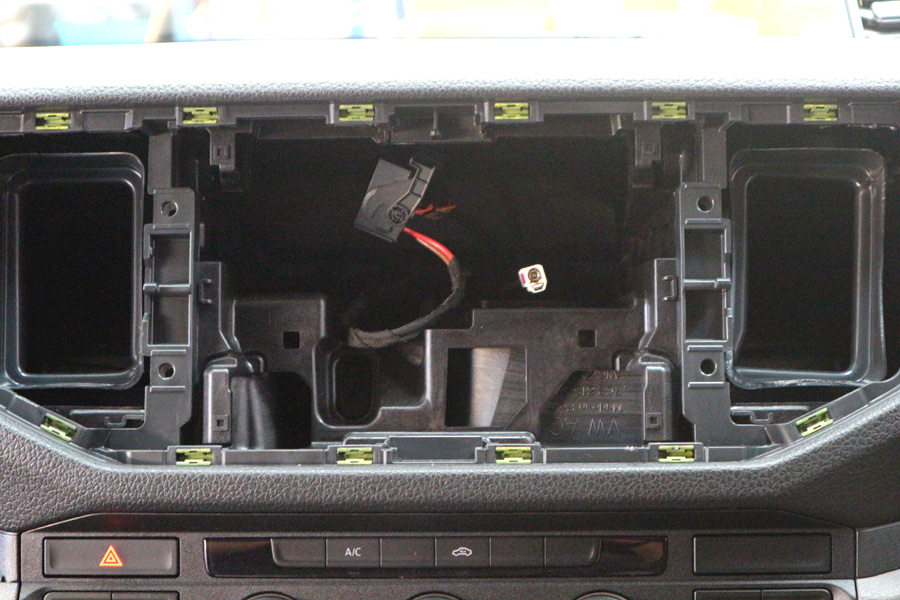
The composition Audio is the basic spec of radio installed in 2017 onwards VW Crafter's. These are standard on all Startline model variants and have no steering wheel audio controls.
There are 2 different generation types, depending on what year the vehicle was manufactured. Type 1 originates from 2017 onwards and Type 2 from around 2019 through to 2021.

Composition Media (2017 onwards)
The Composition Media is installed in Trendline model variants of the 2017 Onwards VW Crafter's. These are MIB2 units, with a screen in the centre display and the actual radio unit in the glovebox. As with all of the 2017 Onwards Crafter's there are space restrictions in behind the dash.
Another solution to installing an aftermarket head unit is to add a Smartphone integration interface to the original unit instead. This interface (27-878) enables the end user to control their Iphone/ Android smartphone device through the vehicles original display.
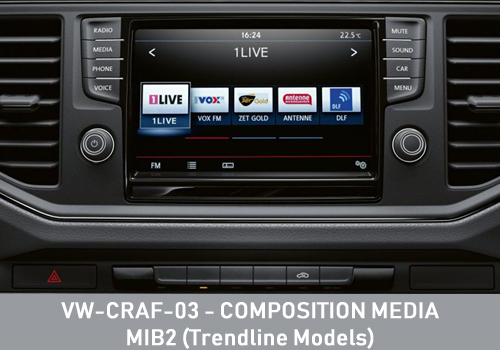
The Crossland X received a facelift in 2020 and was renamed to “Opel Crossland”, dropping the "X".
The Holden Cruze YG was developed from the Suzuki Ignis FH by Holden for sale in the Australian market and as the Chevrolet Cruze for the Japanese market and were built in Japan. These Japanese manufactured cars were built with a single DIN radio unlike the Hungarian built versions of the otherwise very similar 2003-2008 Suzuki Ignis which has a Vauxhall/Opel shaped radio higher up in the dashboard.
The Mitsubishi Magna was a large sedan produced by Mitsubishi Motors Australia. The third generation built between 1996 and 2005 were also named Verada and Solara in their home market depending on the trim level.
It was exported to New Zealand, Japan and the USA as the Mitsubishi Diamante.
It received a number of minor facelifts in its life time and a major facelift (easily seen from the change from rectangular headlamps to larger triangular ones) in 2003. These changes do not affect what is needed to change the radio and all come as standard with a double DIN sized aperture for the radio.
In 2021 The Ducato received a mild refresh with 5" or 7" U-Connect head units on offer. A few months after it also received the new FIAT corporate logo, although some early models do still have the earlier logo with the red background.
The Honda E is a small electric city car and the first fully electric car from Honda.
The dashboard, wing mirror style cameras and infotainment are set across one large screen which is spread across the dashboard, making the radio impossible to replace with aftermarket. The speakers can be changed.
COMAND-APS NTG 5.5
The Comand-APS NTG 5.5 is the 3rd generation of the NTG 5 era. It was fitted to W213 E-Class cars from 2018 onwards and also replaced NTG 5.2 in some facelifted vehicles, such as the W222 S class and C-Class cars from 2018/ 2019 onwards. Unlike its other NTG 5 relatives, the NTG 5.5 has Apple Car-Play and Android Auto.
E-CLASS (W213) 2018 > (12.3 INCH TOUCHSCREEN)
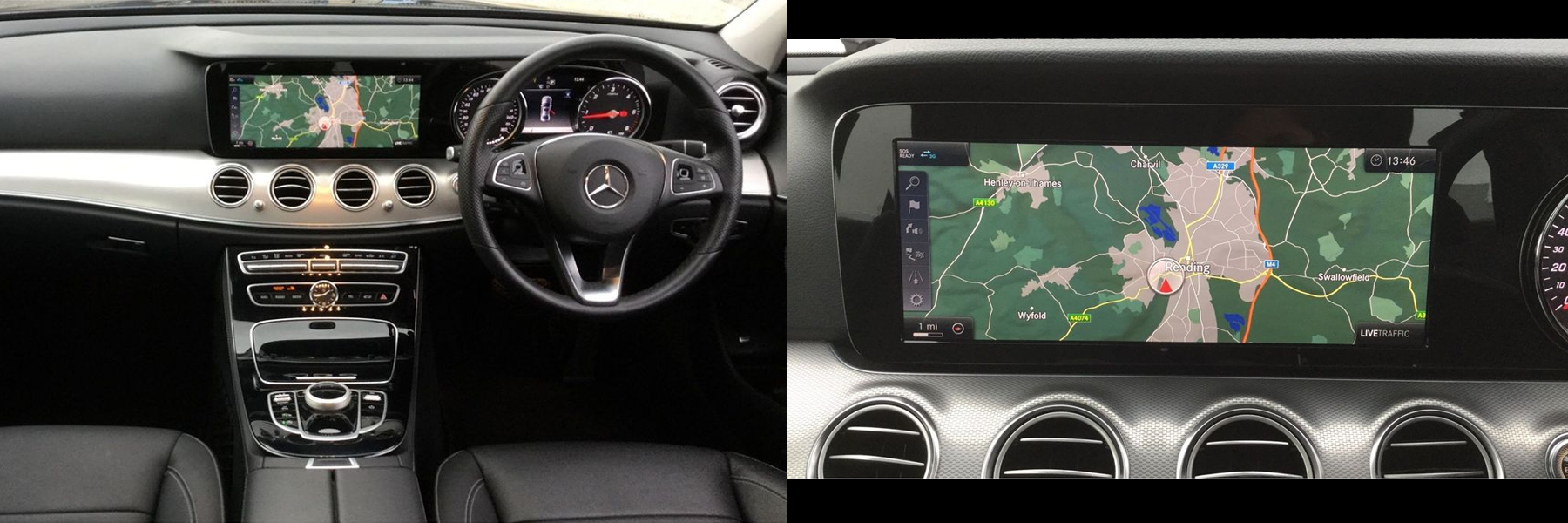
COMAND NTG 5.1 (February 2015 - 2016)
Comand NTG 5.1 is part of the Mercedes NTG 5 Comand series and features in the E-Class (W212) facelift models only from February 2015 to 2016. It consists of a 8 inch screen and unlike newer NTG 5 versions still has a keypad on the main head unit.
E-Class (W212) FACELIFT MODELS 02.2015 - 2016 (8 INCH SCREEN)

The Mitsubishi Eclipse Cross is a small crossover that is unrelated to the earlier Eclipse Coupe.
The radio can only be changed on basic ES models, which were not available in all markets.
The Ford Edge was called the Ford Endura in Australia and New Zealand.
The Nissan Elgrand E51 was the second generation of Elgrand sold on the Japanese Domestic Market, but has since been exported across the globe as a used car.
The radio is built around the gear selector and heater controls, with the original fascia in a number of different colours to compliment the rest of the interior. When fitting an aftermarket radio, the only fascia colour choice available in black. The reverse camera, air conditioning information and original navigation are built into the top screen and are retained when the radio is changed.
Series 1 cars were built between May 2002 and August 2003
These are most easily identifiable by the hazard switch being integrated into the surround for the gear selector and came from new with either an integrated CD and Minidisc or Casette player or a single DIN radio with a pocket below.
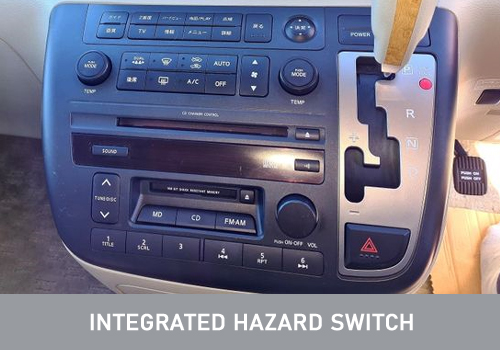
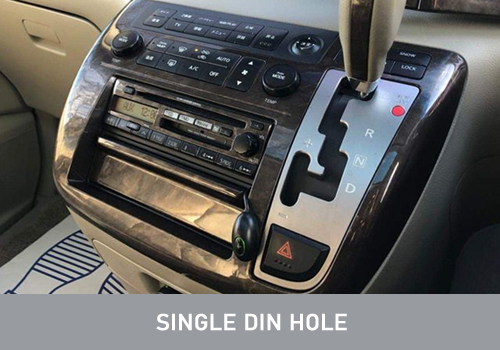
Many of the versions with the single DIN radio have since been swapped out with a double DIN radio and do not need a new fascia to fit a new radio,
If your car is a series 1 car with the integrated radio then we don't have a fascia available at this time and the installation of a new head unit is not currently possible.
Series 2 cars were built from August 2003 until late 2007.
Series 2 models can be identified by the hazard switch being separate from the surround of the gear selector. There is also a defined panel gap above the heater controls and gear selector and the buttons above, where as on earlier cars the radio fascia continues up around these controls. These vehicles use our fascia 50-669 and can be changed. There are three versions; the standard option and two amplified versions, BOSE and 5.1 Theatre Sound.
If it is fitted with a BOSE system then it will need an amplifier interface.
If it has a 5.1 Theatre Sound system then it will require the amplifier to be bypassed which will disable the centre speaker, rear hatch speakers and rear subwoofer.
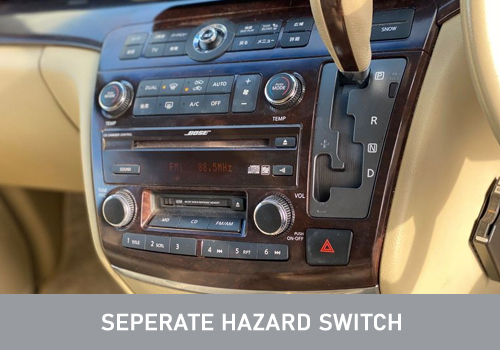
Series 3 cars built from 2007 until the end of production in 2010.
A few cars in this time period were made with the same setups as the earlier series 2 cars, but the majority were fitted with Nissan "Carwings" vehicle telematics service in the place where the heater controls were fitted on earlier cars. The majority of the functionality of this doesn't work outside of Japan and is removed when fitting a new radio.
We don't have any plug and play parts for this system and it require modifications to the 50-669 fascia, the original wiring loom and raking apart original radio modules to retain original functionality.
Changing the radio on a series 3 car with "Carwings" should only be attempted by a professional car audio installer.
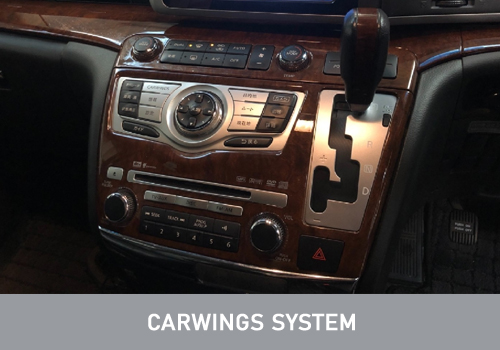
The 2020 Renault-Express is based on the Dacia Docker and is often called the Kangoo Express. It is not to be confused with the 2021 onwards Renault Kangoo which shares a platform with the Nissan Townstar and Mercedes Citan. This is based on a different platform and has a different radio.
Skoda Fabia mk2 5J
Production years 2007 - 2014
The second generation Skoda Fabia was produced from 2007 to 2014. Nearly all cars have the Volkswagen double din radio (sometimes branded as Skoda Swing, Dance, Bolero), however, there are a very small amount of cars that have a smaller Skoda Beat head unit, these cars with the Beat head unit require a different fascia panel, only a single din radio can be installed, a double din will not fit. Both the Volkswagen style units and the Beat unit use a quadlock connector at the back of the radio.
Sold in the USA as the Aspire and in Japan and Australasia as the Festiva.
It was jointly developed by Ford and Kia.
Models sold in the USA as teh Aspire (between 1995 and 1997) use the Ford style radio connections.
Models for Japan, Australia and New Zealand use the Mazda style radio connections.
FORD SYNC 1 (2008 ONWARDS)
The first generation of SYNC was introduced back in September 2007 and gave drivers the ability to connect their phone to the car via Bluetooth. This meant they could play music and also make or take telephone calls either by using the stereo keys or voice control, and also read text messages.
SYNC 1.0 also teamed up with the car’s factory-fitted parking sensors. It displayed a visual representation when you reverse and works alongside the audio signals. Media devices could also be connected by USB, then the music could be selected straight on the infotainment system.
SYNC has a center display that shows basic information, such as caller ID, song titles, a digital clock, and temperature.
SYNC and SYNC with MyFord includes the following features:
- Hands-free calling
- Voice control of your media player
- SYNC AppLink™ (if available)
- 4.2-inch color cluster display or horizontal two-line display
Which cars have SYNC 1.0?
The following list is subject to trim level:
Fiesta (2008 – 2017)
Focus (2011-onwards)
C-Max/Grand C-Max (2011-onwards)
B-Max (2012-onwards)
Ka+ (2016-onwards)
Ecosport (2012-onwards)
Grand Tourneo Connect (2012-onwards)
Kuga (2013-onwards)
It’s worth noting that the functions you get through SYNC will vary depending on the model year. For example, in March 2015, SYNC was updated to display track names from mobile phone devices, but couldn’t do this beforehand.
FORD SYNC 1 (2008 ONWARDS)
The first generation of SYNC was introduced back in September 2007 and gave drivers the ability to connect their phone to the car via Bluetooth. This meant they could play music and also make or take telephone calls either by using the stereo keys or voice control, and also read text messages.
SYNC 1.0 also teamed up with the car’s factory-fitted parking sensors. It displayed a visual representation when you reverse and works alongside the audio signals. Media devices could also be connected by USB, then the music could be selected straight on the infotainment system.
SYNC has a center display that shows basic information, such as caller ID, song titles, a digital clock, and temperature.
SYNC and SYNC with MyFord includes the following features:
- Hands-free calling
- Voice control of your media player
- SYNC AppLink™ (if available)
- 4.2-inch color cluster display or horizontal two-line display
Which cars have SYNC 1.0?
The following list is subject to trim level:
Fiesta (2008 – 2017)
Focus (2011-onwards)
C-Max/Grand C-Max (2011-onwards)
B-Max (2012-onwards)
Ka+ (2016-onwards)
Ecosport (2012-onwards)
Grand Tourneo Connect (2012-onwards)
Kuga (2013-onwards)
It’s worth noting that the functions you get through SYNC will vary depending on the model year. For example, in March 2015, SYNC was updated to display track names from mobile phone devices, but couldn’t do this beforehand.
FORD SYNC 1 (2008 ONWARDS)
The first generation of SYNC was introduced back in September 2007 and gave drivers the ability to connect their phone to the car via Bluetooth. This meant they could play music and also make or take telephone calls either by using the stereo keys or voice control, and also read text messages.
SYNC 1.0 also teamed up with the car’s factory-fitted parking sensors. It displayed a visual representation when you reverse and works alongside the audio signals. Media devices could also be connected by USB, then the music could be selected straight on the infotainment system.
SYNC has a center display that shows basic information, such as caller ID, song titles, a digital clock, and temperature.
SYNC and SYNC with MyFord includes the following features:
- Hands-free calling
- Voice control of your media player
- SYNC AppLink™ (if available)
- 4.2-inch color cluster display or horizontal two-line display
Which cars have SYNC 1.0?
The following list is subject to trim level:
Fiesta (2008 – 2017)
Focus (2011-onwards)
C-Max/Grand C-Max (2011-onwards)
B-Max (2012-onwards)
Ka+ (2016-onwards)
Ecosport (2012-onwards)
Grand Tourneo Connect (2012-onwards)
Kuga (2013-onwards)
It’s worth noting that the functions you get through SYNC will vary depending on the model year. For example, in March 2015, SYNC was updated to display track names from mobile phone devices, but couldn’t do this beforehand.
Ford SYNC 3 (2016 ONWARDS)
Most Ford models that were built from the end of 2016 onwards will feature the latest version of SYNC 3 which is easily distinguishable from SYNC 2. The new Ford Fiesta will also feature SYNC 3 on the Zetec trim and above as standard.
All new Ford Fiestas feature SYNC 3 Technology. This consists of either a dash mounted 6.5" or 8” colour touchscreen with pinch-and-swipe gestures. You can also use your voice to make calls, control your entertainment, and even input a destination to your navigation system.
SYNC 3 Includes all the features as the basic system, plus the following:
- 6.5- or 8-inch color touchscreen with easy-to-read text and icons
- Capacitive touch technology requires just a light tap or swiping and pinching for some features with available navigation system
- Touchscreen responds with impressive speed
- Enhanced voice recognition
- Five-way controls on the steering wheel

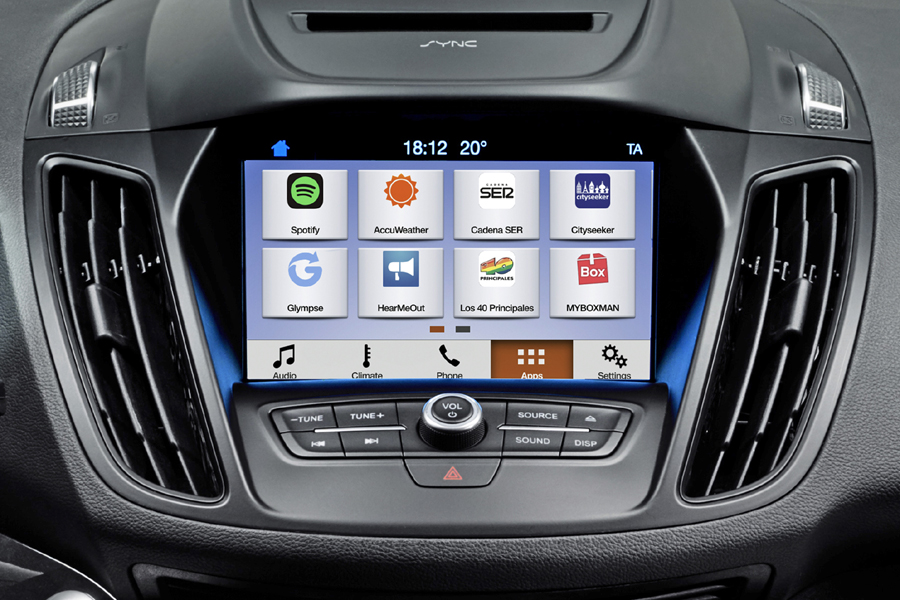
OUR FITTING SOLUTIONS
Currently we do have a head unit upgrade solution for this.
Our camera interface (27-317) will allow you to add a camera to your vehicle however Vehicle Coding is required.
Still unsure which SYNC system you have? Please visit our technical documents for more information
Ford SYNC 3 (2016 ONWARDS)
Most Ford models that were built from the end of 2016 onwards will feature the latest version of SYNC 3 which is easily distinguishable from SYNC 2. The new Ford Fiesta will also feature SYNC 3 on the Zetec trim and above as standard.
All new Ford Fiestas feature SYNC 3 Technology. This consists of either a dash mounted 6.5" or 8” colour touchscreen with pinch-and-swipe gestures. You can also use your voice to make calls, control your entertainment, and even input a destination to your navigation system.
SYNC 3 Includes all the features as the basic system, plus the following:
- 6.5- or 8-inch color touchscreen with easy-to-read text and icons
- Capacitive touch technology requires just a light tap or swiping and pinching for some features with available navigation system
- Touchscreen responds with impressive speed
- Enhanced voice recognition
- Five-way controls on the steering wheel


OUR FITTING SOLUTIONS
Currently we do have a head unit upgrade solution for this.
Our camera interface (27-317) will allow you to add a camera to your vehicle however Vehicle Coding is required.
Still unsure which SYNC system you have? Please visit our technical documents for more information
The Subaru Forester SH was replaced in the Japanese market in 2012, but carried on in export markets until 2014 when it was replaced by the later model SJ.
The Subaru Forester SJ was released in Japan in 2012, but did not reach other markets until 2014, where the previous model Forester SH was still being sold.
Land Rover Freelander
Amplifier turn on information for cars with original 3-section 6 disc radios and Harman/Kardon amplifiers.
Below is a diagram of the original connector in the Freelander. The highlighted position is the position of the amplifier turn on wire. When changing the radio in cars with the original 3 section 6 disc radios, if the car also has the Harman Kardon amplifier, the amplifier will require a +12V switch feed to turn it on. Use the amp/antenna turn on output from the new radio to power this wire in the car. No additional audio adapters are required as the harman kardon amplifier takes a standard speaker level audio input.

Landrover Freelander 2
Production years 2006 - 2014
The Freelander 2 was produced from 2006 to late 2014. In 2013 the dashboard had a facelift. The below image shows the 2006 - 2013 model dashboard in comparison to the 2013 and 2014 facelifted dashboard.
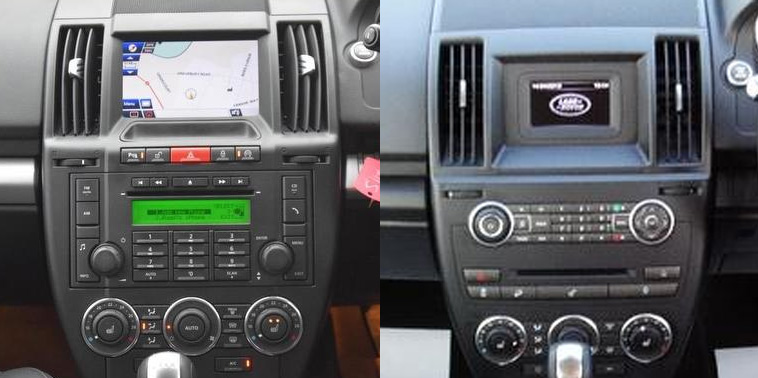
The dashboard on the left is the 2006 - 2013 model. The dashboard to the right is the 2013 and 2014 facelift model.
Fitting parts are available for the earlier 06-13 model, but NO SOLUTION is available for the 13-14 model
The Fiat Fullback is Based on the Mitsubishi L200 / Triton with only minor external cosmetic chnages.
The Holden Commodore VE, and its badge engineered versions the Vauxhall VXR8 and the Pontiac G8, have the climate controls integrated into the original radio.
To replace the original radio we have kit FK-559 which includes new dual zone automatic climate controls built into the new radio fascia with a digital display. This is will only fit cars with original dual zone climate control - either manual or automatic - and won't fit cars with original single zone climate control. We do not have a solution for cars with original single zone climate control.
Please see below for examples of original single zone and dual zone climate controls:


Ford OEM Navigation (With Climate controls built into the head unit)
Some Ford OEM navigation systems have a specific unit where the climate controls are built into the radio itself.
This is usually found on Titanium X Sport and Powershift models.
Unfortunately we are unable to provide a solution at this time.
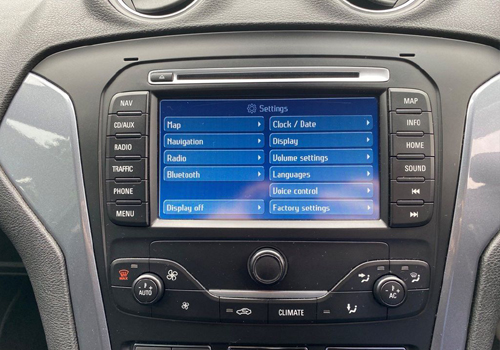
Ford SYNC 3 (2016 ONWARDS)
Most Ford models that were built from the end of 2016 onwards will feature the latest version of SYNC 3 which is easily distinguishable from SYNC 2. The new Ford Fiesta will also feature SYNC 3 on the Zetec trim and above as standard.
All new Ford Fiestas feature SYNC 3 Technology. This consists of either a dash mounted 6.5" or 8” colour touchscreen with pinch-and-swipe gestures. You can also use your voice to make calls, control your entertainment, and even input a destination to your navigation system.
SYNC 3 Includes all the features as the basic system, plus the following:
- 6.5- or 8-inch color touchscreen with easy-to-read text and icons
- Capacitive touch technology requires just a light tap or swiping and pinching for some features with available navigation system
- Touchscreen responds with impressive speed
- Enhanced voice recognition
- Five-way controls on the steering wheel


OUR FITTING SOLUTIONS
Currently we do have a head unit upgrade solution for this.
Our camera interface (27-317) will allow you to add a camera to your vehicle however Vehicle Coding is required.
Still unsure which SYNC system you have? Please visit our technical documents for more information
The Mercedes-Benz GLB-Class (model code X247) is a five-door compact luxury crossover SUV produced by Mercedes-Benz. It was unveiled on 10 June 2019.
The Isuzu Elf is known also known as the Grafter in the UK market and as the N-Series outside Asia.
Models with original radios have Mitsubishi style plugs, where as others have ISOs and radios fitted by their local importer (usually Clarion or Kenwood models) - some models have 24 volt electrics and will need a voltage dropper to change the radio.
The Toyota Aristo was introduced in 1991 to Japan with the Lexus GS appearing for export in 1993.
No radio upgrade solution
The GT-R factory radio contains various vehicle settings including Gauge display etc. Unfortunately we have no radio upgrade solutions that can retain this.
No Double DIN solution is available.
No Double DIN solution is available.
In 2013 Mini began producing the third generation of their popular hatchback with model codes F55 for the 5 door hatchback and F56 for the 3 door.
The older second generation (R57) convertible continued to be offered alongside the newer hatchbacks until 2015 when the new F57 convertible was launched.
The new MINI was released by BMW for the 2002 model year in three specifications:
One and Cooper 3 door hatchback (R50) 2002-2006
One, Cooper and Cooper S convertible (R52) 2004-2008
Cooper S 3 door hatchback (R53) 2002-2006
While the first generation of Mini hatchback was replaced by the second generation (R56) in 2007, the convertible continued to be sold until its replacement arrived in 2008.
An optional amplified Harmon Kardon sound system was available. mostly fitted to cars with the Boost CD player or navigation system. A different wiring harness is needed for these cars when changing the radio (29-628HKM) and the standard speaker adapter cables will not fit these cars.
Models with factory navigation can have either a CD player or cassette player. The navigation system is separate to the radio and runs from its own DVD player, so has no bearing on what parts are needed to change the radio.
The second generation of Mini 3 door hatchback (R56) began production in 2006, replacing the first generation hatchback and ran until 2014 when it was replaced by the third generation (F55 & F56) vehicles.
The Second generation of convertible (R57) was added to the line up later in 2009, replacing the 1st generation R52, and then continued to be produced until it was replaced in 2015.
The Scion iA was discontinued after one model year with the discontinuation of the Scion brand. From 2016 until 2020 as the Toyota Yaris iA. it is not based on the European Toyota Yaris and is a lightly disguised Mazda 2.
Seat Ibiza mk4
Production years 2008 – 2014
The Seat Ibiza mk4 was released in 2008, in 2014 the car had a facelift. The facelift included an update head unit which had the hazard button and the passenger airbag light moved from the button cluster by the gear stick to the radio face. Because of this special parts are required for the 2014 onward model when changing the head unit.
Below are pictures of the earlier model dashboard and the facelifted dashboard with the buttons in the new positions.
The older model to the left has the hazard, ESP and airbag buttons on the button cluster down by the gear stick. The facelifted model to the right has the hazard, ESP and airbag buttons built into the radio.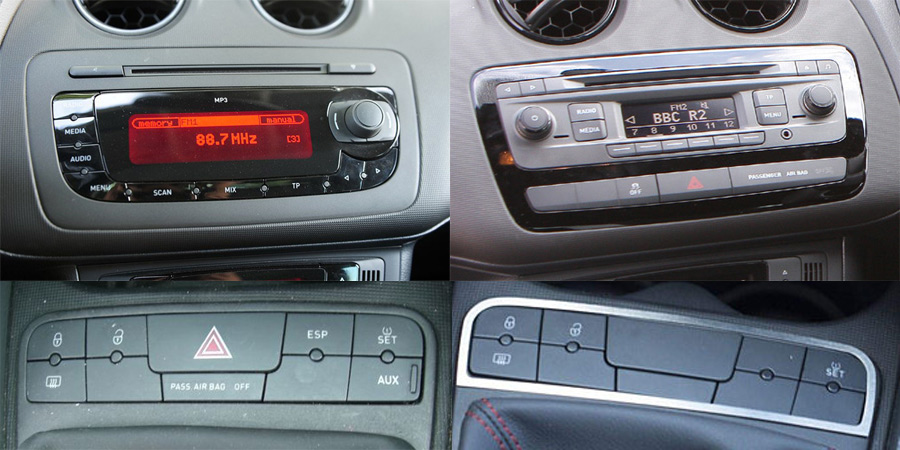
In order to fit a new head unit into the facelift model, a button panel from an earlier model with the corresponding buttons is required. Our fascia fitting kit includes the harness adapter to extend the connection to the new button panel.
Depending on the specification of the car, there are various different button panel combinations available. A new button panel is required to combine the existing button panel by the gear stick with the buttons on the radio panel.
NOTE: The AUX connection is not relevant as this only works with the original radio.
The 2003 Suzuki Ignis 5 door is based on the Chevrolet / Holden Cruze (which itself was a modified Suzuki Ignis FH) and was built in Hungary separate from the Japanese production of the Chevrolet and Holden versions. While very similar, one major difference between the two cars is the radio, with the European version having it's own radio made by Baupunkt and of the same shape as contemporary Vauxhall/ Opel radios. Versions built in Japan have a single DIN radio situated lower in the dashboard.
The IX35 (2010 - 2015) Car models had a total of 5 different model variants. Please see below a breakdown of these variants from basic to Premium.
About the 'S' model variant
The 'S' variant of Hyundai IX35 models was manufactured from 2010-2015 and made to basic specifications with a standard audio radio head unit and no controls on the steering wheel (Pictured below)
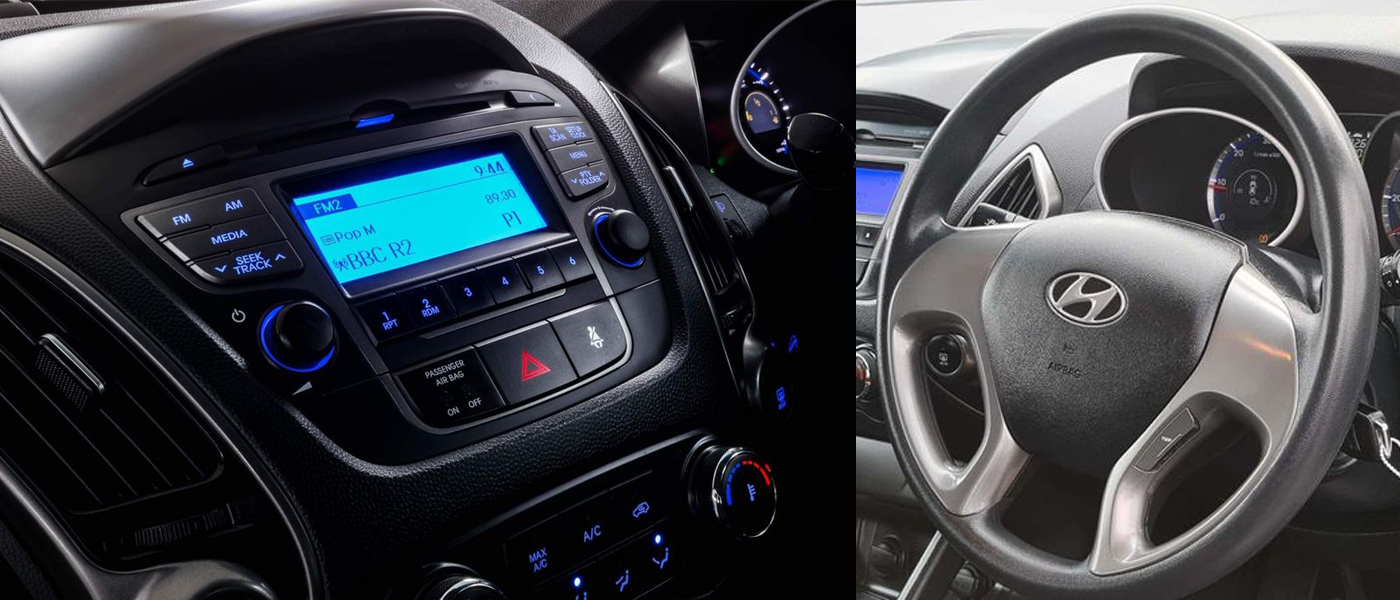
About the 'SE' model variant
The 'SE' variant of Hyundai IX35 models was manufactured from 2010-2015. These models included a few more additions to the specifications of the basic 'S' models and included a standard audio radio head unit with the addition of audio controls on the steering wheel (Pictured below)
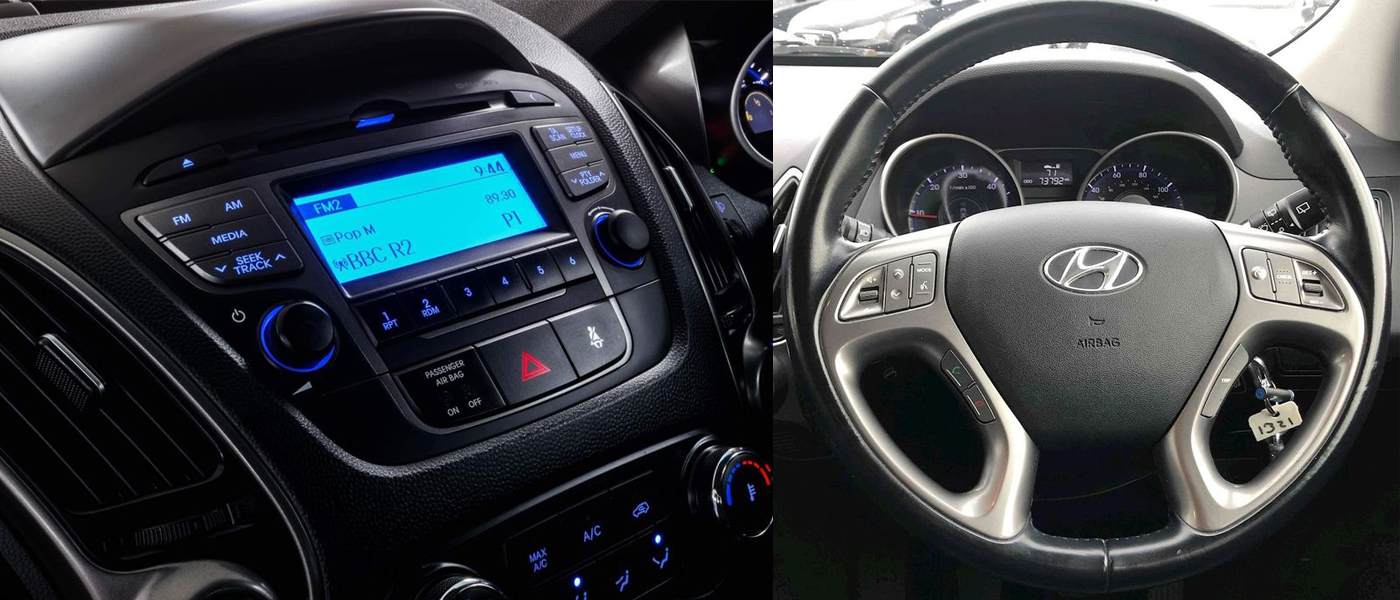
About the 'SE-NAV', 'PREMIUM' and 'PREMIUM PANORAMA' model variant
The 'SE-NAV', 'PREMIUM' and 'PREMIUM PANORAMA' variants of Hyundai IX35 models were manufactured from 2010-2015. These models were of the higher spec IX35 models and contained extra features such as 7" Touchscreen Satellite Navigation (Pictured left below) , Reversing Camera and Premium 7 Speaker Sound System including Sub Woofer (Pictured below right) and Shark Fin Antenna.
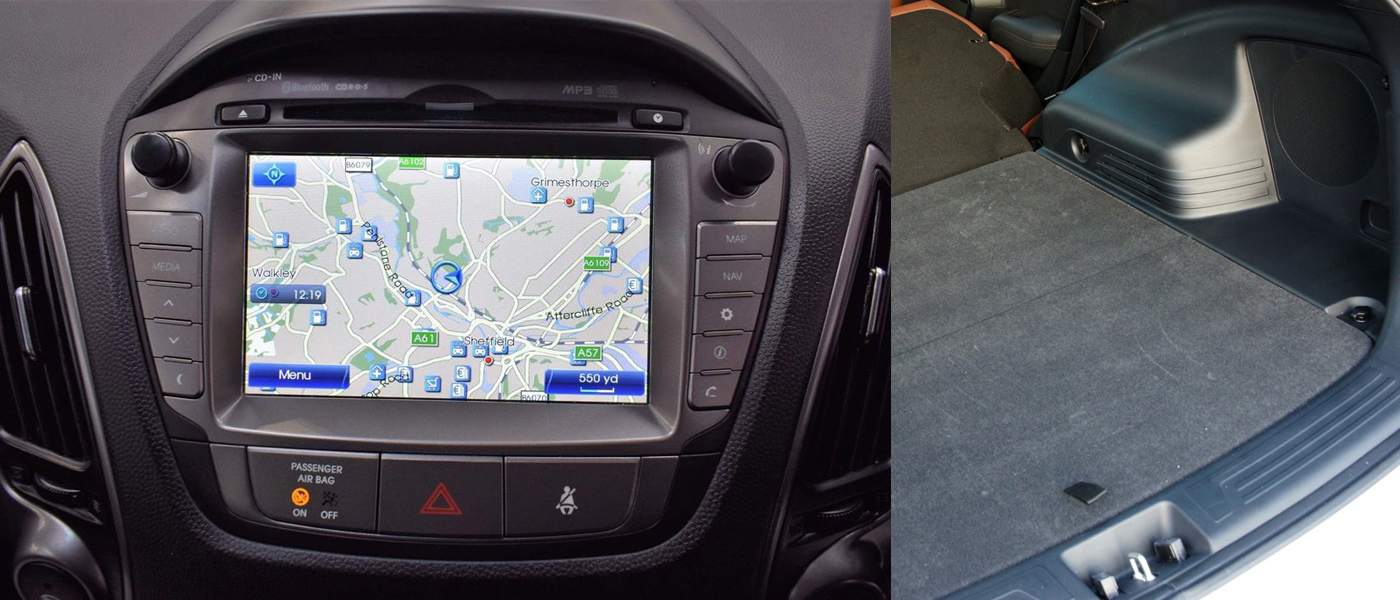
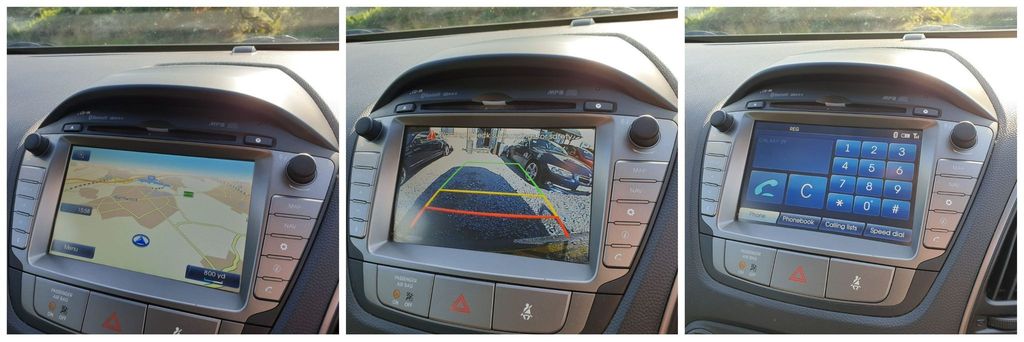
Does my IX35 have a Premium Sound System?
Although it is stated that all 'SE-NAV', 'PREMIUM' and 'PREMIUM PANORAMA' variants of Hyundai IX35 have premium sound, another way to check if the subwoofer is fitted in the right hand side of the boot space. Simply open the boot and check to the right hand (Drivers side). If there is a porthole then your vehicle doesn't have a factory fitted sub and is likely not Premium Sound. If you have what appears to be a speaker then it is more than likely Premium Sound (See below)
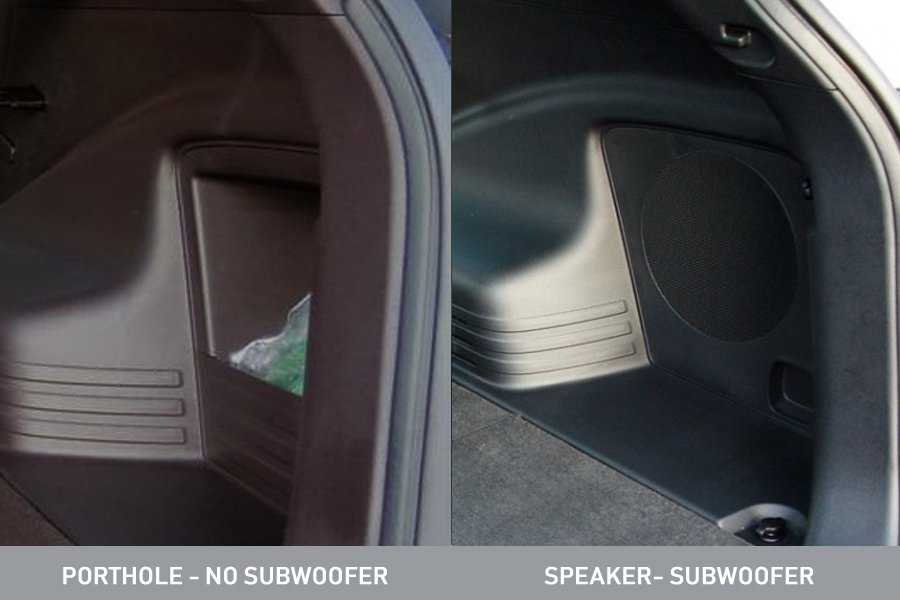
What are the differences between SE-NAV, PREMIUM and PREMIUM PANORAMA?
The only difference with the SE-NAV and PREMIUM/ PREMIUM PANORAMA is that the later two models have stop/start function factory fitted. The only added difference with PREMIUM PANORAMA is that it has a Panoramic Sunroof. Please see the features list below with the highlighted differences
If you are still unsure what parts you need please contact our technical team at [email protected]
The Dacia Jogger is a 7 seater estate car, based on the underpinnings of the Sandero hatchback.
FORD SYNC 1 in KA+ (2016 ONWARDS)
Ford SYNC 1 technology was introudced to the Ford KA+ in 2016 and consists of a 4.2-inch color cluster display or horizontal two-line display.
SYNC has a center display that shows basic information, such as caller ID, song titles, a digital clock, and temperature.
Which cars have SYNC 1.0?
The following list is subject to trim level:
Fiesta (2008 – 2017)
Focus (2011-onwards)
C-Max/Grand C-Max (2011-onwards)
B-Max (2012-onwards)
Ka+ (2016-onwards)
Ecosport (2012-onwards)
Grand Tourneo Connect (2012-onwards)
Kuga (2013-onwards)
It’s worth noting that the functions you get through SYNC will vary depending on the model year. For example, in March 2015, SYNC was updated to display track names from mobile phone devices, but couldn’t do this beforehand.
The Dacia Logan was initially only sold in Eastern Europe, but eventually was sold in left hand drive markets in Western Europe and made its way to the rest of the world under various name plates including Renault Logan, Nissan Aprio and Renault Tondar.
The saloon body style was initially the only offering, but was soon joined in 2006 by the estate version labelled as MCV and a van in 2007.
Finally a pickup version was launched in late 2007, Dacia discontinued the pickup with the rest of the first generation Logan line up in 2012, but in South Africa a version called the Nissan NP200 'Backie' continues to be built from 2008 onwards.
Originally fitted with a single DIN radio or a blanking plate, a large replacement fascia panel is needed to fit a double DIN unit.
The second generation Dacia Logan was sold as a saloon version of the Sandero in Europe. Only the MCV estate and a raised MCV Stepway version with plastic cladding were sold in the UK
The Mitsubishi Magna was a large sedan produced by Mitsubishi Motors Australia. The third generation built between 1996 and 2005 were also named Verada and Solara in their home market depending on the trim level.
It was exported to New Zealand, Japan and the USA as the Mitsubishi Diamante.
It received a number of minor facelifts in its life time and a major facelift (easily seen from the change from rectangular headlamps to larger triangular ones) in 2003. These changes do not affect what is needed to change the radio and all come as standard with a double DIN sized aperture for the radio.
Renault Megane III
Production years 2008 - 2016
The third generation of the Renault Megane had a facelift in 2012. The earlier models have quadlock connectors at the back of the radio, facelift 2012 models have the newer Renault/Dacia style white radio connectors. For cars around the facelift change it is best to remove the head unit to check what type of connector has been used.
It is not possible to fit a double din head unit into a Megane III.
On MG3s with DAB from the factory, this is not handled by the original head unit, there is a seperate receiver which decodes the DAB input and feeds it to the head unit as an analogue signal. The DAB module is located in the passenger (near side) foot well behind a trim panel on the back of the centre console which is held in place with a plastic trim clip.
Remove the panel and the DAB module is visible behind. The green Fakra E connection going into the module is the DAB antenna, use a 21-037 (Fakra to SMB antenna adapter and a fakra extension to connect the original DAB antenna to the back of a new after market radio with DAB.
Based on the R56 Mini Hatchback, the R58 Coupe was launched in 2011, followed closely by the Roadster in 2012.
They were both discontinued without replacement in 2015
Between 2010 and 2012 the Geely MK was exported to Western Australia and New Zealand
It could not be sold in other Australian states due to a lack of Active Stability Control that was mandated elsewhere.
As a cheap car it had a brief surge of popularity as an alternative to a used car, but when stricter safety standards were introduced the MK was taken off sale.
The radio in the MK uses the same connectors and pinning as most Toyota vehicles.
|
Location |
Speaker
Ring |
Speaker Cable |
Size |
|
Front Door |
165mm (6.5”) |
||
|
Rear Door |
100mm (4”) |
||
|
Front Door
Tweeters |
N/A |
30mm (1”) |
|
|
Centre
Speaker |
100mm (4”) |
||
|
Dash Mid-Range |
100mm (4”) |
||
|
A-Pillar
Mid-Range |
N/A |
65mm (2.5”) |
|
|
Rear Hatch |
100mm (4”) |
||
|
Subwoofer |
N/A |
200mm (8”) |
|
Location |
Speaker
Ring |
Speaker Cable |
Size |
|
Front Door |
130mm (5.25”) |
||
|
Rear Door |
130mm (5.25”) |
||
|
Dash Tweeters |
N/A |
30mm (”) |
|
|
Centre
Speaker |
65mm (2.5”) |
|
Location |
Speaker
Ring |
Speaker Cable |
Size |
|
Front Door |
165mm (6.5”) |
||
|
Rear Door |
130mm (5.25”) |
||
|
Dash Tweeters |
N/A |
30mm (1”) |
|
|
Centre
Speaker |
65mm (2.5”) |
||
|
Dash Mid-Range |
65mm (2.5”) |
||
|
Rear Hatch |
65mm (2.5”) |
||
|
Subwoofer |
N/A |
N/A |
200mm (8”) |
|
Location |
Speaker
Ring |
Speaker Cable |
Size |
|
Front Door |
130mm (5.25") |
||
|
Front Door (Premium) |
165mm (6.5") |
||
|
Rear Door |
165mm (6.5”) |
||
|
Dash Tweeters |
N/A |
30mm (1”) |
|
|
Centre
Speaker |
65mm (2.5”) |
||
|
Dash Mid-Range |
65mm (2.5”) |
||
|
Rear Hatch |
65mm (2.5”) |
||
|
Subwoofer |
N/A |
N/A |
200mm (8”) |
|
Location |
Speaker
Ring |
Speaker Cable |
Size |
|
Front Door |
165mm (6.5”) |
||
|
Rear Door |
100mm (4”) |
||
|
Front Door
Tweeters |
N/A |
30mm (1”) |
|
|
Centre
Speaker |
100mm (4”) |
||
|
Dash Mid-Range |
100mm (4”) |
||
|
A-Pillar
Mid-Range |
N/A |
65mm (2.5”) |
|
|
Rear Hatch |
100mm (4”) |
||
|
Subwoofer |
N/A |
200mm (8”) |
Convers+ (Titanium/ Titanium X models only)
Convers+ is a screen system in the instrument cluster, usually only found on Titanium and Titanium X models of the Mondeo.
This feature, as well as the voice command, is usually lost when fitting an aftermarket radio to the car.
Unfortunately we have no solution for this at this time.
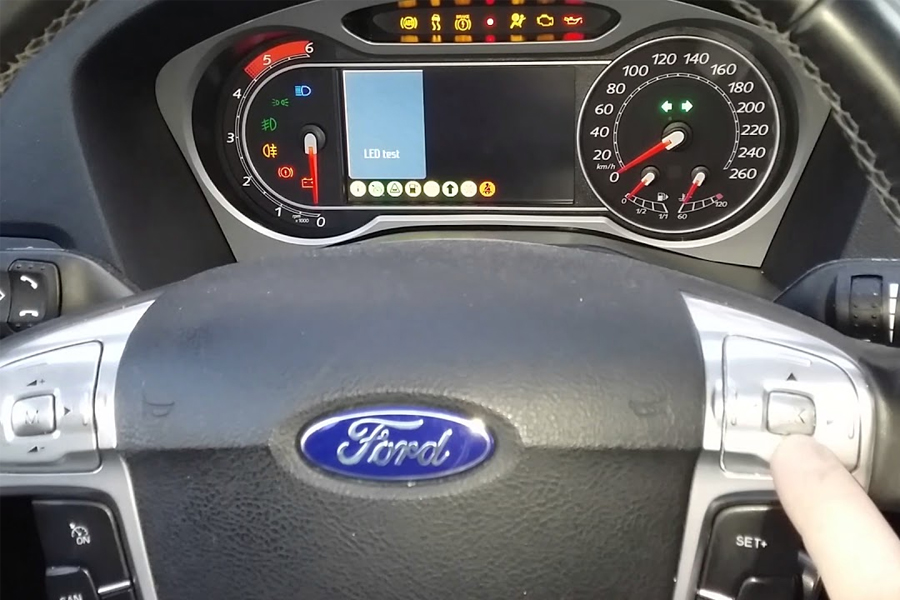
Above is an example of the Convers+ system on the instrument cluster
Convers+ (Titanium/ Titanium X models only)
Convers+ is a screen system in the instrument cluster, usually only found on Titanium and Titanium X models of the Mondeo.
This feature, as well as the voice command, is usually lost when fitting an aftermarket radio to the car.
Unfortunately we have no solution for this at this time.

Above is an example of the Convers+ system on the instrument cluster
OUR FITTING SOLUTIONS
Currently we do have a head unit upgrade solution for this.
Our camera interface (27-317) will allow you to add a camera to your vehicle however Vehicle Coding is required.
FORD SYNC 2 (2015 ONWARDS)
The second generation SYNC has a touchscreen infotainment system that has lots of features that make your in-car connected experience more useful and easy to use. SatNav comes with SYNC 2 as standard and you can also control the air-conditioning through the touchscreen or even voice commands, as well as the traditional controls.
SYNC 2 Includes all the features as the basic system (except for SYNC AppLink), plus the following:
- 6.5- 8-inch color touchscreen, usually split into 4 sections: audio, satnav, climate and phone
- Media hub with two USB ports, SD card reader, and input jacks
- Five-way controls on the steering wheel
WHAT CARS HAVE SYNC 2?
Subject to trim level:
Focus (2015-2016)
Mondeo (2015-onwards)
Kuga (2016-onwards)
S-Max (2015-2017)
C-Max (2015-2017)
Galaxy (2015-2017)
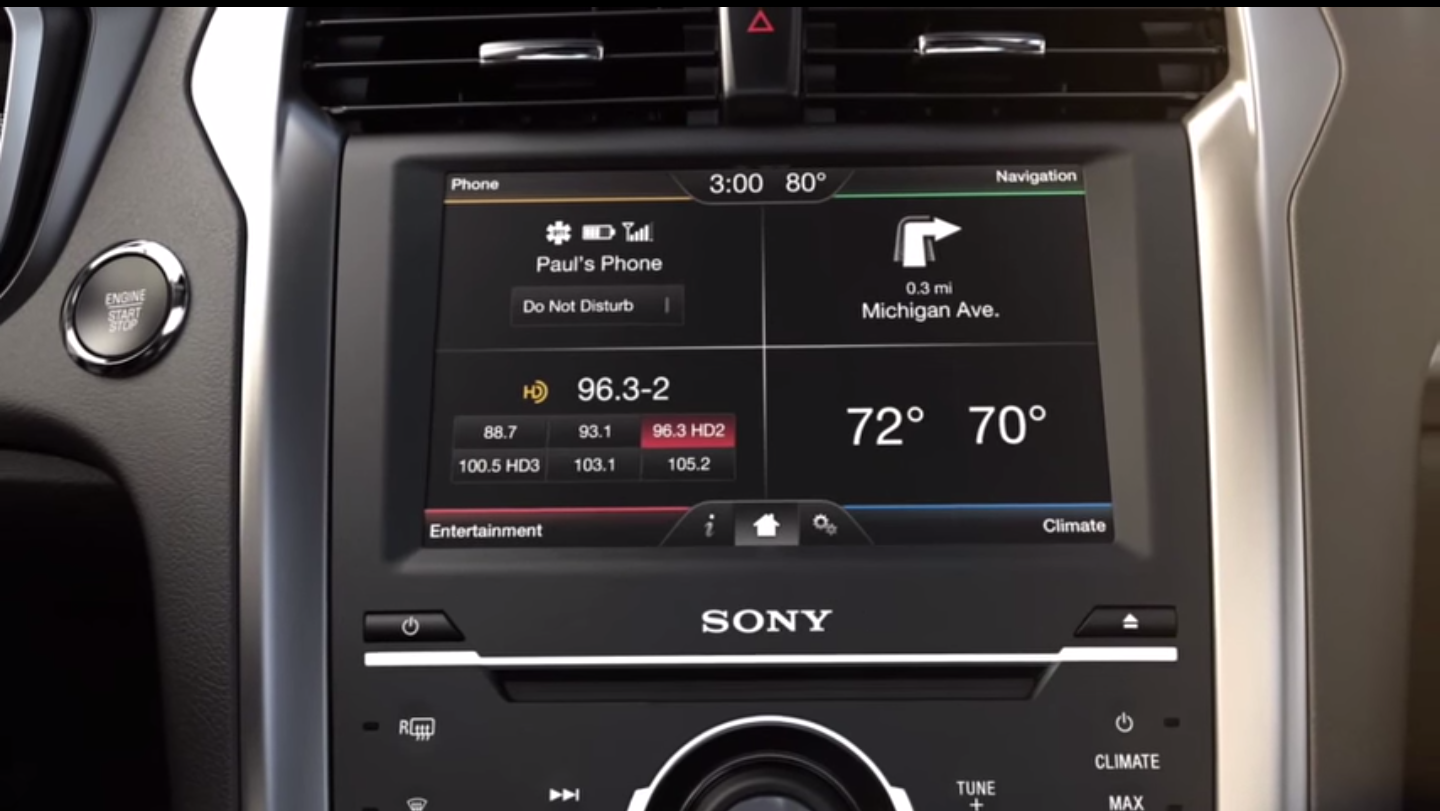
Above is an example of SYNC 2 technology in the Ford Mondeo 5th generation (2015 onwards)
For 2022, in line with Vauxhall/Opels owners; groupe PSA, merging with Fiat Chrysler Automobiles the previous year the Movano changed from the Renault Master platform to The Fiat Ducato X290 platform.
The first of the new Movanos, like the Peugeot Boxer and Citroen Relay still use the older X290 dashboard, unlike the Fiat Ducato which had a dashboard update in 2021.
The Isuzu MU-X is a 7 seat SUV based on the platform of the D-MAX pickup. Designed in co-operation with General Motors, the MU-X is very closely related to the Chevrolet Trailblazer and Holden Colorado 7, and early models of these cars share the same radios.
From 2013 to 2017 the MU-X used the same radios as the D-MAX, but from 2017-2020 the radio shape changed slightly to have a rounded top with a silver trim surrounding the radio and centre vents. Due to the slight change in shape, there is not a fascia panel available for these vehicles and we only have the parts available to change the radio on the earlier vehicles.
The 2020 model MU-X received a facelift, along with the related D-MAX, which included a new front fascia, re-profiled rear hatch and an improved interior with a new radio type and phone buttons on the steering wheel.
The third generation Murano is only produced in left-hand drive.
Mazda MX-5 NC (Miata) third generation
Production years 2005 - 2015
The third generation Mazda MX-5 was produced from 2005 to 2015. There was a facelift at the beginning of 2009.
It is very difficult to identify the pre and post facelift models from looking at the radio alone as they are almost identical, there are subtle changes to the moulding which do mean different fascia panels are needed when changing the head unit. The easiest way to identify the facelift change is by the styling change of the fog lights as shown in the image below.
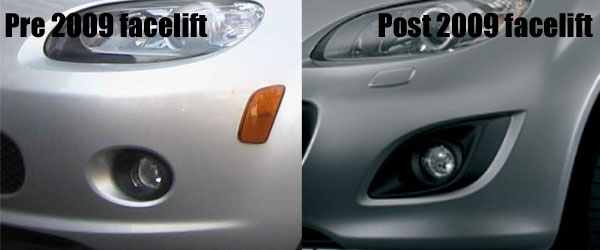
The Perodua Myvi is a lightly re-styled Daihatsu Sirion/Boon, built in Malaysia and shares the same radio.
The Nissan Navara D40 and Nissan Pathfinder R51 share a basic platform and were built with the same radio options.
On cars with a basic (non-navigation) radio, the original radio is standard double DIN sized and can be replaced without changing the radio fascia, just use the original mounting brackets to fit the new radio. You will need different ISO leads or steering wheel control interfaces depending on the type of basic radio fitted. Please use the radio options listed against the cars on our website to see the relevant parts.
There were two different navigation systems, the first fitted to cars between 2005 and 2010:

And the second on cars between 2010 and 2016:

On cars built between 2005 and 2010, the easiest way to change the radio is to replace the central dash panel, along with the radio mounting brackets for those from a car with the basic radio. This includes the air con controls and the pocket with a lid above the radio. We do not stock this part and it seems to be no longer available from Nissan dealers, when you have found a dash panel it should look like the below:
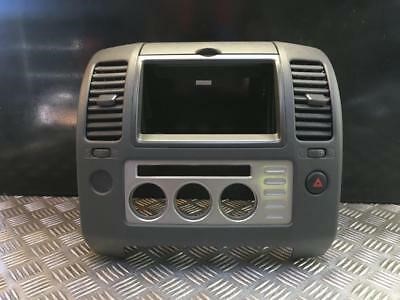
There were changes to the air conditioning panel depending on the model year and whether the vehicle is fitted with automatic climate control, manual air conditioning or a basic heater/fresh air system. If your vehicle has controls for the rear cabin ventilation in the air conditioning panel, you may have to cut holes in the new dash panel for these controls.
The second way to fit a radio is to remove the original satnav screen, which is slightly larger than double DIN, disconnect the original radio control and fit the new radio into the space left by the screen using a universal trim such as 50-056 which will require significant trimming and modification to fit. Neither fitting option is easy and we'd recommend that this system is only changed by a professional car audio fitter.
For the later 2010 - 2016 navigation system, there is currently no solution available to change the radio.
The Perodua Nippa was based on the Daihatsu Mira L200. It was known as the Perodua Kancil in most markets.
The Isuzu Oasis was a badge engineered 1st Generation Honda Odyssey sold in the US and Japanese markets.
The first generation Honda Odyssey was also sold as the Honda Shuttle in Europe and the Isuzu Oasis in Japan and the USA. In 1999 the USA received its own model variant, different to the international model sold in most other markets.
In 1999 the second generation Honda Odyssey (RA6/7/8/9) was launched. The North American model is different to that sold in the rest of the world.
Models with original navigation do not have room for a double DIN radio as the original radio is located in a single DIN slot just above the gear selector and the navigation/camera screen is where the radio is located on the lesser specified models.
Partner 1 And Berlingo 1 was proiduced from 1996 to 2013 with an interior facelift in 2002
The Nissan Navara D40 and Nissan Pathfinder R51 share a basic platform and were built with the same radio options.
On cars with a basic (non-navigation) radio, the original radio is standard double DIN sized and can be replaced without changing the radio fascia, just use the original mounting brackets to fit the new radio. You will need different ISO leads or steering wheel control interfaces depending on the type of basic radio fitted. Please use the radio options listed against the cars on our website to see the relevant parts.
There were two different navigation systems, the first fitted to cars between 2005 and 2010:

And the second on cars between 2010 and 2016:

On cars built between 2005 and 2010, the easiest way to change the radio is to replace the central dash panel, along with the radio mounting brackets for those from a car with the basic radio. This includes the air con controls and the pocket with a lid above the radio. We do not stock this part and it seems to be no longer available from Nissan dealers, when you have found a dash panel it should look like the below:

There were changes to the air conditioning panel depending on the model year and whether the vehicle is fitted with automatic climate control, manual air conditioning or a basic heater/fresh air system. If your vehicle has controls for the rear cabin ventilation in the air conditioning panel, you may have to cut holes in the new dash panel for these controls.
The second way to fit a radio is to remove the original satnav screen, which is slightly larger than double DIN, disconnect the original radio control and fit the new radio into the space left by the screen using a universal trim such as 50-056 which will require significant trimming and modification to fit. Neither fitting option is easy and we'd recommend that this system is only changed by a professional car audio fitter.
For the later 2010 - 2016 navigation system, there is currently no solution available to change the radio.
All models of Polestar 2 have an amplifier. Great care must be taken when choosing replacement speakers as the originals are 7 ohm.
100mm mid range speakers are fitted in the front doors and centre dashboard with 165mm full range speakers in the rear doors.
It is not possible to change the head unit in these cars.
Volkswagen Polo mk IV (9N) forth generation
Production years 2002 - 2009
The forth generation Volkswagen Polo had a facelift mid production around 2004. The earlier models had original tape cassette headunits with optional CD changers, these cars had ISO connectors at the back of the radio. The later facelift models have a double DIN sized original CD player head unit, these later models have a Quadlock connector at the rear of the radio.
It is very easy to differentiate between the pre and post facelift models by looking at the headlight styling, see the below picture.
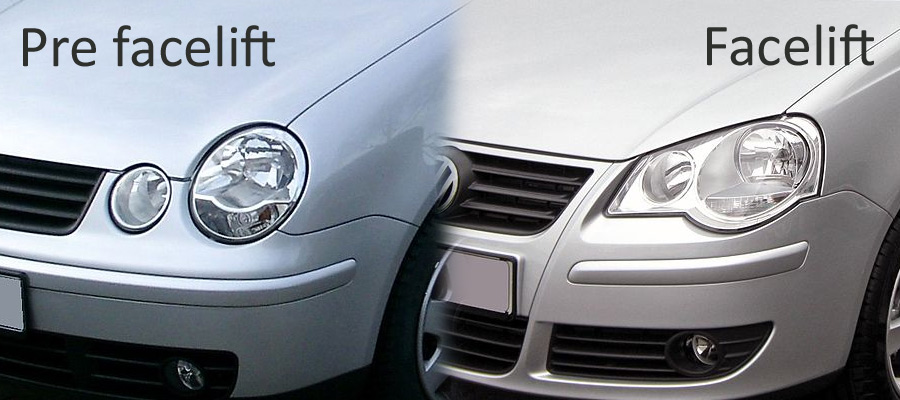
Volkswagen Polo mk IV (9N) forth generation
Production years 2002 - 2009
The forth generation Volkswagen Polo had a facelift mid production around 2004. The earlier models had original tape cassette headunits with optional CD changers, these cars had ISO connectors at the back of the radio. The later facelift models have a double DIN sized original CD player head unit, these later models have a Quadlock connector at the rear of the radio.
It is very easy to differentiate between the pre and post facelift models by looking at the headlight styling, see the below picture.

The Toyota ProAce City was revealed in 2019 as a badge engineered version of the Groupe PSA small van. Toyota offers the ProAce city as its smallest (non car derived) van in European markets rather than the TownAce which it sells in Asian markets,
Is my Audi Q3 Low Version (RMC) OR High Version (HN+R)?
Frist check to see if your car has original navigation (OEM GPS) or not.
Usually, if the car has "HN+R " in the MMI setup menu, it contains factory navigation (MMI 3G+ High version).
If the car has "RMC" (low version), normally it doesn't have an original navigation system.
Their power harnesses are also different (As shown below)
Land Rover, Range Rover L322 (SE, HSE, Vogue)
2002 - 2010
2002 - 2005 models
The earlier model Range Rover L322 cars had two types of head units in the dashboard. The basic Multi Information Display (MID) head unit, and the high line Multi Function Display (MFD) head unit.
The basic MID unit was available as a cassette tape player, a CD player or a Mini Disc player. The high line MFD head unit had a cassette player behind the motorised screen and a CD changer in the glove box, the tuner radio module is located in the rear of the vehicle in the rear left quarter panel.
Below is an image of the basic MID head unit
Below is an image of the high line MFD head unit
There are also three options for the audio system. Non amplified audio system, Power amplifier and DSP (Digital Signal Processor) amplifier.
Basic audio.
The non amplified audio system has two way speakers in the front doors and single speakers in the rear doors. Audio is supplied directly from the head unit in cars with the basic MID head unit system, or from the tuner radio module in the rear left quarter panel on cars that have the high line MFD head unit system.
Below is a diagram of the non amplified basic audio setup.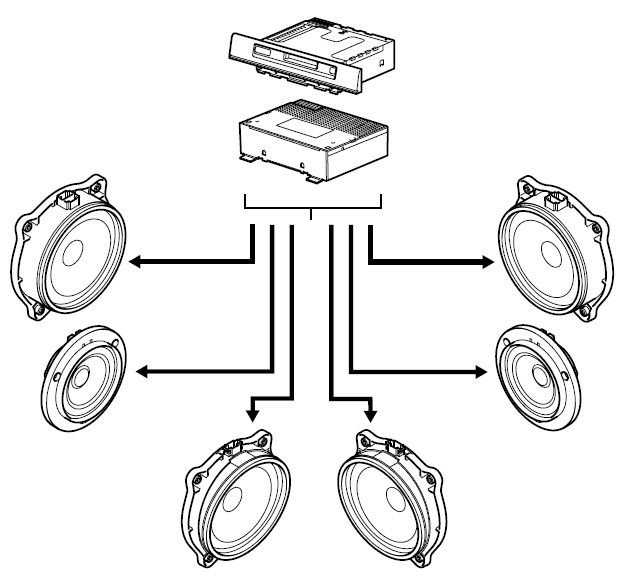
Power amplifier.
Some cars have a power amplifier, these amplifiers are switched on by a +12V turn on signal, this is the same signal as the antenna turn on. The amplifier receives a normal audio signal from the basic head unit or tuner radio module and then drives the speakers in the car. Cars with the power amplifier will have single speakers in the rear doors, three way component speakers (low, mid and tweeters) in the front doors and a centre speaker on the dashboard. The centre speaker is bridged between the front door mid range speakers.
Below is a diagram of the power amplifier audio setup.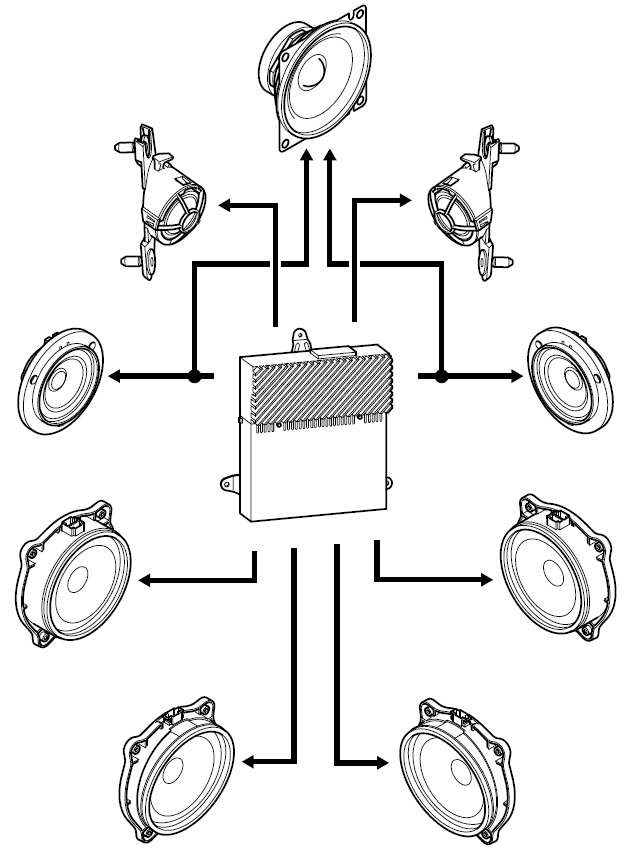
Below is an image of the power amplifier. Note the styling of the heatsink fins and the single large connector with locking latch, this is how the power amplifier can be differentiated from the DSP amplifier.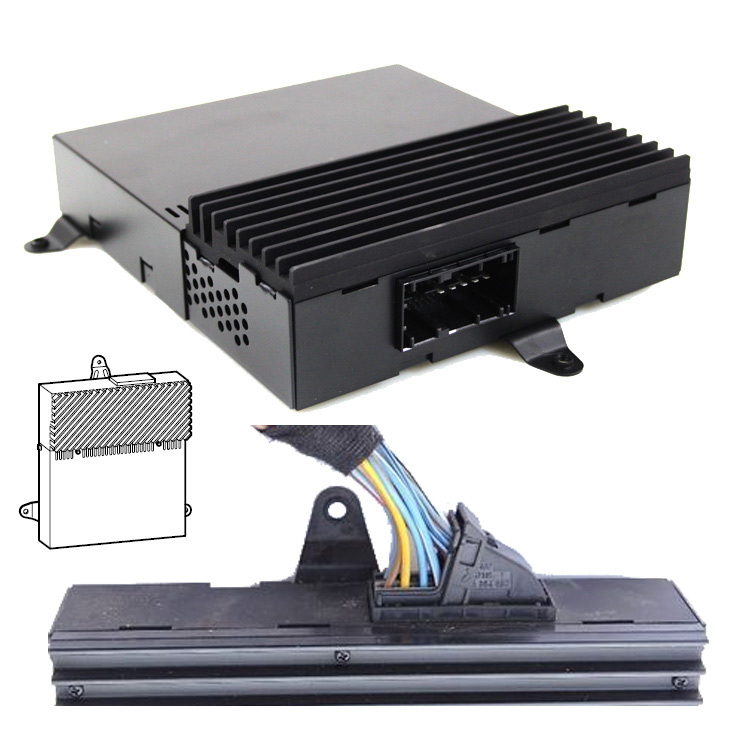
DSP (Digital Signal Processor) amplifier.
Some cars have a DSP amplifier, these amplifiers are switched on by an I-Bus data signal and receives a data audio signal from the basic head unit or the tuner radio module. Cars with the DSP amplifier will have single speakers in the rear doors, three way component speakers (low, mid and tweeters) in the front doors, a centre speaker on the dashboard and a dual subwoofer in the boot (in the rear left quarter panel, forward from the amplifier and tuner radio modules). The centre speaker is bridged between the front door mid range speakers.
Below is a diagram of the DSP amplifier audio setup.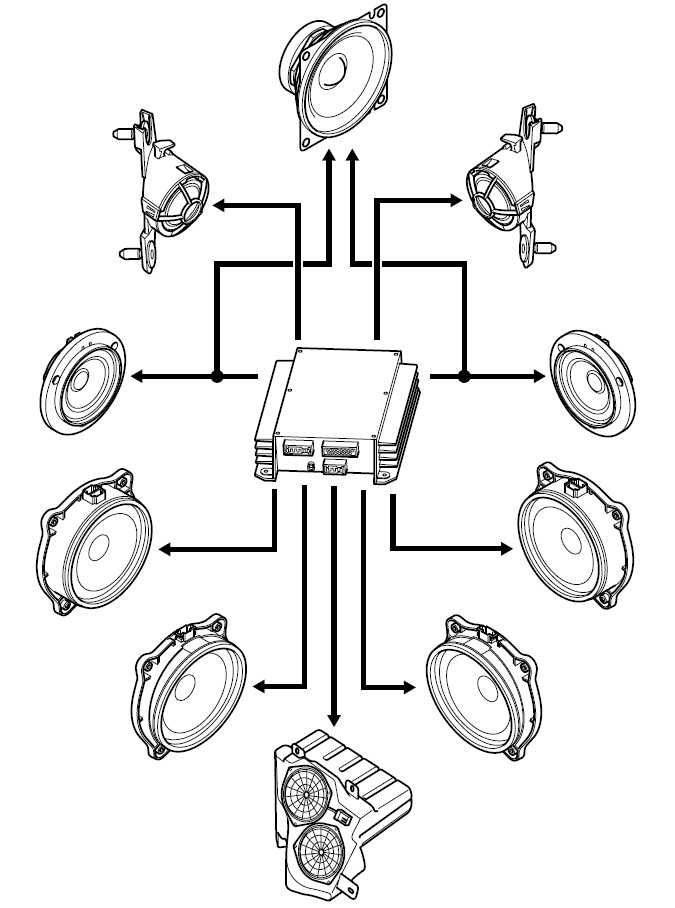
Below is an image of the DSP amplifier. Note the styling of the heatsink on the sides of the amplifier and the three connectors, one large round pin connector and two smaller connectors with locking latches, this is how the DSP amplifier can be differentiated from the power amplifier.
Setup varieties.
Because of the head unit and audio options, there are 6 setup possibilities for the 2002 - 2005 model cars.
Basic head unit with basic audio
Basic head unit with Power amplifier
Basic head unit with DSP amplifier
High line head unit with basic audio
High line head unit with Power amplifier
High line head unit with DSP amplifier
There are three common setups that are usually seen in the cars, they are the basic head unit with basic audio, basic head unit with power amplifier and the high line head unit with DSP amplifier options. The other options are fairly rare to see.
No head unit solution at this time.
The original radio of the 2019 onwards Toyota Rav4 sits proud of the dashboard. Due to this design, only after market radios with either a lower single DIN chassis such as the Alpine ILX702D or a modular radio like the Pioneer SPH-EVO64DAB will fit in the dashboard. A full sized double DIN radio or upper single DIN chassis such as Sonys do not fit.
The Isuzu Rodeo nameplate was used on a variety of vehicles in different markets, this pickup truck was known in some non-European markets as the D-Max.
It was sold in Australasia as the Holden Rodeo from 2003-2008 and later as the Holden Colorado from 2008-2012, during which time Isuzu also sold the nearly identical Isuzu Rodeo in this market.
CLASS (W222) 2014 - 2018
WHAT IS NTG5?
Mercedes-Benz NTG5 Comand is found on several Mercedes models from 2014 onwards (see compatibility list). It consists of a 8.4" LCD monitor, usually located on top of the centre console (Pictured below) and is controlled by a touch panel on the centre console (also pictured below)
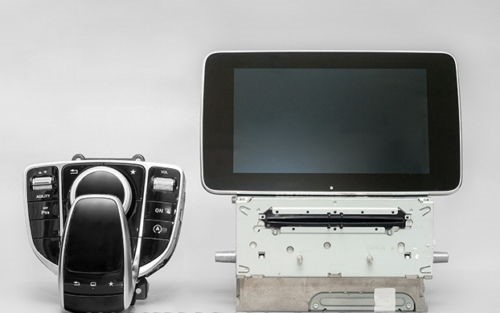
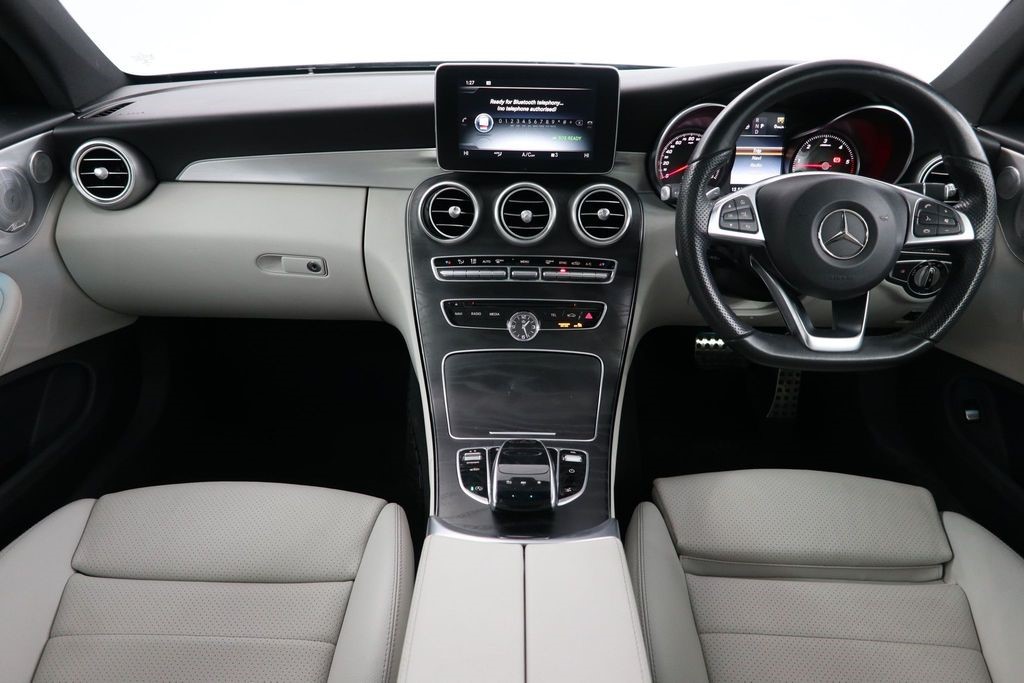
S-CLASS (W222 FACELIFT) 2018 ONWARDS
WHAT IS NTG 5.5 ?
The Comand-APS NTG is the 3rd generation of the NTG 5 era. It was fitted to W213 E-Class cars from 2018 onwards and also replaced NTG 5.2 in some facelifted vehicles, such as the W222 S class and C-Class cars from 2018/ 2019 onwards. Unlike its other NTG 5 relatives, the NTG 5.5 has Apple Car-Play and Android Auto.
S-CLASS (W222 FACELIFT) 2018 > (12.3 INCH TOUCHSCREEN)
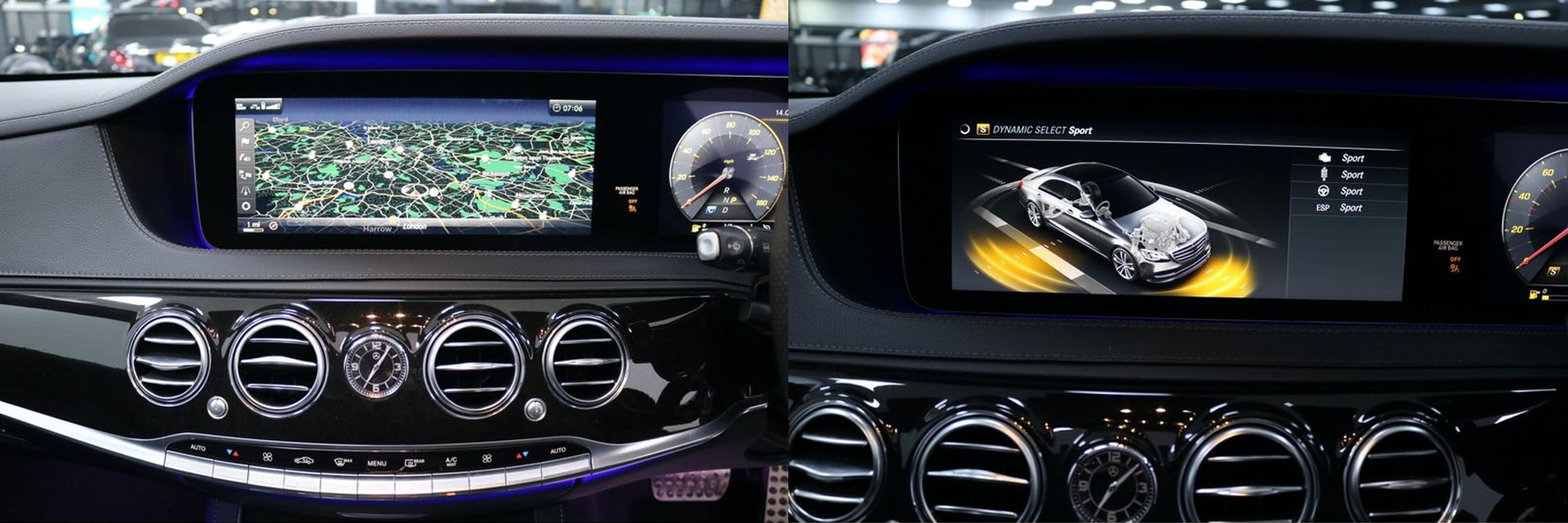
Convers+ (Titanium/ Titanium X models only)
Convers+ is a screen system in the instrument cluster, usually only found on Titanium and Titanium X models of the Mondeo.
This feature, as well as the voice command, is usually lost when fitting an aftermarket radio to the car.
Unfortunately we have no solution for this at this time.

Above is an example of the Convers+ system on the instrument cluster
Ford OEM Navigation (With Climate controls built into the head unit)
Some Ford OEM navigation systems have a specific unit where the climate controls are built into the radio itself.
This is usually found on Titanium X Sport and Powershift models.
Unfortunately we are unable to provide a solution at this time.

OUR FITTING SOLUTIONS
Currently we do have a head unit upgrade solution for this.
Our camera interface (27-317) will allow you to add a camera to your vehicle however Vehicle Coding is required.
FORD SYNC 2 (2015 - 2017)
The second generation SYNC has a touchscreen infotainment system that has lots of features that make your in-car connected experience more useful and easy to use. SatNav comes with SYNC 2 as standard and you can also control the air-conditioning through the touchscreen or even voice commands, as well as the traditional controls.
SYNC 2 Includes all the features as the basic system (except for SYNC AppLink), plus the following:
- 6.5- 8-inch color touchscreen, usually split into 4 sections: audio, satnav, climate and phone
- Media hub with two USB ports, SD card reader, and input jacks
- Five-way controls on the steering wheel
WHAT CARS HAVE SYNC 2?
Subject to trim level:
Focus (2015-2016)
Mondeo (2015-onwards)
Kuga (2016-onwards)
S-Max (2015-2017)
C-Max (2015-2017)
Galaxy (2015-2017)
HOW DO I TELL IF MY VEHICLE IS SYNC 2?
The main screen on a ford SYNC 2 system is split into 4 sections:
- Phone
- Navigation
- Climate
- Entertainment
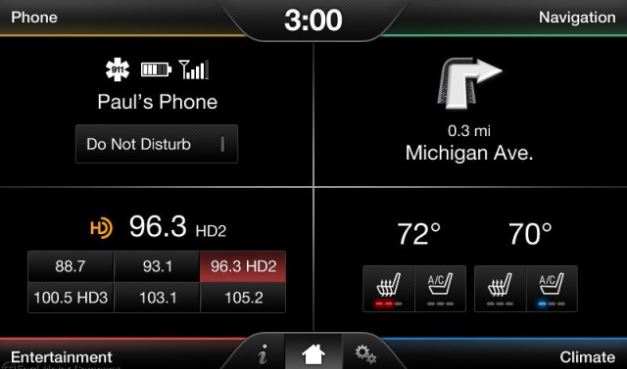
Here is an example of the main screen on a SYNC 2 system with the 4 different sections
Jaguar S types with PREMIUM original audio have an amplifier in the boot which will need to be bypassed if you change the front head-unit
High Performance/ Premium Sound Systems Examples
All Volvo C30/C70/S40 and V50 car models from 2004-2012 had 3 different sound systems:
1. Performance Sound (NON-AMPLIFIED)
This was fitted as the standard sound system for most of these Volvo Models. Although it had a couple of variations in its model years, it typically consisted of a standard 6 or 8 speaker set up system
2. High Performance Sound (Amplified)
This was fitted both as standard on Higher Spec Volvo models and as an optional upgrade. An easy way to tell if your vehicle is fitted with this system is when the radio powers up it will show on the radio display as 'HIGH PERFORMANCE SOUND'
3. Premium Sound (Amplified) Either DYNAUDIO or DOLBY PRO LOGIC II
This was fitted as an optional upgrade. An easy way to tell if your vehicle is fitted with this system is when the radio powers up it will show on the radio display as PREMIUM SOUND' This sound system is easier to identify as their will usually be a DYNAUDIO badge on some of the sound equipment. For E.G. On top of the centre speaker above the radio (Centre Dashboard)
Below are some examples of the sound systems installed on C30 and C70 (2007-2013) car models
Volvo S60, V70 and XC70, 2000 - 2007 second generation.
The Volvo V70 and XC70 second generation was released in 2000. In 2005 they received a facelift which included styling changes to the dashboard. Also, the headlight styling was changed, this makes identifying the face lift models easy.
The correct model year and radio model is important to know to make sure the correct parts are chosen for an installation.
Below is an image of the 2000 - 2005 pre facelift and 2005 - 2007 post facelift dashboards. Note that the 05-07 car has an extra piece of trim surrounding the radio and climate controls. This trim is often silver or wood effect.
Below is an image showing the styling differences between the headlights. The main noticeable difference is that older models had clear plastics over the lights, whereas the facelift cars have orange plastics over the indicator lights. The pictures are of a V70, but the same applies to the S60 and XC70.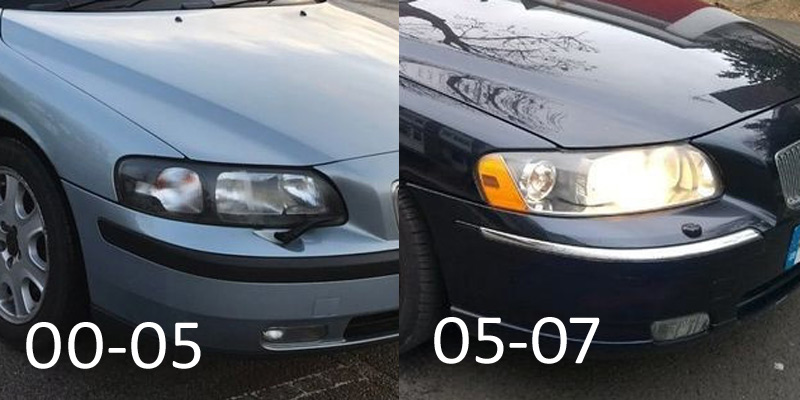
The S70, V70 and XC70 had a variety of different original radios fitted. The model numbers of the radios are printed on the front of the radio in the bottom right corner. Model number begin with HU- then have a three digit number to identify the radio model. Numbers begin with either a 6 or an 8 and require different speaker wiring depending on which it is.
HU-8XX radios supply audio to an amplifier in the car and the amplifier provides sound to all the speakers. A green power connector is present at the back of the radio and the audio is connected via a 6 pin DIN connector to the amplifier.
HU-6XX radios supply audio to an amplifier and also audio directly to some of the speakers in the car. A green power connector is at the back of the radio along with a grey connector for speaker connections and a 6 pin DIN connector for audio to the amplifier.
The below image shows the different connectors on the HU-8 and HU-6 radios.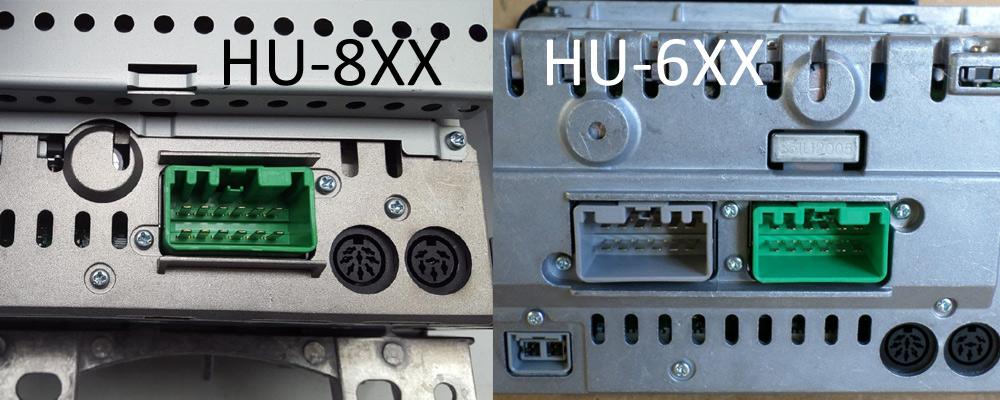
The 8 pin DIN connectors are used for the CD changer.
The first generation (B90) Dacia Sandero was not sold in the UK but was sold across mainland Europe and the rest of the world. In 2012 production in Romania for the European market ended and the new B52 Dacia Sandero was released, but production of the first generation continued for other markets, often sold under the Renault brand rather than Dacia.
Originally fitted with a single DIN radio or a blanking plate, a large replacement fascia panel is needed to fit a double DIN unit.
In 2020 the 3rd generation (BJI) of the Dacia Sandero was released.
The base model Access trim has no radio or speakers as standard, Speaker wiring is included into the drivers door but only reaches the passenger door pillar and is not included for either rear speaker at all. Fitting speakers to these models needs speaker wiring adding and put in conduit into the doors to protect the new speakers from water ingress. The front speakers are 165mm and the rears are 130mm. The radio blank is not a standard double DIN size and needs a fascia and ISO lead to fit one.
The Sandero Stepway is the same as the equivalent age Sandero, just with raised suspension and plastic 'offroad stye' body cladding.
Head Unit and Camera Install - Lexus SC430 (2007)
This install shows a Double Din Pioneer (SPH-DA130) Unit and reverse view camera fitted into a 2007 Lexus SC430 with an original factory fitted Mark Levinson radio.
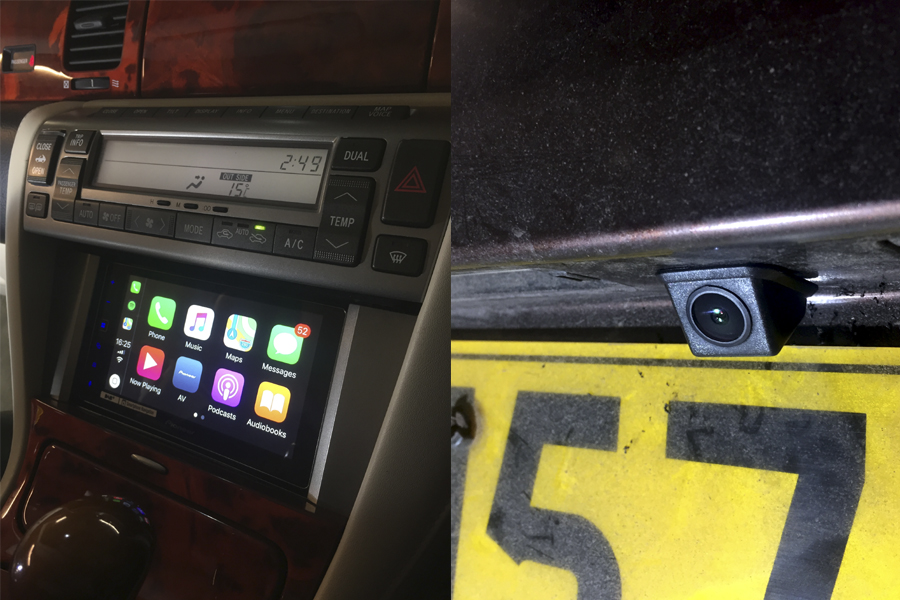
Products Used
HU-PIO-SPH-DA130D - Pioneer DA130DAB - Easy to use double DIN touchscreen media player with easy smartphone connectivity.
23-048 - Mark Levinson Interface Kit - This interface kit allows the user to retain the full function of the original navigation system and climate controls, as well as being able to activate and control the original amplifier. PLEASE NOTE: This interface is not plug and play and should only be installed by an experienced technician.
24-032 - USB & 3.5mm AUX in extension cable - To extend the USB and 3.5mm jack sockets from back of the new head unit to the cars centre console.
50-985 - Lexus SC430 Single/ Double DIN Fascia - This fascia works both on single and Double DIN head unit installs for Lexus SC430 cars. The silver painted finish matches nicely with the existing head unit colour.
70-923 - DAB Internal Windscreen Antenna - DAB antenna which subtly fixes to the window.
CA-9401 - Universal Push Fit Camera - This camera fits perfectly on any under-hang surface such as just above a car number plate (as pictured)
2005 Nissan Serena Double DIN Installation
In this example we fitted a Pioneer FHX840 DAB Double DIN head unit to a 2005 Nissan Serena
Parts required for installation:
21-118 - Antenna Adapter
29-683 or 49-683 - Steering Wheel Controls
Remember to include 29 or 49 series patch lead
50-868 - Single/ Double DIN fascia
Connecting 29-683 behind the head unit
50-686 Fascia Fitted
Completed Installation
Please note: The standard reverse camera still functions on the top
The 2007 Model Mitsubishi Pajero (known as the Shogun in the United Kingdom and as the Montero in the USA) was the 4th and last generation of the large Mitsubishi 4x4.
Like previous generations it comes as both a short wheel base 3 door and a long wheel base 5 door.
Sales of the Pajero in Japan and the Shogun in the UK ended in 2019 with production continuing for Australia, Africa and the Middle East until 2021 with the final models being sold in 2022.
At launch the car could be ordered with a basic FM radio or a "Mitsubishi Multi Communication System" satellite navigation system (MMCS) and either radio could be specified with either the basic sound system with the radio driving the speakers or a 12 speaker "Rockford Acoustic Design" sound system with a Rockford Fosgate amplifier and a 10" subwoofer in the boot. These can be easily identified by a "Rockford Accoustic Design" label in the middle of the basic radio or at the top of the climate controls on models with satellite navigation. Please see below:
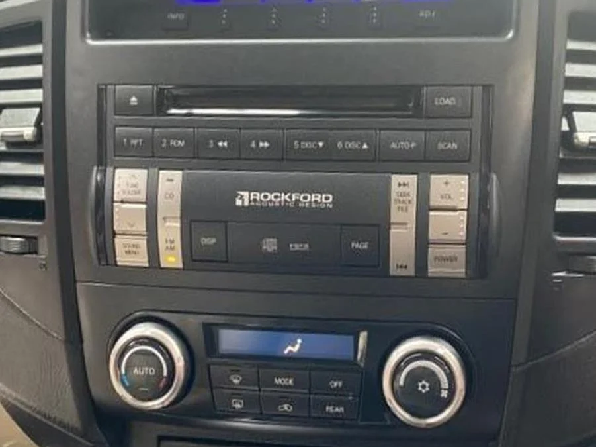

On cars without Rockford audio and a basic FM radio, use interface 29-681. If the car has Navigation without Rockford use interface 29-702.
Models with Rockford Acoustic Audio require an interface that sends a digital switch on to the amplifier, there is not currently an interface available for cars built before 2010 and the amplifier will have to be bypassed. Around 2010 the basic radio with Rockford was revised, with two white plugs (20 pin and 18 pin) as its main connections to the car. These can be changed using our interface 29-CTMT07. The MMCS system stayed with the older style grey plugs for a couple of years until a mild interior facelift in 2013 bought new radios to the car.
On cars with MMCS and Rockford built after 2010, some cars have the wiring loom terminating in the whiter plugs used on the basic system in the dashboard, with a wiring harness approximately 300mm in length converting the loom with the white plugs to the earlier type grey plugs. This is usually wrapped in harness tape and difficult to find, but should they be there (not on all vehicles) then the interface 29-CTMT07 can be used to change the radio with the harness extension removed.
The new radios of 2013 changed both the radios which then all used white plugs and changed how the Rockford system works. The majority of facelift radios use a piano black fascia, compared to the earlier matt black. Lower specification models after 2013 come with an FM radio/CD player with Bluetooth audio, also found in the Outlander and L200/Triton, this was not available with Rockford Acoustic Sound, these can be changed with interface 29-681. The facelift navigation systems all use white plugs and can be quickly distinguished by them having a rotary control towards the top on both the left and right of the screen. Without Rockford, they require the 29-681 interface, like the earlier basic radio. If they have the Rockford Amplifier then they will use 29-CTMT09 interface.
Summary of possible steering wheel control and amplifier interfaces, and which radios they will work with:
29-681 Radios without Rockford Acoustic Sound: Basic FM Radio 2007-2013, Bluetooth FM Radio 2013 - 2019, Facelift Navigation 2013-2019.
29-702 MMCS without Rockford Acoustic Sound: MMCS Navigation 2007 - 2013
29-CTMT07 Pre-Facelift radios with Rockford Acoustic Sound and White plugs: Basic FM Radio with Rockford 2010-2013, MMCS Navigation with Rockford and white plugs in dashboard (2010-2013 (check before ordering)
29-CTMT09 Post Facelift radios with Rockford Acoustic Sound: Facelift Navigation with Rockford 2013-2019
The Honda Shuttle was a rebadged 1st generation Honda Odyssey for the European market. Not to be confused with the earlier 85-94 Honda Civic Shuttle.
Mercedes SL R230
Production years 2002 - 2011
The Mercedes SL had a facelift after 2004. The dashboard changed and this affects the way a new radio is fitted.
The older pre facelift models had a single large dashboard panel that surrounded the radio and the climate controls. The later models had a split panel that surrounded the climate controls but the radio was wider and filled the top half.
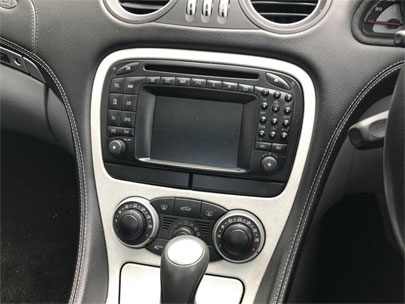
The above picture shows the pre facelift dashboard, see how the original silver dashboard panel surrounds both the climate controls and the radio.(use facia 50-658)
The below picture is of a post facelift car, the dashboard panel ends above the climate control, the radio is larger. (use facia 50-880)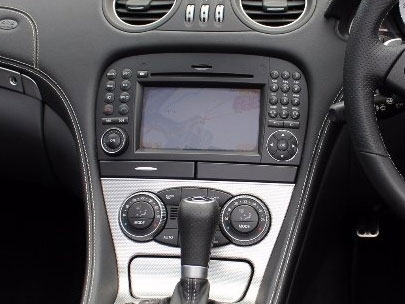
Mercedes SL cars have fibre optic audio systems. The head unit communicates to the amplifier and tuner module on a fibre optic network. Because of this there are no plug and play adapters, the CANbus steering control interfaces need to be hard wired and the audio amplifier needs to be bypassed.
After changing the radio, the clock cannot be adjusted.
Below is information describing the differences between the 2004-08 and 2009-11 models Mercedes SLK R171 and the different audio equipment options in the cars. This information is important to correctly identify the model and spec of the car so that the correct parts can be used for fitting an aftermarket stereo upgrade.
The SLK R171 was launched in 2004, at the end of 2008 the car was facelifted, there are subtle changes to the exterior styling which can make identifying the pre and post facelift cars easy.
There were also changes to the audio equipment and the steering wheel control buttons. The audio changes are important as the wiring and setup of the audio system components determine the parts that are needed when fitting a new radio.
The image below shows the facelift changes.
2004 - 2008 pre facelift cars had two main original radio options, the basic Mercedes NTG1 radio and the upgraded Mercedes COMAND APS NTG1 navigation radio.
The basic NTG1 radio is a traditional style radio, all components are within the double din unit in the dashboard and there is a quadlock connector at the back of the radio.
The COMAND (Cockpit Management and Data System) APS NTG1 is broken down into three separate components. The head unit in the dashboard with the screen, an Audio Gateway (AGW) module that contains the radio tuner, basic audio amplifier and MOST controller, and the navigation processor. These components are linked using a MOST (Media Orientated System Transport) fibre optic network. Because of this type of set up changing a radio is more complicated, a fibre optic interface is needed to integrate audio from a new radio with the fibre optic, also there is no quadlock connector in the dashboard behind the head unit so the new radio needs to be hard wired into the car.
Both the basic NTG1 and the COMAND APS NTG1 radio options have the added option of an upgraded harman/kardon amplified audio system. The amplifier is connected to the original radio system via the MOST fibre optic network so a special fibre optic interface is required to integrate a new radio with the original amplifier.
The harman/kardon amplified systems can be identified by harman/kardon branding on the speaker grills.
Below are images of the basic NTG1 radio, the COMAND APS NTG1 radio and the harman/kardon branding on the speaker grills.
2009 - 2011 facelift cars have similar equipment options to the pre facelift model with basic and navigation radio options and the option for a harman/kardon amplifier.
The NTG1 radios have been updated to the NTG2 version, the basic radio now with a colour screen instead of the LCD screen. There is also different wiring in the quadlock connector that is used at the back of the radio.
The COMAND APS NTG2 radio has been updated to be a more cost efficient, integrated unit with simplified wiring compared to the COMAND APS NTG1 system. Rather than having three separate units, all the components are in the double din size head unit in the dashboard. The COMAND APS NTG2 uses the same quadlock connector and wiring as the basic NTG2 version making changing the radio easy compared to the older version.
And like the pre facelift cars, the facelift cars also have the option of a harman/kardon amplified audio system. The harman/kardon amplifier has a MOST fibre optic connection to the head unit, a special fibre optic interface is need when fitting a new aftermarket stereo.
Below are images of the NTG2 and COMAND APS NTG2 radios. The branding of the harman/kardon amplifier on the speaker grills is the same as the pre facelift model.
Below is information describing the differences between the 2004-08 and 2009-11 models Mercedes SLK R171 and the different audio equipment options in the cars. This information is important to correctly identify the model and spec of the car so that the correct parts can be used for fitting an aftermarket stereo upgrade.
The SLK R171 was launched in 2004, at the end of 2008 the car was facelifted, there are subtle changes to the exterior styling which can make identifying the pre and post facelift cars easy.
There were also changes to the audio equipment and the steering wheel control buttons. The audio changes are important as the wiring and setup of the audio system components determine the parts that are needed when fitting a new radio.
The image below shows the facelift changes.
2004 - 2008 pre facelift cars had two main original radio options, the basic Mercedes NTG1 radio and the upgraded Mercedes COMAND APS NTG1 navigation radio.
The basic NTG1 radio is a traditional style radio, all components are within the double din unit in the dashboard and there is a quadlock connector at the back of the radio.
The COMAND (Cockpit Management and Data System) APS NTG1 is broken down into three separate components. The head unit in the dashboard with the screen, an Audio Gateway (AGW) module that contains the radio tuner, basic audio amplifier and MOST controller, and the navigation processor. These components are linked using a MOST (Media Orientated System Transport) fibre optic network. Because of this type of set up changing a radio is more complicated, a fibre optic interface is needed to integrate audio from a new radio with the fibre optic, also there is no quadlock connector in the dashboard behind the head unit so the new radio needs to be hard wired into the car.
Both the basic NTG1 and the COMAND APS NTG1 radio options have the added option of an upgraded harman/kardon amplified audio system. The amplifier is connected to the original radio system via the MOST fibre optic network so a special fibre optic interface is required to integrate a new radio with the original amplifier.
The harman/kardon amplified systems can be identified by harman/kardon branding on the speaker grills.
Below are images of the basic NTG1 radio, the COMAND APS NTG1 radio and the harman/kardon branding on the speaker grills.
2009 - 2011 facelift cars have similar equipment options to the pre facelift model with basic and navigation radio options and the option for a harman/kardon amplifier.
The NTG1 radios have been updated to the NTG2 version, the basic radio now with a colour screen instead of the LCD screen. There is also different wiring in the quadlock connector that is used at the back of the radio.
The COMAND APS NTG2 radio has been updated to be a more cost efficient, integrated unit with simplified wiring compared to the COMAND APS NTG1 system. Rather than having three separate units, all the components are in the double din size head unit in the dashboard. The COMAND APS NTG2 uses the same quadlock connector and wiring as the basic NTG2 version making changing the radio easy compared to the older version.
And like the pre facelift cars, the facelift cars also have the option of a harman/kardon amplified audio system. The harman/kardon amplifier has a MOST fibre optic connection to the head unit, a special fibre optic interface is need when fitting a new aftermarket stereo.
Below are images of the NTG2 and COMAND APS NTG2 radios. The branding of the harman/kardon amplifier on the speaker grills is the same as the pre facelift model.
re-badged city
HOW TO TELL IF MY VEHICLE IS DIGITALLY AMPLIFIED?
There are a few ways to identify if you vehicle is digitally amplified
Check the boot area and the drivers-side side panel, your vehicle should have either a round port-hole or a speaker.
Porthole = NON AMPLFIED Speaker = DIGITALLY AMPLIFIED
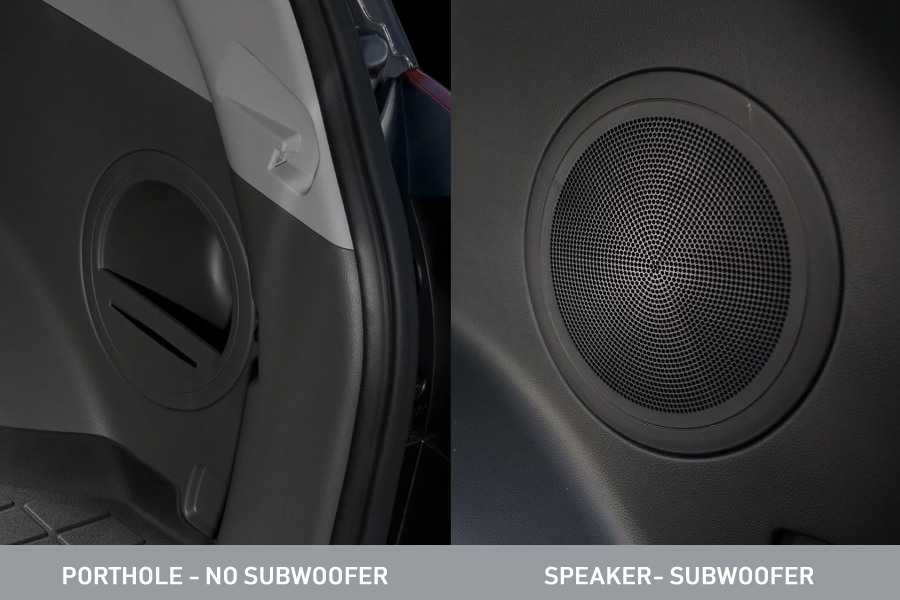
It is also mentioned that if your Sportage has an OEM factory fitted GPS satellite navigation unit then you vehicle has a premium sound system.
These were placed in different Spec Kia Sportage vehicles, PREMIUM SOUND usually consists of a subwoofer and amplifier. If your vehicle has 4 or more speakers then it is also an identifier of having a PREMIUM SOUND system installed.
MODELS VARIENTS OF THE SPORTAGE III WITH FACTORY SAT NAV INCLUDE:
- 3 S/NAV
- 4
- Alpine Edition
- Axis Edition
- Black Edition
- CRDI3 (S/S)
- KX3 S/NAV
- KX4 S/NAV
If you are still unsure of what products you need please contact our technical team at [email protected]
COMAND APS NTG 6 (MBUX)
The NTG 6 Comand head unit debuted in the Sprinter (W907/910) 2019 onwards. This Comand unit features a new MBUX infotainment system which consists of a standard 7-inch touchscreen or a 10.25-inch as an optional extra. Other optional extras with the MBUX include voice control and a geocoded map system.
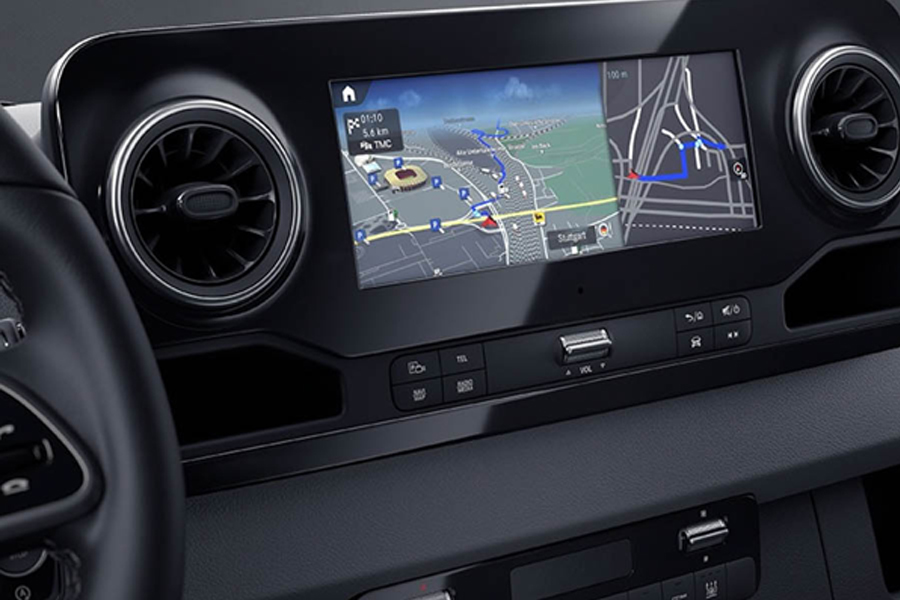
The Honda Stepwgn is produced for the Japanese domestic market.
The earlier RF built between 1996 and 1999 had a standard single DIN sized slot with a fixed pocket below. These models will need modification to the dashboard to fit a double DIN radio.
Later models feature a standard double DIN slot, either with an original single DIN radio and a pocket or with a full sized double DIN originally fitted.
The third generation "RG" Honda Stepwgn was built on an entirely new platform from the first two generations of "RF" Stepwgn, with a much more aerodynamic design and a lower floor. As before it was only released for the Japanese domestic market and came with a standard double DIN sized radio as standard so no new fascia is needed to install a double DIN.
The fourth generation "RK" Honda Stepwgn was only available in Japan, but has become a popular import to other right hand drive countries. As with previous generations, it comes with a standard double DIN sized radio, so no new double DIN fascia is required.
Be careful when removing the original radio fascia, they are fragile and are easily destroyed during removal.
Skoda Superb mk2
Production years 2008 - 2015
The mk2 Skoda Superb has three original radio options, the basic Skoda Swing radio, the mid range Skoda Bolero radio and the high end Skoda Columbus navigation radio.
The original radio will determine what parts are required for fitting a new aftermarket stereo.
The Columbus navigation radio is shaped like a standard Volkswagen radio and is based on the Volkswagen RNS510 navigation radio, because of this a Volkswagen radio fitting kit is needed to fit a new stereo.
The Swing and Bolero radios are bigger than the Columbus and take up more of the dashboard space, because of this an additional adapter panel is required to convert the dashboard to match a car that has the Columbus radio, this then allows the fitting of a new stereo.
The Nissan Terrano II was joint developed with Ford who sold a version called the Ford Maverick.
Sales began in 1993, with a basic single DIN radio fitted across the Nissan Terrano II, Mistral (JDM version) and Ford Maverick ranges. The Nissan enjoyed much higher sales than the Ford and by 1998 Ford had dropped the Maverick from their range, along with Nissan no longer selling the Mistral in Japan.
2000 saw a facelift to the Terrano, including a revised interior with two different radio types available. A single DIN radio with the hazard switch sat in the surround, and a larger set with the hazard switch integrated into the radio. If you car is fitted with this set then you will need to also find the fascia panel from the single DIN version, along with the hazard switch. We used to sell the fascia with part number 50-198, but it has been discontinued. The Nissan part number was 68470-0X801.
The hazard switch is shared with the Nissan Primera P11).
The MAN TGE is a badge engineered version of the 2nd generation Volkswagen Crafter.
Installation depth issues
Due to the shallow depth behind the 2017 onwards VW Crafter, there is only space for a Single din radio chassis or a slim chassis/ modular head unit (maximum mounting depth for the aftermarket radio of 55mm). These units must have the single din body relocated to the top of the monitor because in the crafter the single din hole is at the top, the lower part is not din depth and would not allow you to mount a traditional double din radio.
Careful attention needs to be paid to the radio that is to be fitted and the modifications that may be required, either to the fascia kit or the vehicle.
We strongly recommend the installation is done by an experienced car audio technician only
See the image below that shows the available space behind the original radio
Launched at the end of 2012, the 4th generation Seat Toledo was sold with Volkswagen style 'RCD and RNS' radios for the first few years. In 2016 the radios changed to "MIB2" style radios, also found on the same aged Ibiza and Leon, these require different parts to the earlier radios to change.
In 2018 UK sales of the Toledo ended due to low demand, production continued for other markets into 2019 with the last cars being sold in 2020. The Toledo did not receive a direct replacement.
The Ford Transit Custom started production in late 2012 and was available with a 2.2 diesel engine that performed to Euro 5 emissions standards.
In September 2016, to coincide with the introduction of the Euro 6 emissions standards the Transit Custom saw a new 2.0 'Panther' diesel engine and some major revisions under the skin, despite looking outwardly very similar. This includes how the radio works and the connections on the back of it. Both models can have a basic radio without a display above which kept the same wiring between the two generations, versions with a screen need different parts to fit an aftermarket radio depending on when they were made.
Most Euro 5 models have a monochrome display above the radio and most Euro 6 have a colour display but there is some cross over between the two.
There is a couple ways to tell if your van is Euro 5 or Euro 6 compliant if you do not know the build date. Firstly if your engine is a 2.2 litre diesel then it is an earlier Euro 5 model, if it's a 2.0 litre diesel then it is Euro 6.
The next easiest way to check is the high level rear brake light, filament bulbs for Euro 5 and LEDs for Euro 6.
A major facelift in 2018 saw further revisions to the radio with the introduction of Ford SYNC 3 system to the Transit Custom.
The T6 Transporter replaced the T5 in 2015. Despite being on the same platform it features a new selection of Composition and Discovery radio options with the new style Volkswagen quadlock connector. In 2019 a major facelift to T6.1 spec changed the radios again and the door structure.
The Volkswagen Transporter had a major facelift in 2019 to T6.1 spec, with new radios and door structure, the upgrades available differ from the earlier T6 version.
Audi TT 8J mk2
Production years 2006-2014
The differences from the first to second generation Audi TT are easy to see. Updated vehicle styling and a larger than double din radio replaces the single din sized radio from the older model.
Many second generation TTs have the high end Bose amplified audio system, although many TTs don't have the Bose branded system, all second generation TTs have fully amplified audio systems, unlike other Audi cars like the A3 and A4 which have rear amplified systems as standard.
The amplifier in the TT is turned on with a 12V switch signal, cars with original navigation systems use a CANbus turn on signal for the amplifier instead. Using our CANbus steering control interface this will turn on the amplifier. It is also possible to change the amp turn on back to a 12V signal using VAG-COM VCDS.
Audi TT radio wiring diagram.
The DSP EIN position is the amplifier turn on signal.
Although the front speakers are marked on the diagram, the wires are not present in the vehicle.
High Performance/ Premium Sound Systems Examples
All Volvo C30/C70/S40 and V50 car models from 2004-2012 had 3 different sound systems:
1. Performance Sound (NON-AMPLIFIED)
This was fitted as the standard sound system for most of these Volvo Models. Although it had a couple of variations in its model years, it typically consisted of a standard 6 or 8 speaker set up system
2. High Performance Sound (Amplified)
This was fitted both as standard on Higher Spec Volvo models and as an optional upgrade. An easy way to tell if your vehicle is fitted with this system is when the radio powers up it will show on the radio display as 'HIGH PERFORMANCE SOUND'
3. Premium Sound (Amplified) Either DYNAUDIO or DOLBY PRO LOGIC II
This was fitted as an optional upgrade. An easy way to tell if your vehicle is fitted with this system is when the radio powers up it will show on the radio display as PREMIUM SOUND' This sound system is easier to identify as their will usually be a DYNAUDIO badge on some of the sound equipment. For E.G. On top of the centre speaker above the radio (Centre Dashboard)
Below are some examples of the sound systems installed on C30 and C70 (2007-2013) car models
Volvo S60, V70 and XC70, 2000 - 2007 second generation.
The Volvo V70 and XC70 second generation was released in 2000. In 2005 they received a facelift which included styling changes to the dashboard. Also, the headlight styling was changed, this makes identifying the face lift models easy.
The correct model year and radio model is important to know to make sure the correct parts are chosen for an installation.
Below is an image of the 2000 - 2005 pre facelift and 2005 - 2007 post facelift dashboards. Note that the 05-07 car has an extra piece of trim surrounding the radio and climate controls. This trim is often silver or wood effect.
Below is an image showing the styling differences between the headlights. The main noticeable difference is that older models had clear plastics over the lights, whereas the facelift cars have orange plastics over the indicator lights. The pictures are of a V70, but the same applies to the S60 and XC70.
The S70, V70 and XC70 had a variety of different original radios fitted. The model numbers of the radios are printed on the front of the radio in the bottom right corner. Model number begin with HU- then have a three digit number to identify the radio model. Numbers begin with either a 6 or an 8 and require different speaker wiring depending on which it is.
HU-8XX radios supply audio to an amplifier in the car and the amplifier provides sound to all the speakers. A green power connector is present at the back of the radio and the audio is connected via a 6 pin DIN connector to the amplifier.
HU-6XX radios supply audio to an amplifier and also audio directly to some of the speakers in the car. A green power connector is at the back of the radio along with a grey connector for speaker connections and a 6 pin DIN connector for audio to the amplifier.
The below image shows the different connectors on the HU-8 and HU-6 radios.
The 8 pin DIN connectors are used for the CD changer.
The Volvo S90 and V90
The Honda Vigor was also sold as the Acura Vigor in North America between 1990 and 1994.
MERCEDES V-CLASS (AKA VITO OR VIANO) W447 (2014 ONWARDS)
The 3rd generation V-CLASS (also known as the Vito or Viano)
The Vauxhall Viva was based on the GM Korea Chevrolet Spark. In mainland Europe it is known as the Opel Karl.
It was released in 2015, and received a very mild facelift in 2017 when the Viva Rocks was introduced and uses a very slightly different radio fascia from this facelift onwards. These can be differentiated by the amount of bars between the air vents, under the hazard switch, please check before ordering your
Models built between 2015 and 2017 have three bars between the air vents under the hazard switch:
Models built between 2017 and 2019 have two bars:
The Toyota Voltz is a rebadged version of the Pontiac Vibe (which itself is a restyled Toyota Matrix) produced for right hand drive markets with the majority of production being sold in Japan.
The Voltz differs from the Pontiac Vibe by using the interior of the Toyota Matrix, and so shares the basic Toyota shaped radio rather than the requiring a specific fascia like the Pontiac Vibe, although some versions do still have the General Motors antenna connections and will need an adapter to fit an after market radio.
The Holden Commodore VE, and its badge engineered versions the Vauxhall VXR8 and the Pontiac G8, have the climate controls integrated into the original radio.
To replace the original radio we have kit FK-559 which includes new dual zone automatic climate controls built into the new radio fascia with a digital display. This is will only fit cars with original dual zone climate control - either manual or automatic - and won't fit cars with original single zone climate control. We do not have a solution for cars with original single zone climate control.
Please see below for examples of original single zone and dual zone climate controls:


Jeep Wrangler
Production years 2013 - 2018
Jeep Wrangler cars made from 2013-2018 often have an upgraded audio system.
Most cars have an additional amplifier in the rear of the car powered by an Alpine amplifier, some cars have a fully upgraded Alpine system with Alpine speakers, subwoofer and amplifier.
Very few cars have a basic non amplified audio system with no additional subwoofer.
The very basic audio system is the same as older model Wrangler cars and other Jeep and Chrysler cars, the amplifier is turned on by a CANbus signal. Any models with an upgraded audio system use a different data turn on signal for the amplifier. When choosing radio fitting parts from our website, be careful to select the correct original equipment option.
The third generation is codenamed G01 and was unveiled in June 2017. Technology is shared with the BMW 5 Series (G30), such as gesture control (optional), LED exterior and interior lighting, and the BMW iDrive 6.0 system with a 12.5-inch touch-screen monitor for navigation systems.
Towards the end of 2019, the BMW X3 (G01) and X4 (G02) received an infotainment upgrade in the form of the current OS 7.0 (iDrive 7)
BMW ID7 or MGU (Media Graphic Unit) is the 7th Generation of the BMW iDrive Systems. Introduced in 2018 with the X5 (G05) and 8-Series (G15) , The display and menus were adapted to the new system implementing a new iDrive interface (ID7). It consists of 5 widgets arranged on the left side of the screen. The interface is designed mostly for touch and gesture operation.

The ID7 Interface Setup consists of 5 widgets arranged on the left side of the screen (Pictured Above)

The ID7 features a screen of 10.25" or 12.3" diagonal, depending on the vehicle, and a redesigned iDrive Touch Controller.
Compatibility
The BMW ID7 or MGU (Media Graphic Unit) were introduced into the following BMW models
| 3-Series (G20) | 09/2018 - Present | ||
| 7-Series (G11/G12 Facelift) | 2020 - Present | ||
| 8-Series (G14/G15) | 09/2018 - Present | ||
| X3 (G01) | 2020 - Present | ||
| X5 (G05) | 09/2018 - Present | ||
| X7 (G07) | 2018 - Present | ||
| Z4 (G29) | 09/2018 - Present |
BMW X5 E53
Production years 2000 - 2006
The E53 is the first generation of the X5 model line.
There are two types of radios originally fitted to the BMW X5 E53, standard and navigation. The audio system in the car is wired differently depending on which type of radio is originally fitted.
Cars with a standard basic radio have a more traditional setup. There is a quadlock connector at the back of the radio in the dashboard (some very early models have a round pin BMW connector, these models are rare) and the radio supplies audio directly to the speakers. Installations on these cars are straight forward, using adapters at the back of the radio to fit either a new stereo or a handsfree kit.
Cars with the navigation radios have just a screen in the dashboard, other components of the audio system are located elsewhere in the car. The tuner module is under the boot floor next to the battery, the navigation module and cd changer is in the rear left quarter panel, often there is also an audio amplifier in the rear left quarter panel too.
Installations in these cars are more complicated, extensions need to be run from the rear to the front.
The navigation radios also have different fittings into the dashboard, brackets need to be fixed into the dashboard in order to fit a new stereo. We have a special kit for this supplied with fitting instructions.
There are two types of amplifiers fitted to BMW X5 cars, one known as a Power Amplifier is a traditional amplifier. It is switches on by a +12V signal (this is the same signal as the antenna turn on) and it receives a standard audio signal from the radio. New radios can be easily integrated into these systems without the need for special adapters or interfaces.
The other type of amplifier is the DSP (Digital Signal Processing) Amplifier. These amplifiers are turned on by a data signal on the cars I-Bus data network, when the original radio is removed the amplifier can no longer be switched on. These amplifiers need to be bypassed in order to fit a new stereo.
Below is an image of the Power Amplifier.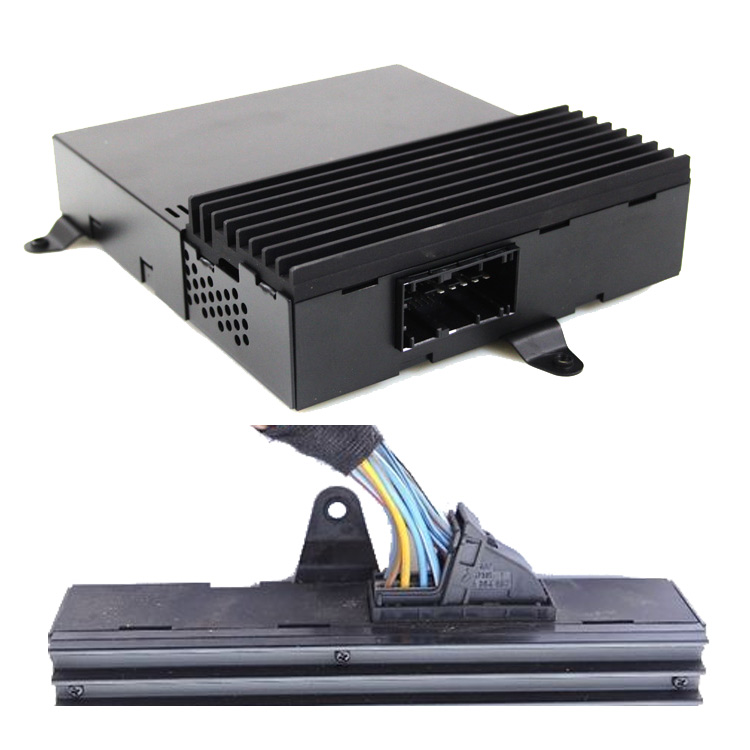
Below is an image of the DSP amplifier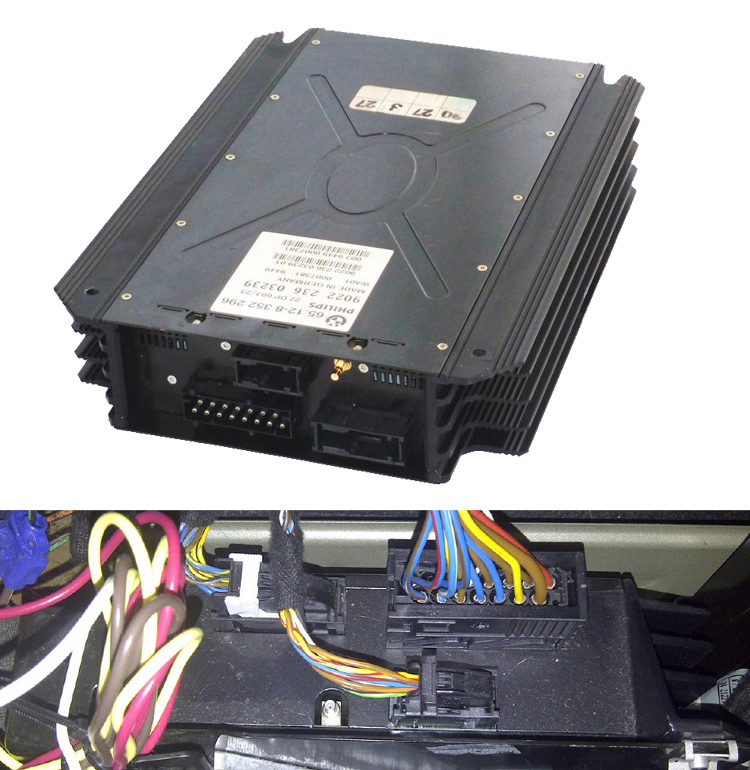
The two amplifiers can be differentiated by the style of the heatsink fins and connectors used. The Power amp uses one large connector with a locking latch, the DSP amp uses three connectors, one large round pin connector and two smaller connectors with locking latches.
The BMW X7 is a full-sized luxury sport utility vehicle manufactured by BMW. It is BMW's flagship SUV, and the largest and most expensive in its line-up. It was officially unveiled on October 17, 2018, with pre-orders being taken online. The X7 has been available at dealers since March 2019.
Standard equipment includes Vernasca leather, four-zone climate control, iDrive 7.0, Adaptive LED headlights, wireless charging and electrically adjustable and heated three row seating.
The instrument cluster features a camera to ensure the driver is paying attention to the road while autonomous functions are active and allows the driver to take their hands off the steering wheel for up to one minute. Additionally it has a Optional head up display that in many other vehicles it normally fits just the speed, however because of the size of the BMW headup display; it also shows a clear map with navigation instructions, rendering the information center somewhat pointless to the driver.
BMW ID7 or MGU (Media Graphic Unit) is the 7th Generation of the BMW iDrive Systems. Introduced in 2018 with the X5 (G05) and 8-Series (G15) , The display and menus were adapted to the new system implementing a new iDrive interface (ID7). It consists of 5 widgets arranged on the left side of the screen. The interface is designed mostly for touch and gesture operation.

The ID7 Interface Setup consists of 5 widgets arranged on the left side of the screen (Pictured Above)

The ID7 features a screen of 10.25" or 12.3" diagonal, depending on the vehicle, and a redesigned iDrive Touch Controller.
Compatibility
The BMW ID7 or MGU (Media Graphic Unit) were introduced into the following BMW models
| 3-Series (G20) | 09/2018 - Present | ||
| 7-Series (G11/G12 Facelift) | 2020 - Present | ||
| 8-Series (G14/G15) | 09/2018 - Present | ||
| X3 (G01) | 2020 - Present | ||
| X5 (G05) | 09/2018 - Present | ||
| X7 (G07) | 2018 - Present | ||
| Z4 (G29) | 09/2018 - Present |
In Japan the Scion XB was sold as the Toyota bB or "big box".
The second generation Scion XB was released with less divisive looks than the first generation model. In Japan it is known as the Toyota Corolla Rumion and in Australia it was sold as the Toyota Rukus.
Volvo V70 and XC70, 2000 - 2007 second generation.
The Volvo V70 and XC70 second generation was released in 2000. In 2005 they received a facelift which included styling changes to the dashboard. Also, the headlight styling was changed, this makes identifying the face lift models easy.
The correct model year and radio model is important to know to make sure the correct parts are chosen for an installation.
Below is an image of the 2000 - 2005 pre facelift and 2005 - 2007 post facelift dashboards. Note that the 05-07 car has an extra piece of trim surrounding the radio and climate controls. This trim is often silver or wood effect.
Below is an image showing the styling differences between the headlights. The main noticeable difference is that older models had clear plastics over the lights, whereas the facelift cars have orange plastics over the indicator lights. The pictures are of a V70, but the same applies to the XC70.
The V70 and XC70 had a variety of different original radios fitted. The model numbers of the radios are printed on the front of the radio in the bottom right corner. Model number begin with HU- then have a three digit number to identify the radio model. Numbers begin with either a 6 or an 8 and require different speaker wiring depending on which it is.
HU-8XX radios supply audio to an amplifier in the car and the amplifier provides sound to all the speakers. A green power connector is present at the back of the radio and the audio is connected via a 6 pin DIN connector to the amplifier.
HU-6XX radios supply audio to an amplifier and also audio directly to some of the speakers in the car. A green power connector is at the back of the radio along with a grey connector for speaker connections and a 6 pin DIN connector for audio to the amplifier.
The below image shows the different connectors on the HU-8 and HU-6 radios.
The 8 pin DIN connectors are used for the CD changer.
Aerial/ Antenna Connection
On some Volvo XC90 models, there is no antenna connector behind the radio, it is in the roof at the rear of the car. If this is the case you will need to remove the rear roof lining and locate the cars antenna system and run a antenna adapter extension cable 21-148 along the left side of the roof trim.
If your Volvo XC90 already has an antenna connection behind the car radio then this part is not needed.
The Scion XD was badged as the Toyota Ist in Japan and as the Toyota Urban Cruiser (with a modified front fascia) in Europe.
Skoda Yeti
Production years 2009 - 2017
Skoda Yeti cars have two different shapes of original radios. The two different shapes can be a variety of different specification units from basic, to media and navigation units.
See the pictures below to help identify the radio shapes.
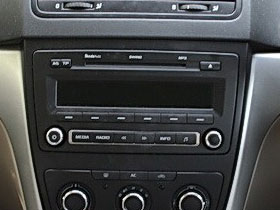
The above radio is wider and is the same as the Octavia radio.
The below radio is narrower and is the typical Volkswagen style radio.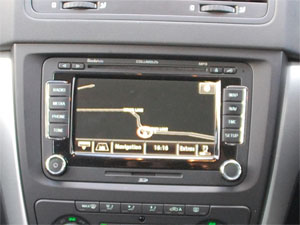
Check the size and shape of the original radio to make sure you are using the correct fascia adapter panel.
Earlier 2009-2014 models have the traditional 40 way quadlock connector at the rear of the radio. 2014 onward facelift cars have the newer style VW/Skoda radios with the new 52 way quadlock connectors. These new connectors have an extra insert section and large power and ground terminals.
The newer models can be identified by the styling of the buttons either side of the radio, they are aligned to the top edge of the radio screen and have a tapered design on the bottom buttons.
See the pictures below showing the newer style radios and the button styles highlighted. These radios still use the same style/shaped fascias as the above pictured older radios.
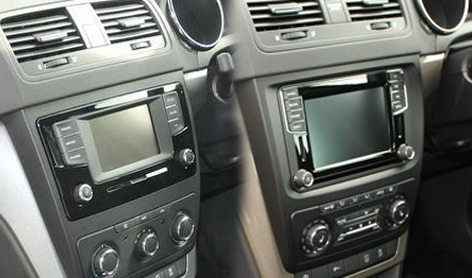
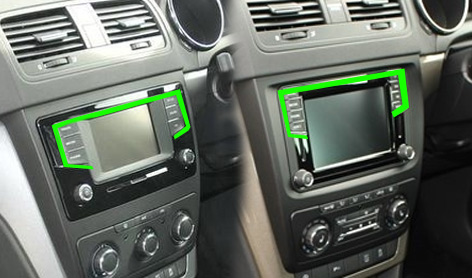
The BMW Z4 (G29) is a two-door roadster produced by German automobile manufacturer BMW. It was introduced in 2018 as a successor to the E89 Z4. As a fifth model in the lineage, the Z4 (G29) marks the return of the soft-top roof to the Z Series sports cars.
The Z4 is offered with a 10.25-inch display with the iDrive 7.0. The car is available with BMW ConnectedDrive services which allow for over-the-air updates for the navigation maps and operating system. The digital key feature allows the car to be unlocked and started with a smartphone, and access can be shared with other people. It is also available with a customisable, digital instrument cluster (called BMW Live Cockpit Professional).
BMW ID7 or MGU (Media Graphic Unit) is the 7th Generation of the BMW iDrive Systems. Introduced in 2018 with the X5 (G05) and 8-Series (G15) , The display and menus were adapted to the new system implementing a new iDrive interface (ID7). It consists of 5 widgets arranged on the left side of the screen. The interface is designed mostly for touch and gesture operation.

The ID7 Interface Setup consists of 5 widgets arranged on the left side of the screen (Pictured Above)

The ID7 features a screen of 10.25" or 12.3" diagonal, depending on the vehicle, and a redesigned iDrive Touch Controller.
Compatibility
The BMW ID7 or MGU (Media Graphic Unit) were introduced into the following BMW models
| 3-Series (G20) | 09/2018 - Present | ||
| 7-Series (G11/G12 Facelift) | 2020 - Present | ||
| 8-Series (G14/G15) | 09/2018 - Present | ||
| X3 (G01) | 2020 - Present | ||
| X5 (G05) | 09/2018 - Present | ||
| X7 (G07) | 2018 - Present | ||
| Z4 (G29) | 09/2018 - Present |